Quick filters:
Fly whisk Stock Photos and Images
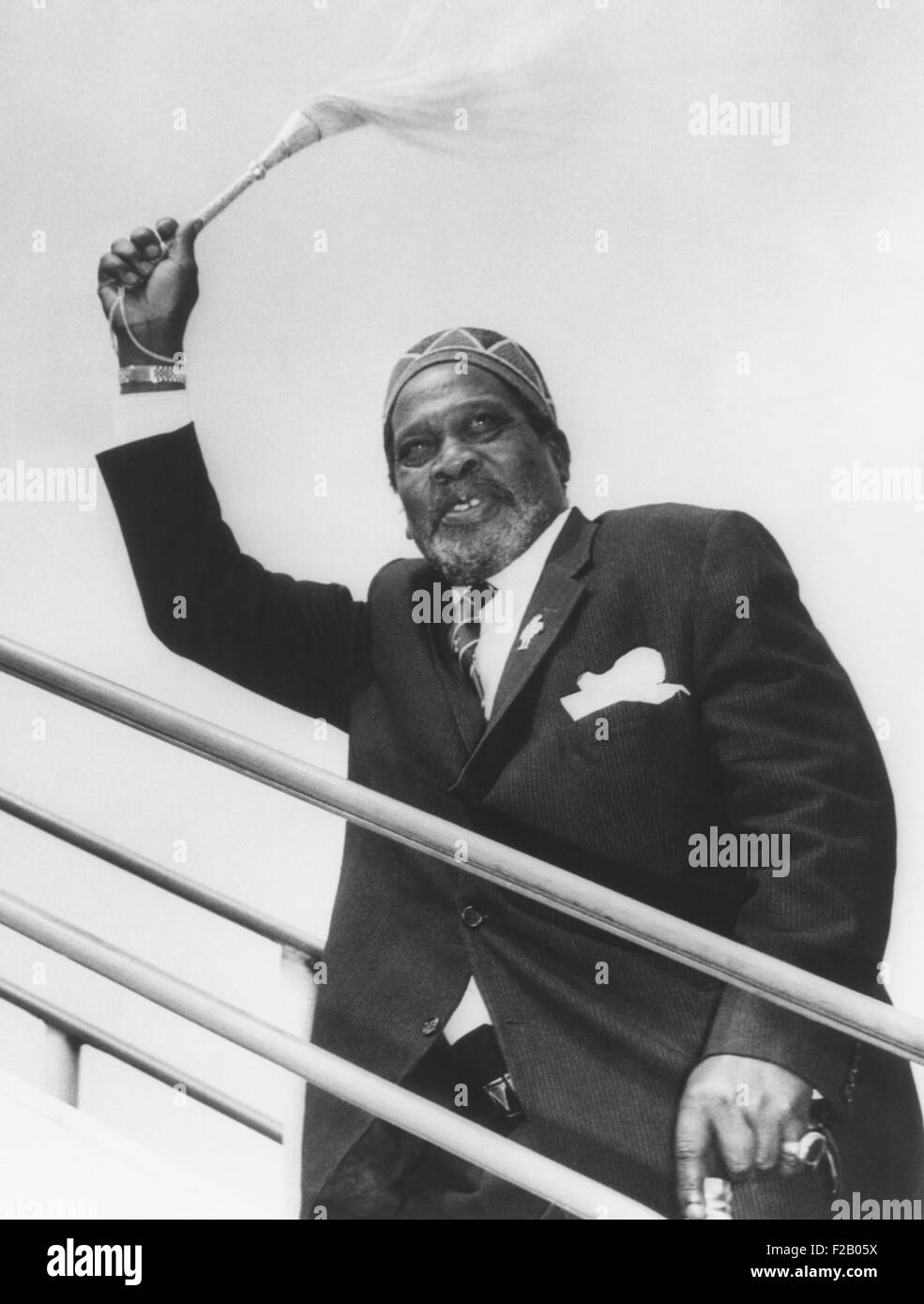 Jomo Kenyatta, President of Kenya, carried a fly-whisk, a mark of authority in Maasai society. During his rule, multi-ethnic Kenya moved toward one party rule, Kenya African National Union, and domination by his Kikuyu (Gikuyu) Tribe's elite. While it is the largest ethnic group in Kenya, it represented less than 25% of the population. (CSU 2015 9 688) Stock Photohttps://www.alamy.com/image-license-details/?v=1https://www.alamy.com/stock-photo-jomo-kenyatta-president-of-kenya-carried-a-fly-whisk-a-mark-of-authority-87522790.html
Jomo Kenyatta, President of Kenya, carried a fly-whisk, a mark of authority in Maasai society. During his rule, multi-ethnic Kenya moved toward one party rule, Kenya African National Union, and domination by his Kikuyu (Gikuyu) Tribe's elite. While it is the largest ethnic group in Kenya, it represented less than 25% of the population. (CSU 2015 9 688) Stock Photohttps://www.alamy.com/image-license-details/?v=1https://www.alamy.com/stock-photo-jomo-kenyatta-president-of-kenya-carried-a-fly-whisk-a-mark-of-authority-87522790.htmlRMF2B05X–Jomo Kenyatta, President of Kenya, carried a fly-whisk, a mark of authority in Maasai society. During his rule, multi-ethnic Kenya moved toward one party rule, Kenya African National Union, and domination by his Kikuyu (Gikuyu) Tribe's elite. While it is the largest ethnic group in Kenya, it represented less than 25% of the population. (CSU 2015 9 688)
 The king's fly-whisk, from the tomb of the pharaoh Tutankhamun, discovered in the Valley of the Kings, Thebes, Egypt Stock Photohttps://www.alamy.com/image-license-details/?v=1https://www.alamy.com/stock-photo-the-kings-fly-whisk-from-the-tomb-of-the-pharaoh-tutankhamun-discovered-16082315.html
The king's fly-whisk, from the tomb of the pharaoh Tutankhamun, discovered in the Valley of the Kings, Thebes, Egypt Stock Photohttps://www.alamy.com/image-license-details/?v=1https://www.alamy.com/stock-photo-the-kings-fly-whisk-from-the-tomb-of-the-pharaoh-tutankhamun-discovered-16082315.htmlRMARM2KT–The king's fly-whisk, from the tomb of the pharaoh Tutankhamun, discovered in the Valley of the Kings, Thebes, Egypt
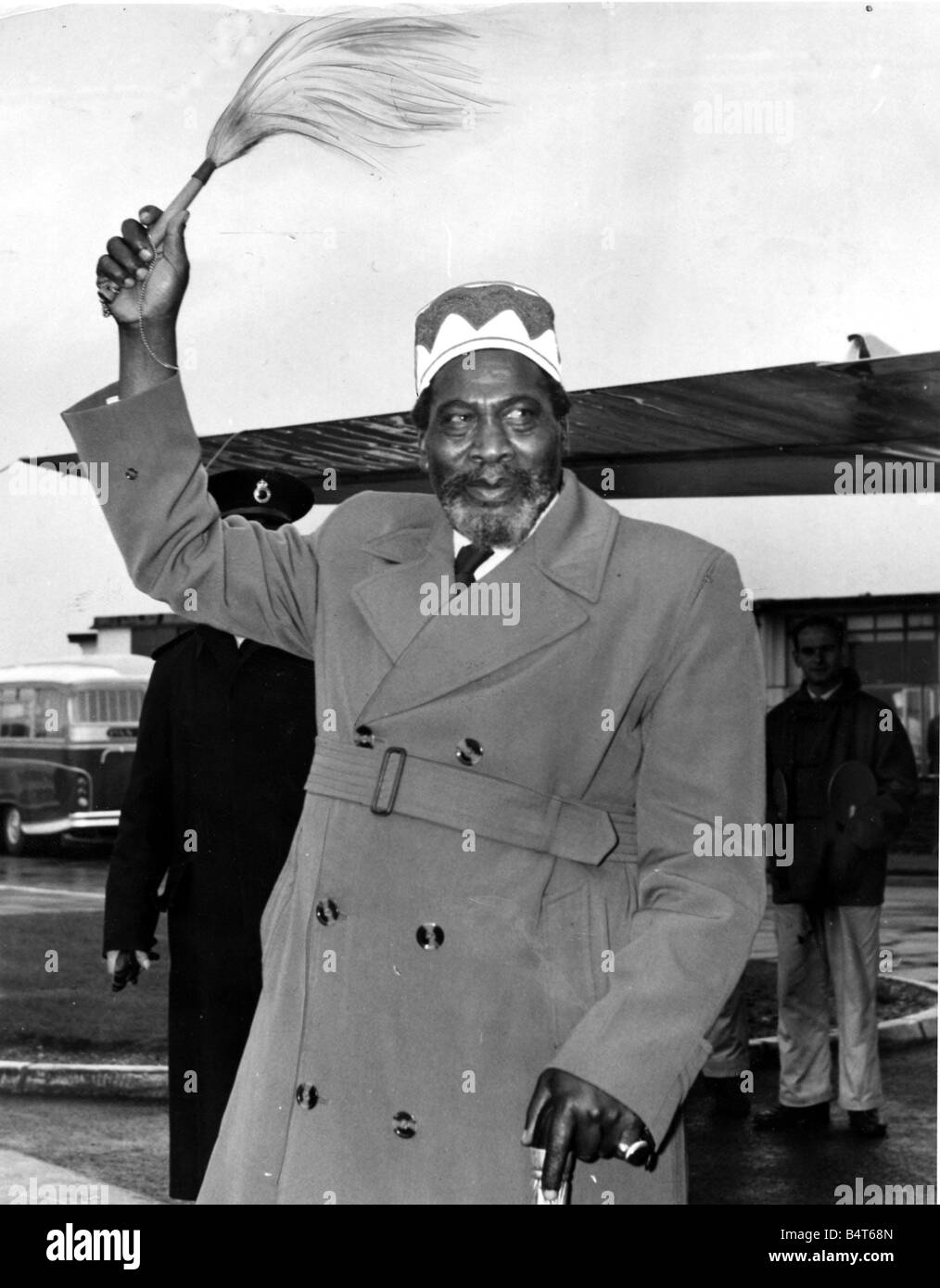 Kenya Jomo Kenyatta waves his symbol of office his fly whisk on his arrival at London airport 7th November 1961 Stock Photohttps://www.alamy.com/image-license-details/?v=1https://www.alamy.com/stock-photo-kenya-jomo-kenyatta-waves-his-symbol-of-office-his-fly-whisk-on-his-20200789.html
Kenya Jomo Kenyatta waves his symbol of office his fly whisk on his arrival at London airport 7th November 1961 Stock Photohttps://www.alamy.com/image-license-details/?v=1https://www.alamy.com/stock-photo-kenya-jomo-kenyatta-waves-his-symbol-of-office-his-fly-whisk-on-his-20200789.htmlRMB4T68N–Kenya Jomo Kenyatta waves his symbol of office his fly whisk on his arrival at London airport 7th November 1961
 Dan tribe woman dancing with a fly-whisk during a ceremony, Bafing, Gboni, Ivory Coast Stock Photohttps://www.alamy.com/image-license-details/?v=1https://www.alamy.com/dan-tribe-woman-dancing-with-a-fly-whisk-during-a-ceremony-bafing-gboni-ivory-coast-image247269267.html
Dan tribe woman dancing with a fly-whisk during a ceremony, Bafing, Gboni, Ivory Coast Stock Photohttps://www.alamy.com/image-license-details/?v=1https://www.alamy.com/dan-tribe-woman-dancing-with-a-fly-whisk-during-a-ceremony-bafing-gboni-ivory-coast-image247269267.htmlRMTA82D7–Dan tribe woman dancing with a fly-whisk during a ceremony, Bafing, Gboni, Ivory Coast
 Jomo Kenyatta holding a Bible and a fly whisk swearing the oath of allegiance when he first became Prime Minister of Kenya. Stock Photohttps://www.alamy.com/image-license-details/?v=1https://www.alamy.com/stock-photo-jomo-kenyatta-holding-a-bible-and-a-fly-whisk-swearing-the-oath-of-106923449.html
Jomo Kenyatta holding a Bible and a fly whisk swearing the oath of allegiance when he first became Prime Minister of Kenya. Stock Photohttps://www.alamy.com/image-license-details/?v=1https://www.alamy.com/stock-photo-jomo-kenyatta-holding-a-bible-and-a-fly-whisk-swearing-the-oath-of-106923449.htmlRMG5XNXH–Jomo Kenyatta holding a Bible and a fly whisk swearing the oath of allegiance when he first became Prime Minister of Kenya.
 sceptre with foil gold and stone inlay. This sceptre or fly-whisk is Sumerian Early Dynastic III 2600BC from the Royal Cemetery at Ur in Iraq. The cemetery at Ur included just over 2000 burials. Stock Photohttps://www.alamy.com/image-license-details/?v=1https://www.alamy.com/stock-photo-sceptre-with-foil-gold-and-stone-inlay-this-sceptre-or-fly-whisk-is-84978921.html
sceptre with foil gold and stone inlay. This sceptre or fly-whisk is Sumerian Early Dynastic III 2600BC from the Royal Cemetery at Ur in Iraq. The cemetery at Ur included just over 2000 burials. Stock Photohttps://www.alamy.com/image-license-details/?v=1https://www.alamy.com/stock-photo-sceptre-with-foil-gold-and-stone-inlay-this-sceptre-or-fly-whisk-is-84978921.htmlRMEX73DD–sceptre with foil gold and stone inlay. This sceptre or fly-whisk is Sumerian Early Dynastic III 2600BC from the Royal Cemetery at Ur in Iraq. The cemetery at Ur included just over 2000 burials.
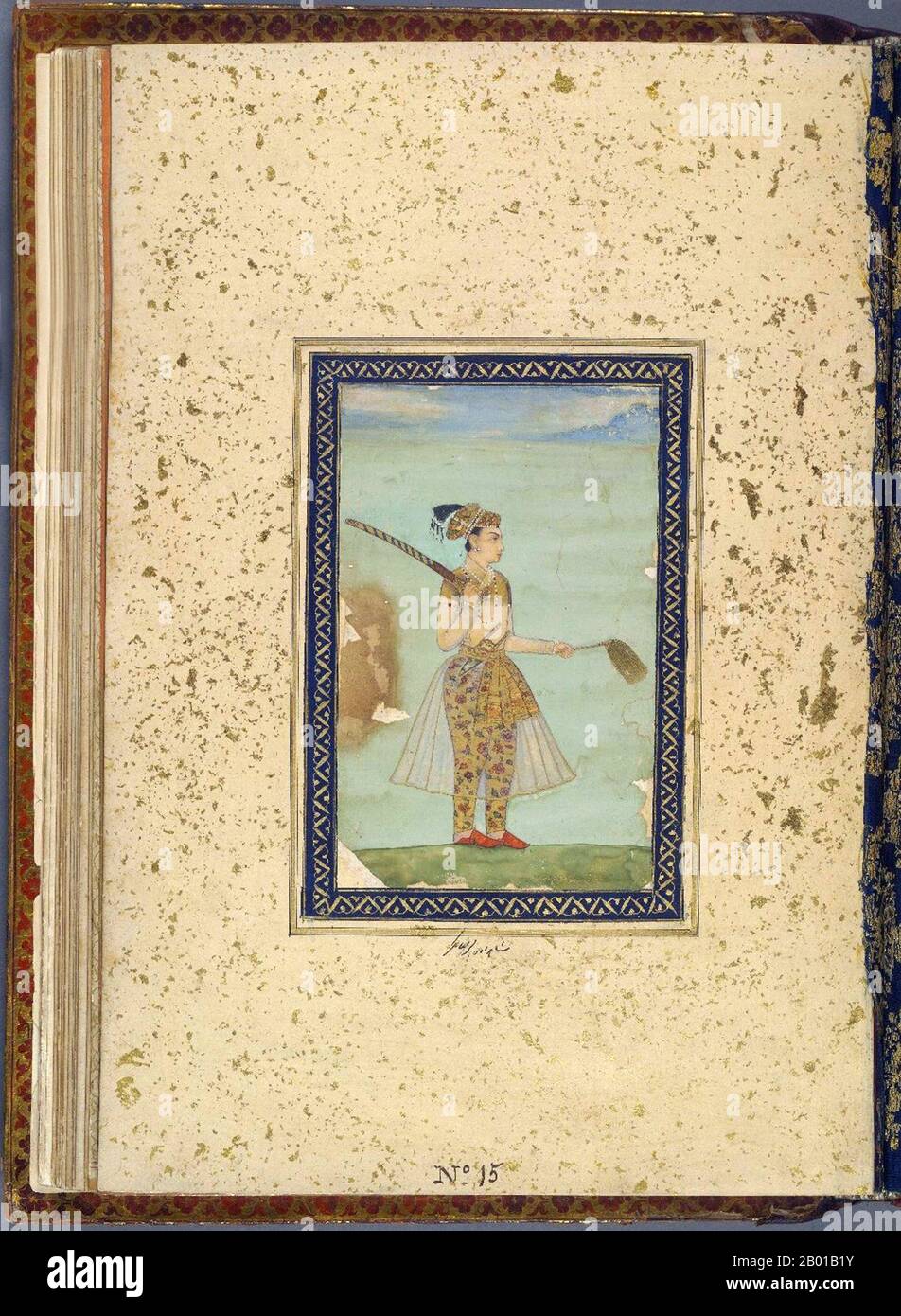 India: Mughal Royal Lineage - House of Timur, A prince holding a fly-whisk in one hand and a sword over his shoulder. Miniature painting, c. 1640. Mughal period miniature painting from an album featuring portraits of Timur the Great and his descendants, mid-17th century. Stock Photohttps://www.alamy.com/image-license-details/?v=1https://www.alamy.com/india-mughal-royal-lineage-house-of-timur-a-prince-holding-a-fly-whisk-in-one-hand-and-a-sword-over-his-shoulder-miniature-painting-c-1640-mughal-period-miniature-painting-from-an-album-featuring-portraits-of-timur-the-great-and-his-descendants-mid-17th-century-image344237991.html
India: Mughal Royal Lineage - House of Timur, A prince holding a fly-whisk in one hand and a sword over his shoulder. Miniature painting, c. 1640. Mughal period miniature painting from an album featuring portraits of Timur the Great and his descendants, mid-17th century. Stock Photohttps://www.alamy.com/image-license-details/?v=1https://www.alamy.com/india-mughal-royal-lineage-house-of-timur-a-prince-holding-a-fly-whisk-in-one-hand-and-a-sword-over-his-shoulder-miniature-painting-c-1640-mughal-period-miniature-painting-from-an-album-featuring-portraits-of-timur-the-great-and-his-descendants-mid-17th-century-image344237991.htmlRM2B01B1Y–India: Mughal Royal Lineage - House of Timur, A prince holding a fly-whisk in one hand and a sword over his shoulder. Miniature painting, c. 1640. Mughal period miniature painting from an album featuring portraits of Timur the Great and his descendants, mid-17th century.
 The king's fly whisk. The front shows the king hunting ostriches. Tukankhamen, by Christiane Desroches Noblecourt, page 92. Stock Photohttps://www.alamy.com/image-license-details/?v=1https://www.alamy.com/the-kings-fly-whisk-the-front-shows-the-king-hunting-ostriches-tukankhamen-by-christiane-desroches-noblecourt-page-92-image268845623.html
The king's fly whisk. The front shows the king hunting ostriches. Tukankhamen, by Christiane Desroches Noblecourt, page 92. Stock Photohttps://www.alamy.com/image-license-details/?v=1https://www.alamy.com/the-kings-fly-whisk-the-front-shows-the-king-hunting-ostriches-tukankhamen-by-christiane-desroches-noblecourt-page-92-image268845623.htmlRMWHAY9B–The king's fly whisk. The front shows the king hunting ostriches. Tukankhamen, by Christiane Desroches Noblecourt, page 92.
 Naga Attendant Holding a Fly Whisk Ikshvaku 3rd century India Andhra Pradesh Nagarjunakonda 23cm Limestone Stock Photohttps://www.alamy.com/image-license-details/?v=1https://www.alamy.com/stock-photo-naga-attendant-holding-a-fly-whisk-ikshvaku-3rd-century-india-andhra-51370778.html
Naga Attendant Holding a Fly Whisk Ikshvaku 3rd century India Andhra Pradesh Nagarjunakonda 23cm Limestone Stock Photohttps://www.alamy.com/image-license-details/?v=1https://www.alamy.com/stock-photo-naga-attendant-holding-a-fly-whisk-ikshvaku-3rd-century-india-andhra-51370778.htmlRMCYG3XJ–Naga Attendant Holding a Fly Whisk Ikshvaku 3rd century India Andhra Pradesh Nagarjunakonda 23cm Limestone
 Handle of whip or fly whisk, ca. mid-1st millennium B.C Stock Photohttps://www.alamy.com/image-license-details/?v=1https://www.alamy.com/stock-image-handle-of-whip-or-fly-whisk-ca-mid-1st-millennium-bc-162562552.html
Handle of whip or fly whisk, ca. mid-1st millennium B.C Stock Photohttps://www.alamy.com/image-license-details/?v=1https://www.alamy.com/stock-image-handle-of-whip-or-fly-whisk-ca-mid-1st-millennium-bc-162562552.htmlRMKCDA5C–Handle of whip or fly whisk, ca. mid-1st millennium B.C
 Burchell’s, Common or Plains, Zebra (Equus quagga burchellii). Grazing. Pioneer grazer. Tail in use as a fly whisk. Stock Photohttps://www.alamy.com/image-license-details/?v=1https://www.alamy.com/burchells-common-or-plains-zebra-equus-quagga-burchellii-grazing-pioneer-grazer-tail-in-use-as-a-fly-whisk-image181298122.html
Burchell’s, Common or Plains, Zebra (Equus quagga burchellii). Grazing. Pioneer grazer. Tail in use as a fly whisk. Stock Photohttps://www.alamy.com/image-license-details/?v=1https://www.alamy.com/burchells-common-or-plains-zebra-equus-quagga-burchellii-grazing-pioneer-grazer-tail-in-use-as-a-fly-whisk-image181298122.htmlRMMEXRGX–Burchell’s, Common or Plains, Zebra (Equus quagga burchellii). Grazing. Pioneer grazer. Tail in use as a fly whisk.
 Naga Attendant Holding a Fly Whisk, ca. 3rd century Stock Photohttps://www.alamy.com/image-license-details/?v=1https://www.alamy.com/stock-image-naga-attendant-holding-a-fly-whisk-ca-3rd-century-162451094.html
Naga Attendant Holding a Fly Whisk, ca. 3rd century Stock Photohttps://www.alamy.com/image-license-details/?v=1https://www.alamy.com/stock-image-naga-attendant-holding-a-fly-whisk-ca-3rd-century-162451094.htmlRMKC880P–Naga Attendant Holding a Fly Whisk, ca. 3rd century
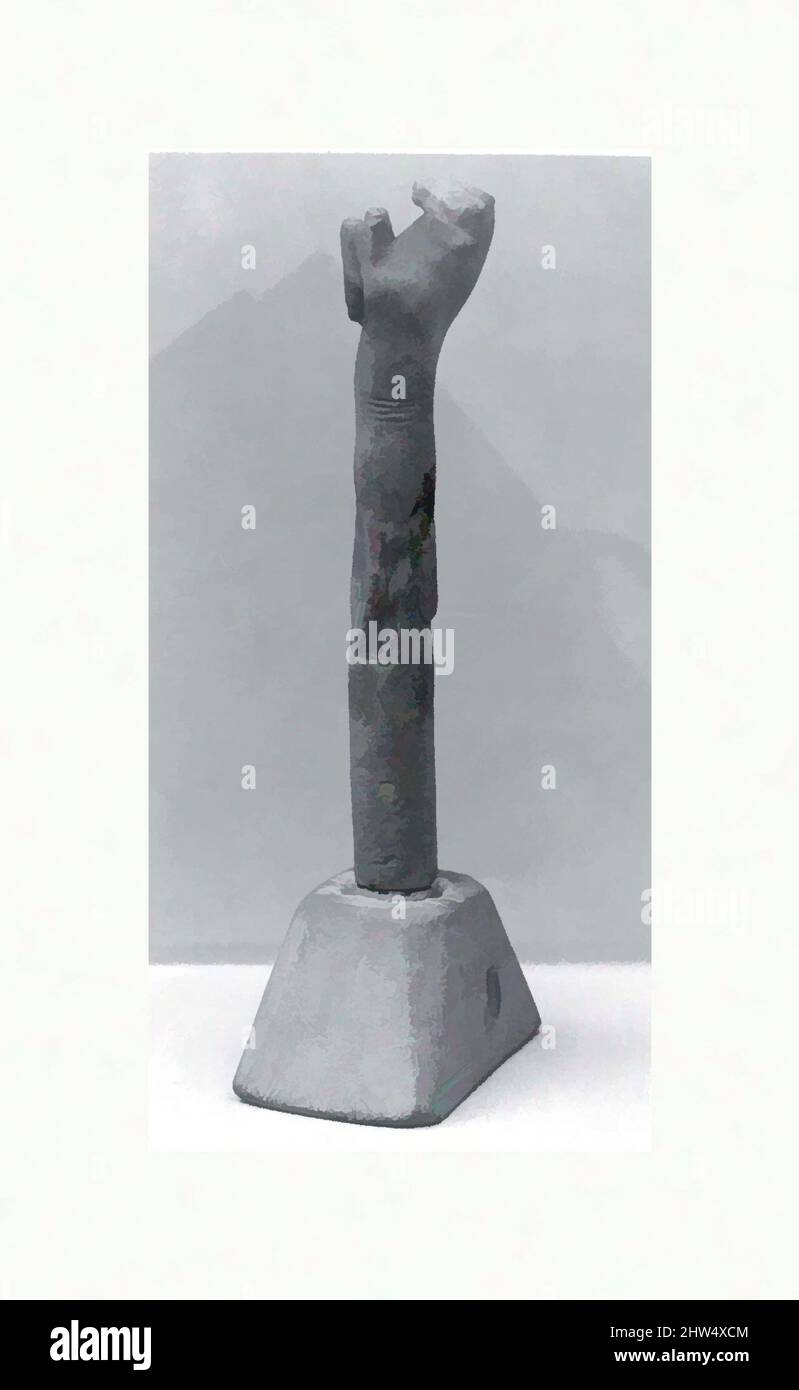 Art inspired by Handle of whip or fly whisk, ca. mid-1st millennium B.C., Egypt (?), Faience, green, 3.94 in. (10.01 cm), Faience-Implements, Classic works modernized by Artotop with a splash of modernity. Shapes, color and value, eye-catching visual impact on art. Emotions through freedom of artworks in a contemporary way. A timeless message pursuing a wildly creative new direction. Artists turning to the digital medium and creating the Artotop NFT Stock Photohttps://www.alamy.com/image-license-details/?v=1https://www.alamy.com/art-inspired-by-handle-of-whip-or-fly-whisk-ca-mid-1st-millennium-bc-egypt-faience-green-394-in-1001-cm-faience-implements-classic-works-modernized-by-artotop-with-a-splash-of-modernity-shapes-color-and-value-eye-catching-visual-impact-on-art-emotions-through-freedom-of-artworks-in-a-contemporary-way-a-timeless-message-pursuing-a-wildly-creative-new-direction-artists-turning-to-the-digital-medium-and-creating-the-artotop-nft-image462944516.html
Art inspired by Handle of whip or fly whisk, ca. mid-1st millennium B.C., Egypt (?), Faience, green, 3.94 in. (10.01 cm), Faience-Implements, Classic works modernized by Artotop with a splash of modernity. Shapes, color and value, eye-catching visual impact on art. Emotions through freedom of artworks in a contemporary way. A timeless message pursuing a wildly creative new direction. Artists turning to the digital medium and creating the Artotop NFT Stock Photohttps://www.alamy.com/image-license-details/?v=1https://www.alamy.com/art-inspired-by-handle-of-whip-or-fly-whisk-ca-mid-1st-millennium-bc-egypt-faience-green-394-in-1001-cm-faience-implements-classic-works-modernized-by-artotop-with-a-splash-of-modernity-shapes-color-and-value-eye-catching-visual-impact-on-art-emotions-through-freedom-of-artworks-in-a-contemporary-way-a-timeless-message-pursuing-a-wildly-creative-new-direction-artists-turning-to-the-digital-medium-and-creating-the-artotop-nft-image462944516.htmlRF2HW4XCM–Art inspired by Handle of whip or fly whisk, ca. mid-1st millennium B.C., Egypt (?), Faience, green, 3.94 in. (10.01 cm), Faience-Implements, Classic works modernized by Artotop with a splash of modernity. Shapes, color and value, eye-catching visual impact on art. Emotions through freedom of artworks in a contemporary way. A timeless message pursuing a wildly creative new direction. Artists turning to the digital medium and creating the Artotop NFT
 Howrah, West Bengal, India - 5th October, 2022 : Hindu Priest worshipping Goddess Durga with chamor, fly whisk fan. Ashtami puja aarati at night. Stock Photohttps://www.alamy.com/image-license-details/?v=1https://www.alamy.com/howrah-west-bengal-india-5th-october-2022-hindu-priest-worshipping-goddess-durga-with-chamor-fly-whisk-fan-ashtami-puja-aarati-at-night-image575208847.html
Howrah, West Bengal, India - 5th October, 2022 : Hindu Priest worshipping Goddess Durga with chamor, fly whisk fan. Ashtami puja aarati at night. Stock Photohttps://www.alamy.com/image-license-details/?v=1https://www.alamy.com/howrah-west-bengal-india-5th-october-2022-hindu-priest-worshipping-goddess-durga-with-chamor-fly-whisk-fan-ashtami-puja-aarati-at-night-image575208847.htmlRF2TBR0N3–Howrah, West Bengal, India - 5th October, 2022 : Hindu Priest worshipping Goddess Durga with chamor, fly whisk fan. Ashtami puja aarati at night.
 Inspired by Fly Whisk (chauri) with Design of Floral and Vegetal Motifs on the Handle, Indian, Mughal period, 1526–1858, late 18th century, Ivory and whale baleen, Made in Murshidabad, West Bengal, India, Asia, Jewelry & personal accessories, tools & equipment, length: 33 3/4 in. (85.7 cm, Reimagined by Artotop. Classic art reinvented with a modern twist. Design of warm cheerful glowing of brightness and light ray radiance. Photography inspired by surrealism and futurism, embracing dynamic energy of modern technology, movement, speed and revolutionize culture Stock Photohttps://www.alamy.com/image-license-details/?v=1https://www.alamy.com/inspired-by-fly-whisk-chauri-with-design-of-floral-and-vegetal-motifs-on-the-handle-indian-mughal-period-15261858-late-18th-century-ivory-and-whale-baleen-made-in-murshidabad-west-bengal-india-asia-jewelry-personal-accessories-tools-equipment-length-33-34-in-857-cm-reimagined-by-artotop-classic-art-reinvented-with-a-modern-twist-design-of-warm-cheerful-glowing-of-brightness-and-light-ray-radiance-photography-inspired-by-surrealism-and-futurism-embracing-dynamic-energy-of-modern-technology-movement-speed-and-revolutionize-culture-image459285103.html
Inspired by Fly Whisk (chauri) with Design of Floral and Vegetal Motifs on the Handle, Indian, Mughal period, 1526–1858, late 18th century, Ivory and whale baleen, Made in Murshidabad, West Bengal, India, Asia, Jewelry & personal accessories, tools & equipment, length: 33 3/4 in. (85.7 cm, Reimagined by Artotop. Classic art reinvented with a modern twist. Design of warm cheerful glowing of brightness and light ray radiance. Photography inspired by surrealism and futurism, embracing dynamic energy of modern technology, movement, speed and revolutionize culture Stock Photohttps://www.alamy.com/image-license-details/?v=1https://www.alamy.com/inspired-by-fly-whisk-chauri-with-design-of-floral-and-vegetal-motifs-on-the-handle-indian-mughal-period-15261858-late-18th-century-ivory-and-whale-baleen-made-in-murshidabad-west-bengal-india-asia-jewelry-personal-accessories-tools-equipment-length-33-34-in-857-cm-reimagined-by-artotop-classic-art-reinvented-with-a-modern-twist-design-of-warm-cheerful-glowing-of-brightness-and-light-ray-radiance-photography-inspired-by-surrealism-and-futurism-embracing-dynamic-energy-of-modern-technology-movement-speed-and-revolutionize-culture-image459285103.htmlRF2HK66RB–Inspired by Fly Whisk (chauri) with Design of Floral and Vegetal Motifs on the Handle, Indian, Mughal period, 1526–1858, late 18th century, Ivory and whale baleen, Made in Murshidabad, West Bengal, India, Asia, Jewelry & personal accessories, tools & equipment, length: 33 3/4 in. (85.7 cm, Reimagined by Artotop. Classic art reinvented with a modern twist. Design of warm cheerful glowing of brightness and light ray radiance. Photography inspired by surrealism and futurism, embracing dynamic energy of modern technology, movement, speed and revolutionize culture
 Ethiopian man holding a white, horse hair fly whisk during prayers in Jerusalem, Israel. In various African cultures, the fly whisk symbolizes solemni Stock Photohttps://www.alamy.com/image-license-details/?v=1https://www.alamy.com/ethiopian-man-holding-a-white-horse-hair-fly-whisk-during-prayers-in-jerusalem-israel-in-various-african-cultures-the-fly-whisk-symbolizes-solemni-image605373362.html
Ethiopian man holding a white, horse hair fly whisk during prayers in Jerusalem, Israel. In various African cultures, the fly whisk symbolizes solemni Stock Photohttps://www.alamy.com/image-license-details/?v=1https://www.alamy.com/ethiopian-man-holding-a-white-horse-hair-fly-whisk-during-prayers-in-jerusalem-israel-in-various-african-cultures-the-fly-whisk-symbolizes-solemni-image605373362.htmlRF2X4W3W6–Ethiopian man holding a white, horse hair fly whisk during prayers in Jerusalem, Israel. In various African cultures, the fly whisk symbolizes solemni
 Art inspired by 明中期 剔紅四季花卉紋拂塵, Fly whisk with the Flowers of the Four Seasons, Ming dynasty (1368–1644), 16th century, China, Carved red lacquer, L. (of handle) 11 1/4 in.(28.5 cm), Lacquer, This grouping of bamboo, chrysanthemums, orchids, and plum blossoms has rich symbolic meaning, Classic works modernized by Artotop with a splash of modernity. Shapes, color and value, eye-catching visual impact on art. Emotions through freedom of artworks in a contemporary way. A timeless message pursuing a wildly creative new direction. Artists turning to the digital medium and creating the Artotop NFT Stock Photohttps://www.alamy.com/image-license-details/?v=1https://www.alamy.com/art-inspired-by-fly-whisk-with-the-flowers-of-the-four-seasons-ming-dynasty-13681644-16th-century-china-carved-red-lacquer-l-of-handle-11-14-in285-cm-lacquer-this-grouping-of-bamboo-chrysanthemums-orchids-and-plum-blossoms-has-rich-symbolic-meaning-classic-works-modernized-by-artotop-with-a-splash-of-modernity-shapes-color-and-value-eye-catching-visual-impact-on-art-emotions-through-freedom-of-artworks-in-a-contemporary-way-a-timeless-message-pursuing-a-wildly-creative-new-direction-artists-turning-to-the-digital-medium-and-creating-the-artotop-nft-image462908830.html
Art inspired by 明中期 剔紅四季花卉紋拂塵, Fly whisk with the Flowers of the Four Seasons, Ming dynasty (1368–1644), 16th century, China, Carved red lacquer, L. (of handle) 11 1/4 in.(28.5 cm), Lacquer, This grouping of bamboo, chrysanthemums, orchids, and plum blossoms has rich symbolic meaning, Classic works modernized by Artotop with a splash of modernity. Shapes, color and value, eye-catching visual impact on art. Emotions through freedom of artworks in a contemporary way. A timeless message pursuing a wildly creative new direction. Artists turning to the digital medium and creating the Artotop NFT Stock Photohttps://www.alamy.com/image-license-details/?v=1https://www.alamy.com/art-inspired-by-fly-whisk-with-the-flowers-of-the-four-seasons-ming-dynasty-13681644-16th-century-china-carved-red-lacquer-l-of-handle-11-14-in285-cm-lacquer-this-grouping-of-bamboo-chrysanthemums-orchids-and-plum-blossoms-has-rich-symbolic-meaning-classic-works-modernized-by-artotop-with-a-splash-of-modernity-shapes-color-and-value-eye-catching-visual-impact-on-art-emotions-through-freedom-of-artworks-in-a-contemporary-way-a-timeless-message-pursuing-a-wildly-creative-new-direction-artists-turning-to-the-digital-medium-and-creating-the-artotop-nft-image462908830.htmlRF2HW38X6–Art inspired by 明中期 剔紅四季花卉紋拂塵, Fly whisk with the Flowers of the Four Seasons, Ming dynasty (1368–1644), 16th century, China, Carved red lacquer, L. (of handle) 11 1/4 in.(28.5 cm), Lacquer, This grouping of bamboo, chrysanthemums, orchids, and plum blossoms has rich symbolic meaning, Classic works modernized by Artotop with a splash of modernity. Shapes, color and value, eye-catching visual impact on art. Emotions through freedom of artworks in a contemporary way. A timeless message pursuing a wildly creative new direction. Artists turning to the digital medium and creating the Artotop NFT
 Ethiopian man holding a white, horse hair fly whisk during prayers in Jerusalem, Israel. In various African cultures, the fly whisk symbolizes solemni Stock Photohttps://www.alamy.com/image-license-details/?v=1https://www.alamy.com/ethiopian-man-holding-a-white-horse-hair-fly-whisk-during-prayers-in-jerusalem-israel-in-various-african-cultures-the-fly-whisk-symbolizes-solemni-image625277129.html
Ethiopian man holding a white, horse hair fly whisk during prayers in Jerusalem, Israel. In various African cultures, the fly whisk symbolizes solemni Stock Photohttps://www.alamy.com/image-license-details/?v=1https://www.alamy.com/ethiopian-man-holding-a-white-horse-hair-fly-whisk-during-prayers-in-jerusalem-israel-in-various-african-cultures-the-fly-whisk-symbolizes-solemni-image625277129.htmlRF2Y97RA1–Ethiopian man holding a white, horse hair fly whisk during prayers in Jerusalem, Israel. In various African cultures, the fly whisk symbolizes solemni
 John Gardner Wilkinson British school Levantine in Cairo Costume - Profile of woman holding fly whisk seated on divan with back to window. Watercolour Stock Photohttps://www.alamy.com/image-license-details/?v=1https://www.alamy.com/john-gardner-wilkinson-british-school-levantine-in-cairo-costume-profile-of-woman-holding-fly-whisk-seated-on-divan-with-back-to-window-watercolour-image257285177.html
John Gardner Wilkinson British school Levantine in Cairo Costume - Profile of woman holding fly whisk seated on divan with back to window. Watercolour Stock Photohttps://www.alamy.com/image-license-details/?v=1https://www.alamy.com/john-gardner-wilkinson-british-school-levantine-in-cairo-costume-profile-of-woman-holding-fly-whisk-seated-on-divan-with-back-to-window-watercolour-image257285177.htmlRMTXG9T9–John Gardner Wilkinson British school Levantine in Cairo Costume - Profile of woman holding fly whisk seated on divan with back to window. Watercolour
 The Khan of Kalat, Mir Mahmood Khan (ruled 1893 to 1931), seated. The Khan ruled Kalat, part of Balochistan or Baluchistan, now part of Pakistan. A servant with a fly-whisk attends him (left). Stock Photohttps://www.alamy.com/image-license-details/?v=1https://www.alamy.com/the-khan-of-kalat-mir-mahmood-khan-ruled-1893-to-1931-seated-the-khan-ruled-kalat-part-of-balochistan-or-baluchistan-now-part-of-pakistan-a-servant-with-a-fly-whisk-attends-him-left-image560866202.html
The Khan of Kalat, Mir Mahmood Khan (ruled 1893 to 1931), seated. The Khan ruled Kalat, part of Balochistan or Baluchistan, now part of Pakistan. A servant with a fly-whisk attends him (left). Stock Photohttps://www.alamy.com/image-license-details/?v=1https://www.alamy.com/the-khan-of-kalat-mir-mahmood-khan-ruled-1893-to-1931-seated-the-khan-ruled-kalat-part-of-balochistan-or-baluchistan-now-part-of-pakistan-a-servant-with-a-fly-whisk-attends-him-left-image560866202.htmlRM2RGDJFP–The Khan of Kalat, Mir Mahmood Khan (ruled 1893 to 1931), seated. The Khan ruled Kalat, part of Balochistan or Baluchistan, now part of Pakistan. A servant with a fly-whisk attends him (left).
 The king's fly-whisk, from the tomb of the pharaoh Tutankhamun, discovered in the Valley of the Kings, Thebes, Egypt Stock Photohttps://www.alamy.com/image-license-details/?v=1https://www.alamy.com/stock-photo-the-kings-fly-whisk-from-the-tomb-of-the-pharaoh-tutankhamun-discovered-16082296.html
The king's fly-whisk, from the tomb of the pharaoh Tutankhamun, discovered in the Valley of the Kings, Thebes, Egypt Stock Photohttps://www.alamy.com/image-license-details/?v=1https://www.alamy.com/stock-photo-the-kings-fly-whisk-from-the-tomb-of-the-pharaoh-tutankhamun-discovered-16082296.htmlRMARM2JH–The king's fly-whisk, from the tomb of the pharaoh Tutankhamun, discovered in the Valley of the Kings, Thebes, Egypt
 Lalita between Ganesa and Karttikeya, 11th century, Eastern India. The great goddess stands between her two sons who are flanked by fly-whisk bearers. Stock Photohttps://www.alamy.com/image-license-details/?v=1https://www.alamy.com/stock-photo-lalita-between-ganesa-and-karttikeya-11th-century-eastern-india-the-57346615.html
Lalita between Ganesa and Karttikeya, 11th century, Eastern India. The great goddess stands between her two sons who are flanked by fly-whisk bearers. Stock Photohttps://www.alamy.com/image-license-details/?v=1https://www.alamy.com/stock-photo-lalita-between-ganesa-and-karttikeya-11th-century-eastern-india-the-57346615.htmlRMD98A5B–Lalita between Ganesa and Karttikeya, 11th century, Eastern India. The great goddess stands between her two sons who are flanked by fly-whisk bearers.
 Malkos Raga: Page from a Dispersed Ragamala Series (Garland of Musical Modes). Culture: India (Rajasthan, Marwar). Dimensions: 10 3/8 x 8 in. (26.4 x 20.3 cm). Date: ca. 1640-50. This painting perfectly illustrates the Malkos raga text, which describes a lord attended by a woman with a fly whisk who is entertained by others that play heavenly music like gandharvas; he wears a necklace of elephant pearls and has a gold crest on his head. The text emphasizes that he is saturated with love and that his mind is happy. Here, the artist skillfully integrated these elements in composition that perfe Stock Photohttps://www.alamy.com/image-license-details/?v=1https://www.alamy.com/malkos-raga-page-from-a-dispersed-ragamala-series-garland-of-musical-modes-culture-india-rajasthan-marwar-dimensions-10-38-x-8-in-264-x-203-cm-date-ca-1640-50-this-painting-perfectly-illustrates-the-malkos-raga-text-which-describes-a-lord-attended-by-a-woman-with-a-fly-whisk-who-is-entertained-by-others-that-play-heavenly-music-like-gandharvas-he-wears-a-necklace-of-elephant-pearls-and-has-a-gold-crest-on-his-head-the-text-emphasizes-that-he-is-saturated-with-love-and-that-his-mind-is-happy-here-the-artist-skillfully-integrated-these-elements-in-composition-that-perfe-image213365695.html
Malkos Raga: Page from a Dispersed Ragamala Series (Garland of Musical Modes). Culture: India (Rajasthan, Marwar). Dimensions: 10 3/8 x 8 in. (26.4 x 20.3 cm). Date: ca. 1640-50. This painting perfectly illustrates the Malkos raga text, which describes a lord attended by a woman with a fly whisk who is entertained by others that play heavenly music like gandharvas; he wears a necklace of elephant pearls and has a gold crest on his head. The text emphasizes that he is saturated with love and that his mind is happy. Here, the artist skillfully integrated these elements in composition that perfe Stock Photohttps://www.alamy.com/image-license-details/?v=1https://www.alamy.com/malkos-raga-page-from-a-dispersed-ragamala-series-garland-of-musical-modes-culture-india-rajasthan-marwar-dimensions-10-38-x-8-in-264-x-203-cm-date-ca-1640-50-this-painting-perfectly-illustrates-the-malkos-raga-text-which-describes-a-lord-attended-by-a-woman-with-a-fly-whisk-who-is-entertained-by-others-that-play-heavenly-music-like-gandharvas-he-wears-a-necklace-of-elephant-pearls-and-has-a-gold-crest-on-his-head-the-text-emphasizes-that-he-is-saturated-with-love-and-that-his-mind-is-happy-here-the-artist-skillfully-integrated-these-elements-in-composition-that-perfe-image213365695.htmlRMPB3J3B–Malkos Raga: Page from a Dispersed Ragamala Series (Garland of Musical Modes). Culture: India (Rajasthan, Marwar). Dimensions: 10 3/8 x 8 in. (26.4 x 20.3 cm). Date: ca. 1640-50. This painting perfectly illustrates the Malkos raga text, which describes a lord attended by a woman with a fly whisk who is entertained by others that play heavenly music like gandharvas; he wears a necklace of elephant pearls and has a gold crest on his head. The text emphasizes that he is saturated with love and that his mind is happy. Here, the artist skillfully integrated these elements in composition that perfe
 Costume of a groom, Kolkata, India. In plumed turban, pink shirt with pleated skirts, sash belt, holding a horse-hair fly-whisk or chowrie. Calcutta, Groom. After an illustration by Reginald Heber, Journey Through the Upper Provinces of India. Handcoloured stipple engraving on steel by Choubard after an illustration by Leopold Massard from Collection de portraits et costumes des differens peuples qui habitent les cinq parties du monde, Armand-Aubree, Paris, 1837. Stock Photohttps://www.alamy.com/image-license-details/?v=1https://www.alamy.com/costume-of-a-groom-kolkata-india-in-plumed-turban-pink-shirt-with-pleated-skirts-sash-belt-holding-a-horse-hair-fly-whisk-or-chowrie-calcutta-groom-after-an-illustration-by-reginald-heber-journey-through-the-upper-provinces-of-india-handcoloured-stipple-engraving-on-steel-by-choubard-after-an-illustration-by-leopold-massard-from-collection-de-portraits-et-costumes-des-differens-peuples-qui-habitent-les-cinq-parties-du-monde-armand-aubree-paris-1837-image575033180.html
Costume of a groom, Kolkata, India. In plumed turban, pink shirt with pleated skirts, sash belt, holding a horse-hair fly-whisk or chowrie. Calcutta, Groom. After an illustration by Reginald Heber, Journey Through the Upper Provinces of India. Handcoloured stipple engraving on steel by Choubard after an illustration by Leopold Massard from Collection de portraits et costumes des differens peuples qui habitent les cinq parties du monde, Armand-Aubree, Paris, 1837. Stock Photohttps://www.alamy.com/image-license-details/?v=1https://www.alamy.com/costume-of-a-groom-kolkata-india-in-plumed-turban-pink-shirt-with-pleated-skirts-sash-belt-holding-a-horse-hair-fly-whisk-or-chowrie-calcutta-groom-after-an-illustration-by-reginald-heber-journey-through-the-upper-provinces-of-india-handcoloured-stipple-engraving-on-steel-by-choubard-after-an-illustration-by-leopold-massard-from-collection-de-portraits-et-costumes-des-differens-peuples-qui-habitent-les-cinq-parties-du-monde-armand-aubree-paris-1837-image575033180.htmlRM2TBF0K8–Costume of a groom, Kolkata, India. In plumed turban, pink shirt with pleated skirts, sash belt, holding a horse-hair fly-whisk or chowrie. Calcutta, Groom. After an illustration by Reginald Heber, Journey Through the Upper Provinces of India. Handcoloured stipple engraving on steel by Choubard after an illustration by Leopold Massard from Collection de portraits et costumes des differens peuples qui habitent les cinq parties du monde, Armand-Aubree, Paris, 1837.
 Darius the Great (522BC – 486BC) (Darius I) Persian king of the Achaemenid Empire with attendants. Photogrpah of a lithograph by M. & N. Hanhart based on an ancient frieze at the Palace of Darius I in Shush (ancient Susa), Iran. Stock Photohttps://www.alamy.com/image-license-details/?v=1https://www.alamy.com/darius-the-great-522bc-486bc-darius-i-persian-king-of-the-achaemenid-empire-with-attendants-photogrpah-of-a-lithograph-by-m-n-hanhart-based-on-an-ancient-frieze-at-the-palace-of-darius-i-in-shush-ancient-susa-iran-image576491861.html
Darius the Great (522BC – 486BC) (Darius I) Persian king of the Achaemenid Empire with attendants. Photogrpah of a lithograph by M. & N. Hanhart based on an ancient frieze at the Palace of Darius I in Shush (ancient Susa), Iran. Stock Photohttps://www.alamy.com/image-license-details/?v=1https://www.alamy.com/darius-the-great-522bc-486bc-darius-i-persian-king-of-the-achaemenid-empire-with-attendants-photogrpah-of-a-lithograph-by-m-n-hanhart-based-on-an-ancient-frieze-at-the-palace-of-darius-i-in-shush-ancient-susa-iran-image576491861.htmlRM2TDWD71–Darius the Great (522BC – 486BC) (Darius I) Persian king of the Achaemenid Empire with attendants. Photogrpah of a lithograph by M. & N. Hanhart based on an ancient frieze at the Palace of Darius I in Shush (ancient Susa), Iran.
 A Lady with Flower and Fly Whisk, c.1630. Artist: Indian Art Stock Photohttps://www.alamy.com/image-license-details/?v=1https://www.alamy.com/a-lady-with-flower-and-fly-whisk-c1630-artist-indian-art-image60394585.html
A Lady with Flower and Fly Whisk, c.1630. Artist: Indian Art Stock Photohttps://www.alamy.com/image-license-details/?v=1https://www.alamy.com/a-lady-with-flower-and-fly-whisk-c1630-artist-indian-art-image60394585.htmlRMDE75WD–A Lady with Flower and Fly Whisk, c.1630. Artist: Indian Art
 Guanyin holding a bottle and fly whisk, China, Five Dynasties or Song Dynasty, 907 1279 AD, bronze with traces of gilding Wadsworth Atheneum Hartford, CT DSC05082 Stock Photohttps://www.alamy.com/image-license-details/?v=1https://www.alamy.com/stock-photo-guanyin-holding-a-bottle-and-fly-whisk-china-five-dynasties-or-song-142956075.html
Guanyin holding a bottle and fly whisk, China, Five Dynasties or Song Dynasty, 907 1279 AD, bronze with traces of gilding Wadsworth Atheneum Hartford, CT DSC05082 Stock Photohttps://www.alamy.com/image-license-details/?v=1https://www.alamy.com/stock-photo-guanyin-holding-a-bottle-and-fly-whisk-china-five-dynasties-or-song-142956075.htmlRMJ8G5X3–Guanyin holding a bottle and fly whisk, China, Five Dynasties or Song Dynasty, 907 1279 AD, bronze with traces of gilding Wadsworth Atheneum Hartford, CT DSC05082
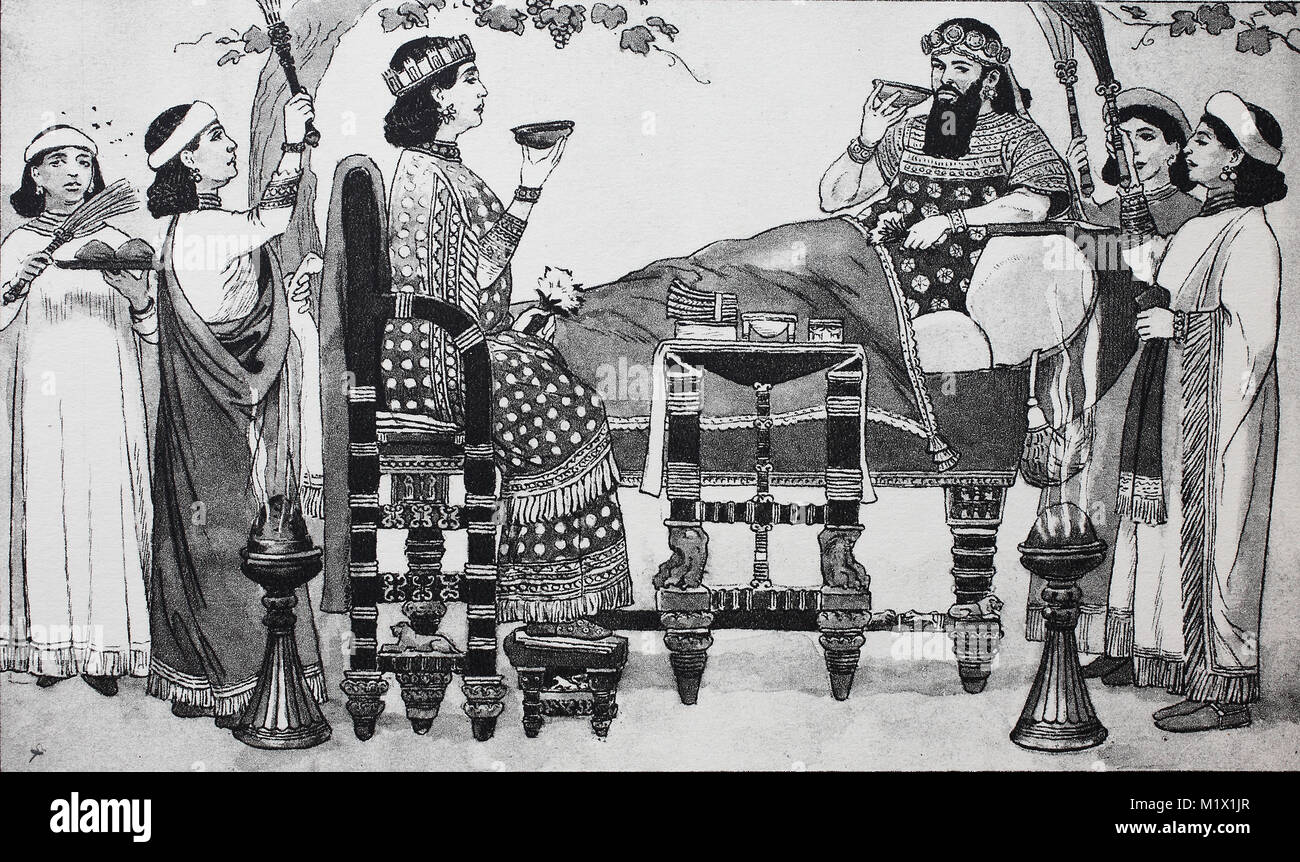 Dress fashion in Babylon and Assyria, King Assurbanipal, 688-626 BC, on the couch in the garden of the harem, the queen sitting on the chair and servants with fly whisk, digital improved reproduction of an original print from the 19th century Stock Photohttps://www.alamy.com/image-license-details/?v=1https://www.alamy.com/stock-photo-dress-fashion-in-babylon-and-assyria-king-assurbanipal-688-626-bc-173290399.html
Dress fashion in Babylon and Assyria, King Assurbanipal, 688-626 BC, on the couch in the garden of the harem, the queen sitting on the chair and servants with fly whisk, digital improved reproduction of an original print from the 19th century Stock Photohttps://www.alamy.com/image-license-details/?v=1https://www.alamy.com/stock-photo-dress-fashion-in-babylon-and-assyria-king-assurbanipal-688-626-bc-173290399.htmlRFM1X1JR–Dress fashion in Babylon and Assyria, King Assurbanipal, 688-626 BC, on the couch in the garden of the harem, the queen sitting on the chair and servants with fly whisk, digital improved reproduction of an original print from the 19th century
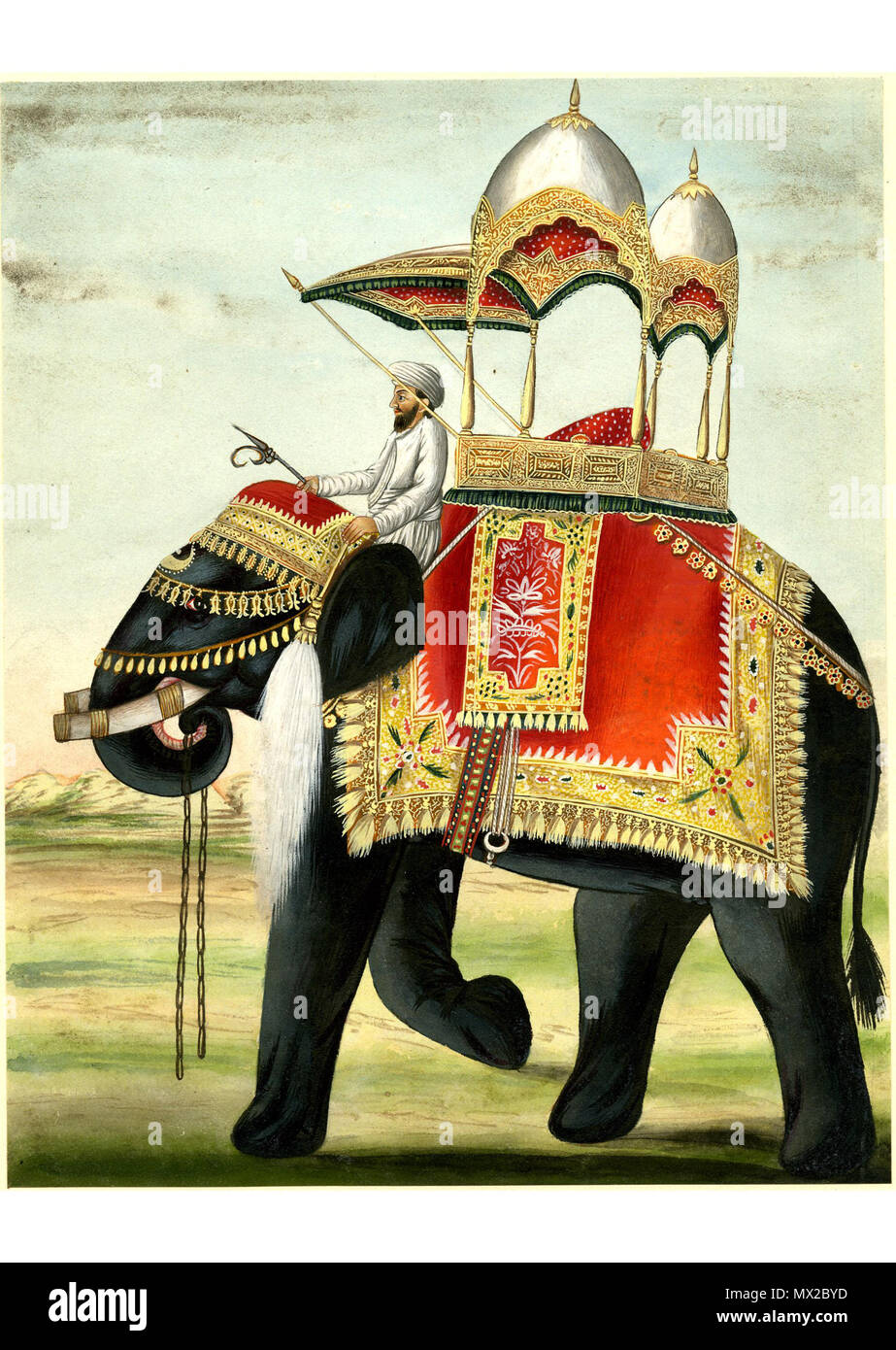 . English: Painting on paper of a decorated elephant with a howdah on its back. The elephant is adorned with a decorated saddle blanket and headdress. On its neck sits a mahout (driver), who holds an ankusha (elephant goad) and an elegant chauri (fly whisk). The howdah is lavishly decorated with textiles and tassels. The roof consists of two silver domes decorated with gold. The elephant is shown walking on a grassy terrain with hills in the distance. 19thC(early). Company School 20 A decorated elephant with a howdah on its back Stock Photohttps://www.alamy.com/image-license-details/?v=1https://www.alamy.com/english-painting-on-paper-of-a-decorated-elephant-with-a-howdah-on-its-back-the-elephant-is-adorned-with-a-decorated-saddle-blanket-and-headdress-on-its-neck-sits-a-mahout-driver-who-holds-an-ankusha-elephant-goad-and-an-elegant-chauri-fly-whisk-the-howdah-is-lavishly-decorated-with-textiles-and-tassels-the-roof-consists-of-two-silver-domes-decorated-with-gold-the-elephant-is-shown-walking-on-a-grassy-terrain-with-hills-in-the-distance-19thcearly-company-school-20-a-decorated-elephant-with-a-howdah-on-its-back-image188138033.html
. English: Painting on paper of a decorated elephant with a howdah on its back. The elephant is adorned with a decorated saddle blanket and headdress. On its neck sits a mahout (driver), who holds an ankusha (elephant goad) and an elegant chauri (fly whisk). The howdah is lavishly decorated with textiles and tassels. The roof consists of two silver domes decorated with gold. The elephant is shown walking on a grassy terrain with hills in the distance. 19thC(early). Company School 20 A decorated elephant with a howdah on its back Stock Photohttps://www.alamy.com/image-license-details/?v=1https://www.alamy.com/english-painting-on-paper-of-a-decorated-elephant-with-a-howdah-on-its-back-the-elephant-is-adorned-with-a-decorated-saddle-blanket-and-headdress-on-its-neck-sits-a-mahout-driver-who-holds-an-ankusha-elephant-goad-and-an-elegant-chauri-fly-whisk-the-howdah-is-lavishly-decorated-with-textiles-and-tassels-the-roof-consists-of-two-silver-domes-decorated-with-gold-the-elephant-is-shown-walking-on-a-grassy-terrain-with-hills-in-the-distance-19thcearly-company-school-20-a-decorated-elephant-with-a-howdah-on-its-back-image188138033.htmlRMMX2BYD–. English: Painting on paper of a decorated elephant with a howdah on its back. The elephant is adorned with a decorated saddle blanket and headdress. On its neck sits a mahout (driver), who holds an ankusha (elephant goad) and an elegant chauri (fly whisk). The howdah is lavishly decorated with textiles and tassels. The roof consists of two silver domes decorated with gold. The elephant is shown walking on a grassy terrain with hills in the distance. 19thC(early). Company School 20 A decorated elephant with a howdah on its back
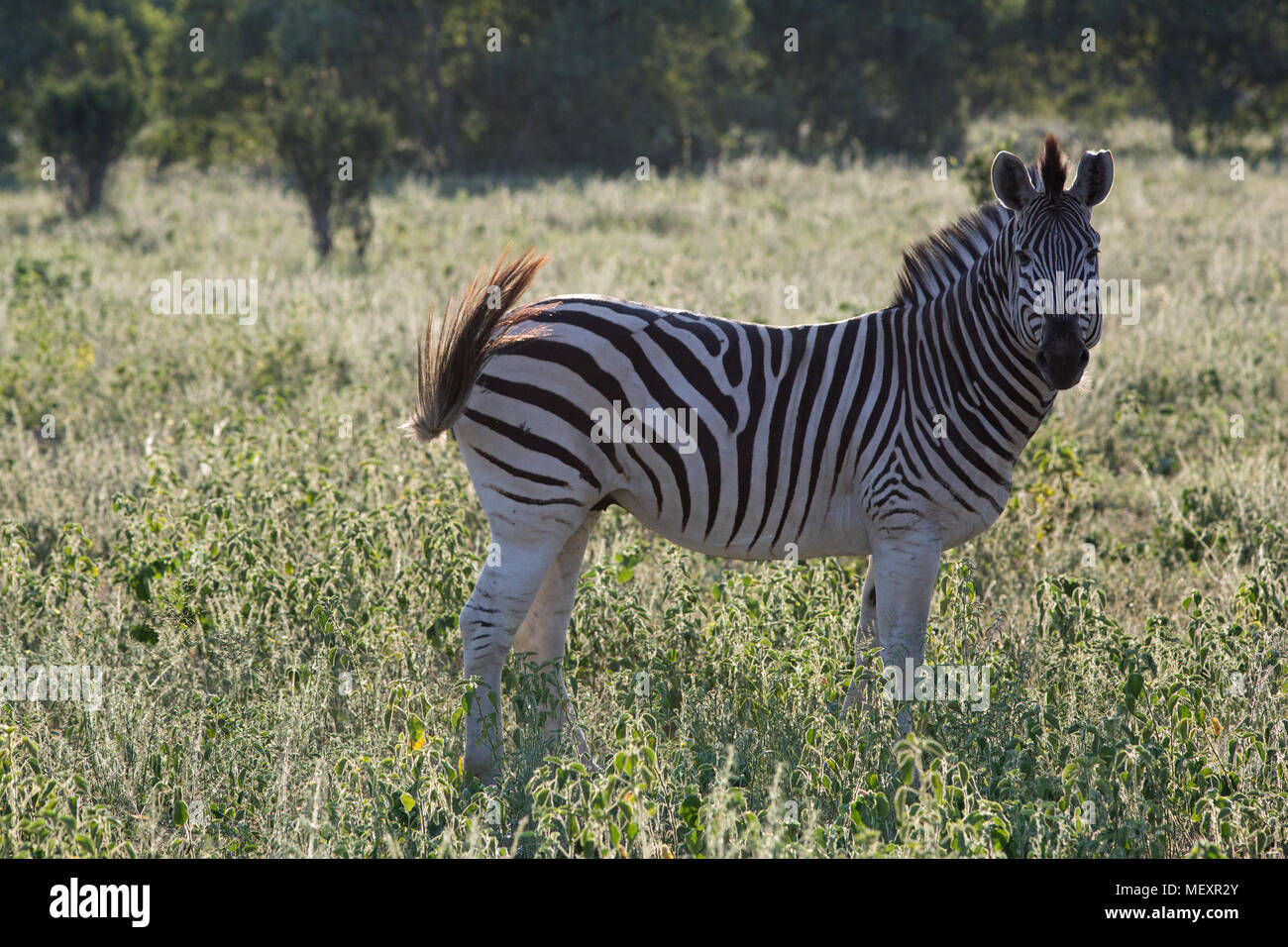 Burchell’s, Common or Plains, Zebra (Equus quagga burchellii). Profile. Using tail as a fly whisk. Okavango Delta. Botswana. Africa. Early morning li Stock Photohttps://www.alamy.com/image-license-details/?v=1https://www.alamy.com/burchells-common-or-plains-zebra-equus-quagga-burchellii-profile-using-tail-as-a-fly-whisk-okavango-delta-botswana-africa-early-morning-li-image181297731.html
Burchell’s, Common or Plains, Zebra (Equus quagga burchellii). Profile. Using tail as a fly whisk. Okavango Delta. Botswana. Africa. Early morning li Stock Photohttps://www.alamy.com/image-license-details/?v=1https://www.alamy.com/burchells-common-or-plains-zebra-equus-quagga-burchellii-profile-using-tail-as-a-fly-whisk-okavango-delta-botswana-africa-early-morning-li-image181297731.htmlRMMEXR2Y–Burchell’s, Common or Plains, Zebra (Equus quagga burchellii). Profile. Using tail as a fly whisk. Okavango Delta. Botswana. Africa. Early morning li
 明中期 剔紅四季花卉紋拂塵, Fly whisk with the Flowers of the Four Seasons, 16th century Stock Photohttps://www.alamy.com/image-license-details/?v=1https://www.alamy.com/stock-image-fly-whisk-with-the-flowers-of-the-four-seasons-16th-century-162447076.html
明中期 剔紅四季花卉紋拂塵, Fly whisk with the Flowers of the Four Seasons, 16th century Stock Photohttps://www.alamy.com/image-license-details/?v=1https://www.alamy.com/stock-image-fly-whisk-with-the-flowers-of-the-four-seasons-16th-century-162447076.htmlRMKC82W8–明中期 剔紅四季花卉紋拂塵, Fly whisk with the Flowers of the Four Seasons, 16th century
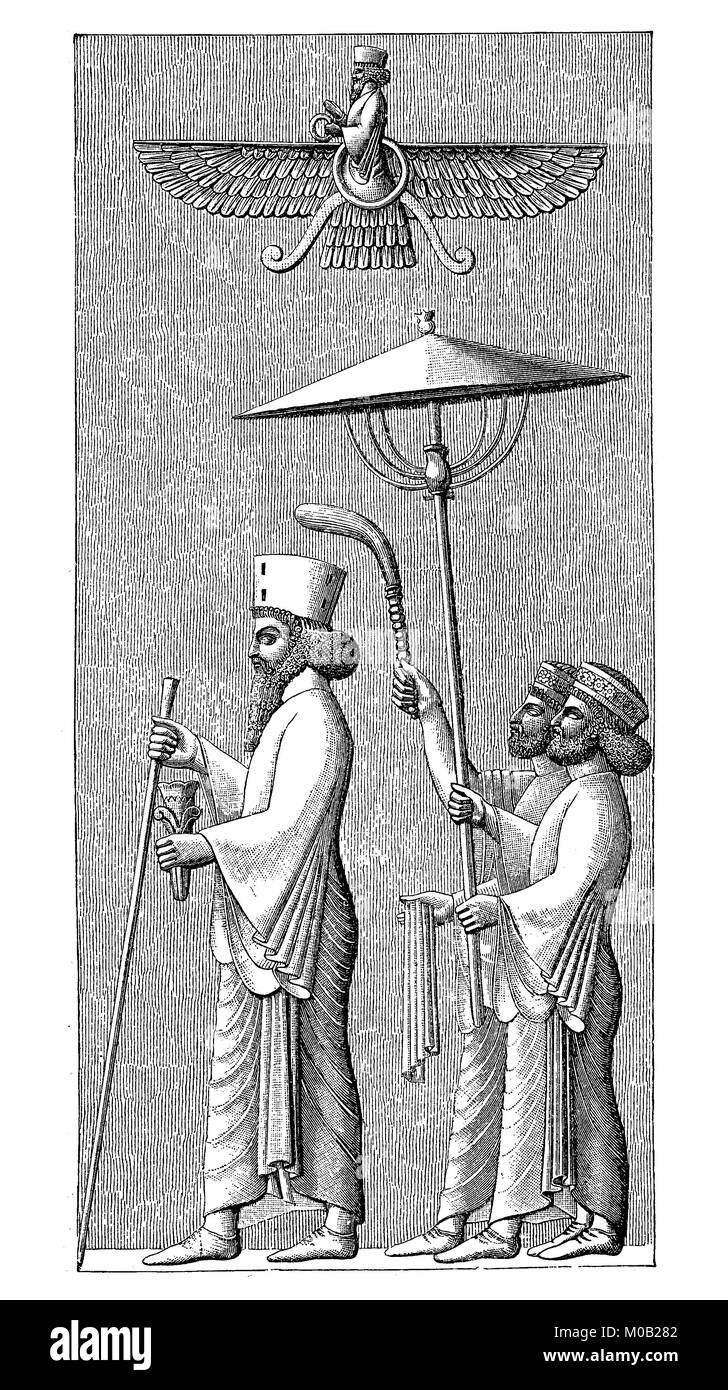 Darius I, the Great, 549 - 486 BC BC, Great King of the Persians 522 - 486 BC Depicted with retinue, umbrella-bearer and fly-whisk on an alt Persian relief, digital improved reproduction of an original print from 1880 Stock Photohttps://www.alamy.com/image-license-details/?v=1https://www.alamy.com/stock-photo-darius-i-the-great-549-486-bc-bc-great-king-of-the-persians-522-486-172346946.html
Darius I, the Great, 549 - 486 BC BC, Great King of the Persians 522 - 486 BC Depicted with retinue, umbrella-bearer and fly-whisk on an alt Persian relief, digital improved reproduction of an original print from 1880 Stock Photohttps://www.alamy.com/image-license-details/?v=1https://www.alamy.com/stock-photo-darius-i-the-great-549-486-bc-bc-great-king-of-the-persians-522-486-172346946.htmlRFM0B282–Darius I, the Great, 549 - 486 BC BC, Great King of the Persians 522 - 486 BC Depicted with retinue, umbrella-bearer and fly-whisk on an alt Persian relief, digital improved reproduction of an original print from 1880
 Three Gold Weights: Sword, Fly Whisk, Amulet, 18th–19th century Stock Photohttps://www.alamy.com/image-license-details/?v=1https://www.alamy.com/stock-image-three-gold-weights-sword-fly-whisk-amulet-18th19th-century-162387967.html
Three Gold Weights: Sword, Fly Whisk, Amulet, 18th–19th century Stock Photohttps://www.alamy.com/image-license-details/?v=1https://www.alamy.com/stock-image-three-gold-weights-sword-fly-whisk-amulet-18th19th-century-162387967.htmlRMKC5BE7–Three Gold Weights: Sword, Fly Whisk, Amulet, 18th–19th century
 Howrah, West Bengal, India - 5th October, 2022 : Hindu Priest worshipping Goddess Durga with chamor, fly whisk fan. Ashtami puja aarati at night. Stock Photohttps://www.alamy.com/image-license-details/?v=1https://www.alamy.com/howrah-west-bengal-india-5th-october-2022-hindu-priest-worshipping-goddess-durga-with-chamor-fly-whisk-fan-ashtami-puja-aarati-at-night-image575208842.html
Howrah, West Bengal, India - 5th October, 2022 : Hindu Priest worshipping Goddess Durga with chamor, fly whisk fan. Ashtami puja aarati at night. Stock Photohttps://www.alamy.com/image-license-details/?v=1https://www.alamy.com/howrah-west-bengal-india-5th-october-2022-hindu-priest-worshipping-goddess-durga-with-chamor-fly-whisk-fan-ashtami-puja-aarati-at-night-image575208842.htmlRF2TBR0MX–Howrah, West Bengal, India - 5th October, 2022 : Hindu Priest worshipping Goddess Durga with chamor, fly whisk fan. Ashtami puja aarati at night.
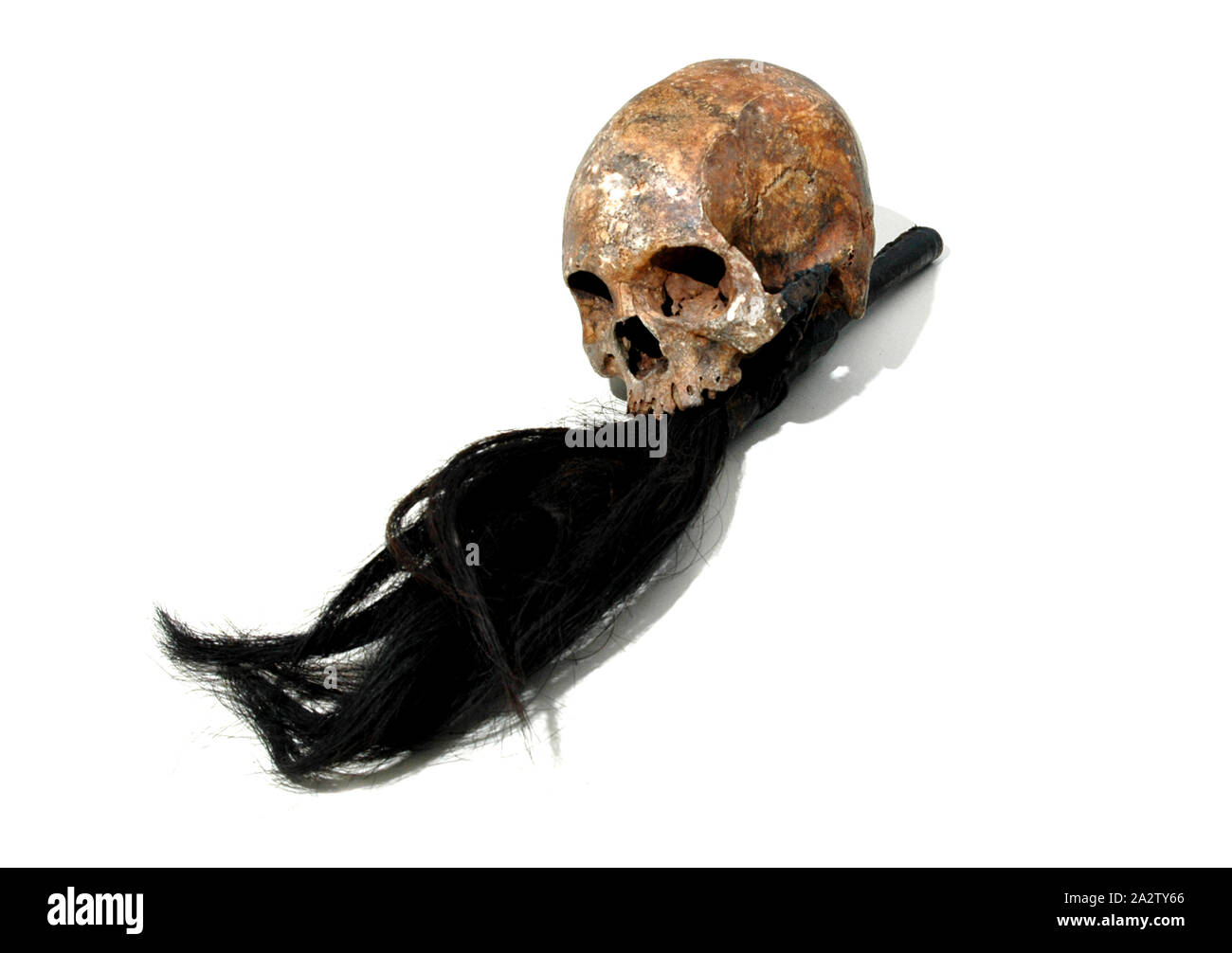 fly whisk with human skull, wood, bone, leather, fiber, approximately L:25 in., African Art Stock Photohttps://www.alamy.com/image-license-details/?v=1https://www.alamy.com/fly-whisk-with-human-skull-wood-bone-leather-fiber-approximately-l25-in-african-art-image328774494.html
fly whisk with human skull, wood, bone, leather, fiber, approximately L:25 in., African Art Stock Photohttps://www.alamy.com/image-license-details/?v=1https://www.alamy.com/fly-whisk-with-human-skull-wood-bone-leather-fiber-approximately-l25-in-african-art-image328774494.htmlRM2A2TY66–fly whisk with human skull, wood, bone, leather, fiber, approximately L:25 in., African Art
 Art inspired by Naga Attendant Holding a Fly Whisk, Ikshvaku period, ca. 3rd century, India (Andhra Pradesh, Nagarjunakonda), Limestone, H. 36 1/4 in. (92.1 cm); W. 8 7/8 in. (22.5 cm); D. 3 3/8 in. (8.6 cm), Sculpture, Classic works modernized by Artotop with a splash of modernity. Shapes, color and value, eye-catching visual impact on art. Emotions through freedom of artworks in a contemporary way. A timeless message pursuing a wildly creative new direction. Artists turning to the digital medium and creating the Artotop NFT Stock Photohttps://www.alamy.com/image-license-details/?v=1https://www.alamy.com/art-inspired-by-naga-attendant-holding-a-fly-whisk-ikshvaku-period-ca-3rd-century-india-andhra-pradesh-nagarjunakonda-limestone-h-36-14-in-921-cm-w-8-78-in-225-cm-d-3-38-in-86-cm-sculpture-classic-works-modernized-by-artotop-with-a-splash-of-modernity-shapes-color-and-value-eye-catching-visual-impact-on-art-emotions-through-freedom-of-artworks-in-a-contemporary-way-a-timeless-message-pursuing-a-wildly-creative-new-direction-artists-turning-to-the-digital-medium-and-creating-the-artotop-nft-image462907651.html
Art inspired by Naga Attendant Holding a Fly Whisk, Ikshvaku period, ca. 3rd century, India (Andhra Pradesh, Nagarjunakonda), Limestone, H. 36 1/4 in. (92.1 cm); W. 8 7/8 in. (22.5 cm); D. 3 3/8 in. (8.6 cm), Sculpture, Classic works modernized by Artotop with a splash of modernity. Shapes, color and value, eye-catching visual impact on art. Emotions through freedom of artworks in a contemporary way. A timeless message pursuing a wildly creative new direction. Artists turning to the digital medium and creating the Artotop NFT Stock Photohttps://www.alamy.com/image-license-details/?v=1https://www.alamy.com/art-inspired-by-naga-attendant-holding-a-fly-whisk-ikshvaku-period-ca-3rd-century-india-andhra-pradesh-nagarjunakonda-limestone-h-36-14-in-921-cm-w-8-78-in-225-cm-d-3-38-in-86-cm-sculpture-classic-works-modernized-by-artotop-with-a-splash-of-modernity-shapes-color-and-value-eye-catching-visual-impact-on-art-emotions-through-freedom-of-artworks-in-a-contemporary-way-a-timeless-message-pursuing-a-wildly-creative-new-direction-artists-turning-to-the-digital-medium-and-creating-the-artotop-nft-image462907651.htmlRF2HW37C3–Art inspired by Naga Attendant Holding a Fly Whisk, Ikshvaku period, ca. 3rd century, India (Andhra Pradesh, Nagarjunakonda), Limestone, H. 36 1/4 in. (92.1 cm); W. 8 7/8 in. (22.5 cm); D. 3 3/8 in. (8.6 cm), Sculpture, Classic works modernized by Artotop with a splash of modernity. Shapes, color and value, eye-catching visual impact on art. Emotions through freedom of artworks in a contemporary way. A timeless message pursuing a wildly creative new direction. Artists turning to the digital medium and creating the Artotop NFT
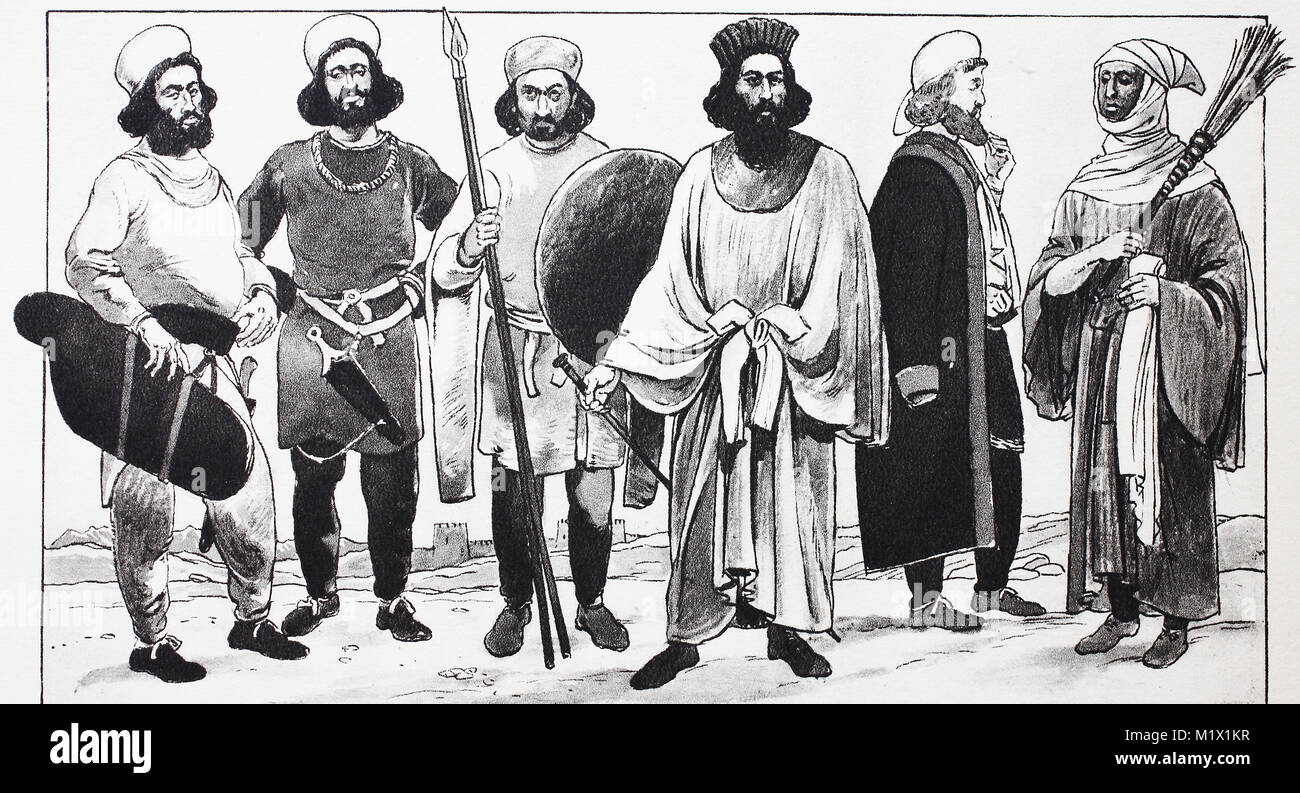 Clothing fashion in Old Persia 6.- 5. Century BC, from the left, three warriors in old Persian short skirt with belt and long trousers, then a noble Persian, then a Persian in travel costume with an open coat and a servant in a long outer garment and fly whisk, digital improved reproduction of an original print from the 19th century Stock Photohttps://www.alamy.com/image-license-details/?v=1https://www.alamy.com/stock-photo-clothing-fashion-in-old-persia-6-5-century-bc-from-the-left-three-173290427.html
Clothing fashion in Old Persia 6.- 5. Century BC, from the left, three warriors in old Persian short skirt with belt and long trousers, then a noble Persian, then a Persian in travel costume with an open coat and a servant in a long outer garment and fly whisk, digital improved reproduction of an original print from the 19th century Stock Photohttps://www.alamy.com/image-license-details/?v=1https://www.alamy.com/stock-photo-clothing-fashion-in-old-persia-6-5-century-bc-from-the-left-three-173290427.htmlRFM1X1KR–Clothing fashion in Old Persia 6.- 5. Century BC, from the left, three warriors in old Persian short skirt with belt and long trousers, then a noble Persian, then a Persian in travel costume with an open coat and a servant in a long outer garment and fly whisk, digital improved reproduction of an original print from the 19th century
 Art inspired by Fly Whisk (chauri) with Design of Floral and Vegetal Motifs on the Handle, Indian, Mughal period, 1526-1858, late 18th century, Ivory and whale baleen, Made in Murshidabad, West Bengal, India, Asia, Jewelry & personal accessories, tools & equipment, length: 33 3/4 in. (, Classic works modernized by Artotop with a splash of modernity. Shapes, color and value, eye-catching visual impact on art. Emotions through freedom of artworks in a contemporary way. A timeless message pursuing a wildly creative new direction. Artists turning to the digital medium and creating the Artotop NFT Stock Photohttps://www.alamy.com/image-license-details/?v=1https://www.alamy.com/art-inspired-by-fly-whisk-chauri-with-design-of-floral-and-vegetal-motifs-on-the-handle-indian-mughal-period-1526-1858-late-18th-century-ivory-and-whale-baleen-made-in-murshidabad-west-bengal-india-asia-jewelry-personal-accessories-tools-equipment-length-33-34-in-classic-works-modernized-by-artotop-with-a-splash-of-modernity-shapes-color-and-value-eye-catching-visual-impact-on-art-emotions-through-freedom-of-artworks-in-a-contemporary-way-a-timeless-message-pursuing-a-wildly-creative-new-direction-artists-turning-to-the-digital-medium-and-creating-the-artotop-nft-image459598301.html
Art inspired by Fly Whisk (chauri) with Design of Floral and Vegetal Motifs on the Handle, Indian, Mughal period, 1526-1858, late 18th century, Ivory and whale baleen, Made in Murshidabad, West Bengal, India, Asia, Jewelry & personal accessories, tools & equipment, length: 33 3/4 in. (, Classic works modernized by Artotop with a splash of modernity. Shapes, color and value, eye-catching visual impact on art. Emotions through freedom of artworks in a contemporary way. A timeless message pursuing a wildly creative new direction. Artists turning to the digital medium and creating the Artotop NFT Stock Photohttps://www.alamy.com/image-license-details/?v=1https://www.alamy.com/art-inspired-by-fly-whisk-chauri-with-design-of-floral-and-vegetal-motifs-on-the-handle-indian-mughal-period-1526-1858-late-18th-century-ivory-and-whale-baleen-made-in-murshidabad-west-bengal-india-asia-jewelry-personal-accessories-tools-equipment-length-33-34-in-classic-works-modernized-by-artotop-with-a-splash-of-modernity-shapes-color-and-value-eye-catching-visual-impact-on-art-emotions-through-freedom-of-artworks-in-a-contemporary-way-a-timeless-message-pursuing-a-wildly-creative-new-direction-artists-turning-to-the-digital-medium-and-creating-the-artotop-nft-image459598301.htmlRF2HKME91–Art inspired by Fly Whisk (chauri) with Design of Floral and Vegetal Motifs on the Handle, Indian, Mughal period, 1526-1858, late 18th century, Ivory and whale baleen, Made in Murshidabad, West Bengal, India, Asia, Jewelry & personal accessories, tools & equipment, length: 33 3/4 in. (, Classic works modernized by Artotop with a splash of modernity. Shapes, color and value, eye-catching visual impact on art. Emotions through freedom of artworks in a contemporary way. A timeless message pursuing a wildly creative new direction. Artists turning to the digital medium and creating the Artotop NFT
 Stick and fly whisk hawkers Flickr Stock Photohttps://www.alamy.com/image-license-details/?v=1https://www.alamy.com/stock-image-stick-and-fly-whisk-hawkers-flickr-166279819.html
Stick and fly whisk hawkers Flickr Stock Photohttps://www.alamy.com/image-license-details/?v=1https://www.alamy.com/stock-image-stick-and-fly-whisk-hawkers-flickr-166279819.htmlRMKJEKGY–Stick and fly whisk hawkers Flickr
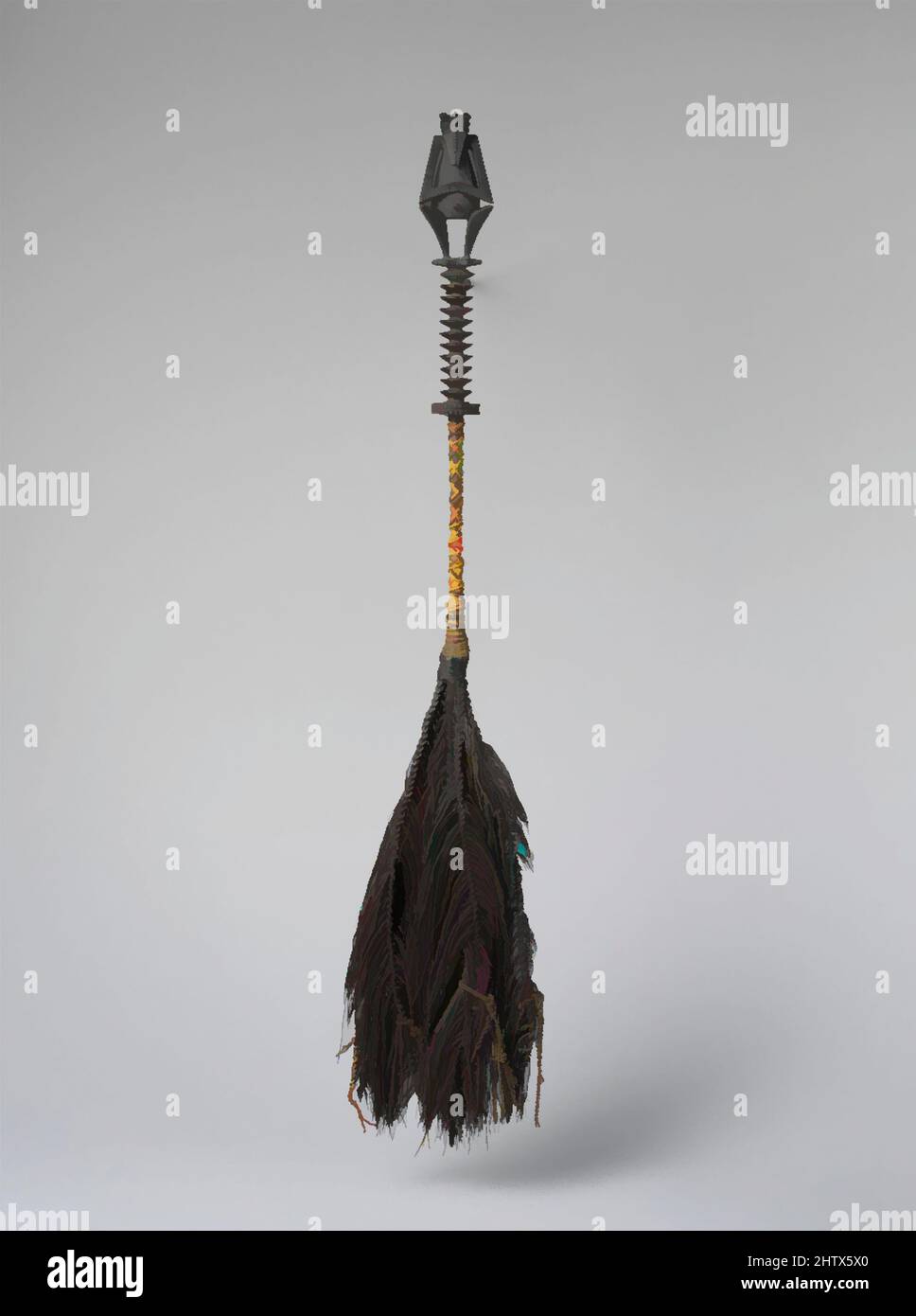 Art inspired by Fly Whisk (Tahiri), early to mid-19th century, French Polynesia, Austral Islands, Austral Islanders, Wood, fiber, human hair, W. 5 1/8 x L. 32 in. (13 x 81.3 cm), Wood-Implements, Artists of the Austral Islands created delicate fly whisks with handles adorned with, Classic works modernized by Artotop with a splash of modernity. Shapes, color and value, eye-catching visual impact on art. Emotions through freedom of artworks in a contemporary way. A timeless message pursuing a wildly creative new direction. Artists turning to the digital medium and creating the Artotop NFT Stock Photohttps://www.alamy.com/image-license-details/?v=1https://www.alamy.com/art-inspired-by-fly-whisk-tahiri-early-to-mid-19th-century-french-polynesia-austral-islands-austral-islanders-wood-fiber-human-hair-w-5-18-x-l-32-in-13-x-813-cm-wood-implements-artists-of-the-austral-islands-created-delicate-fly-whisks-with-handles-adorned-with-classic-works-modernized-by-artotop-with-a-splash-of-modernity-shapes-color-and-value-eye-catching-visual-impact-on-art-emotions-through-freedom-of-artworks-in-a-contemporary-way-a-timeless-message-pursuing-a-wildly-creative-new-direction-artists-turning-to-the-digital-medium-and-creating-the-artotop-nft-image462796712.html
Art inspired by Fly Whisk (Tahiri), early to mid-19th century, French Polynesia, Austral Islands, Austral Islanders, Wood, fiber, human hair, W. 5 1/8 x L. 32 in. (13 x 81.3 cm), Wood-Implements, Artists of the Austral Islands created delicate fly whisks with handles adorned with, Classic works modernized by Artotop with a splash of modernity. Shapes, color and value, eye-catching visual impact on art. Emotions through freedom of artworks in a contemporary way. A timeless message pursuing a wildly creative new direction. Artists turning to the digital medium and creating the Artotop NFT Stock Photohttps://www.alamy.com/image-license-details/?v=1https://www.alamy.com/art-inspired-by-fly-whisk-tahiri-early-to-mid-19th-century-french-polynesia-austral-islands-austral-islanders-wood-fiber-human-hair-w-5-18-x-l-32-in-13-x-813-cm-wood-implements-artists-of-the-austral-islands-created-delicate-fly-whisks-with-handles-adorned-with-classic-works-modernized-by-artotop-with-a-splash-of-modernity-shapes-color-and-value-eye-catching-visual-impact-on-art-emotions-through-freedom-of-artworks-in-a-contemporary-way-a-timeless-message-pursuing-a-wildly-creative-new-direction-artists-turning-to-the-digital-medium-and-creating-the-artotop-nft-image462796712.htmlRF2HTX5X0–Art inspired by Fly Whisk (Tahiri), early to mid-19th century, French Polynesia, Austral Islands, Austral Islanders, Wood, fiber, human hair, W. 5 1/8 x L. 32 in. (13 x 81.3 cm), Wood-Implements, Artists of the Austral Islands created delicate fly whisks with handles adorned with, Classic works modernized by Artotop with a splash of modernity. Shapes, color and value, eye-catching visual impact on art. Emotions through freedom of artworks in a contemporary way. A timeless message pursuing a wildly creative new direction. Artists turning to the digital medium and creating the Artotop NFT
 Levantine in Cairo Costume'. Watercolour. John Gardner Wilkinson (1797-1875) English explorer and Egyptologist. Profile of woman holding fly whisk seated on divan with back to window. Domestic Interior Stock Photohttps://www.alamy.com/image-license-details/?v=1https://www.alamy.com/stock-photo-levantine-in-cairo-costume-watercolour-john-gardner-wilkinson-1797-57366641.html
Levantine in Cairo Costume'. Watercolour. John Gardner Wilkinson (1797-1875) English explorer and Egyptologist. Profile of woman holding fly whisk seated on divan with back to window. Domestic Interior Stock Photohttps://www.alamy.com/image-license-details/?v=1https://www.alamy.com/stock-photo-levantine-in-cairo-costume-watercolour-john-gardner-wilkinson-1797-57366641.htmlRMD997MH–Levantine in Cairo Costume'. Watercolour. John Gardner Wilkinson (1797-1875) English explorer and Egyptologist. Profile of woman holding fly whisk seated on divan with back to window. Domestic Interior
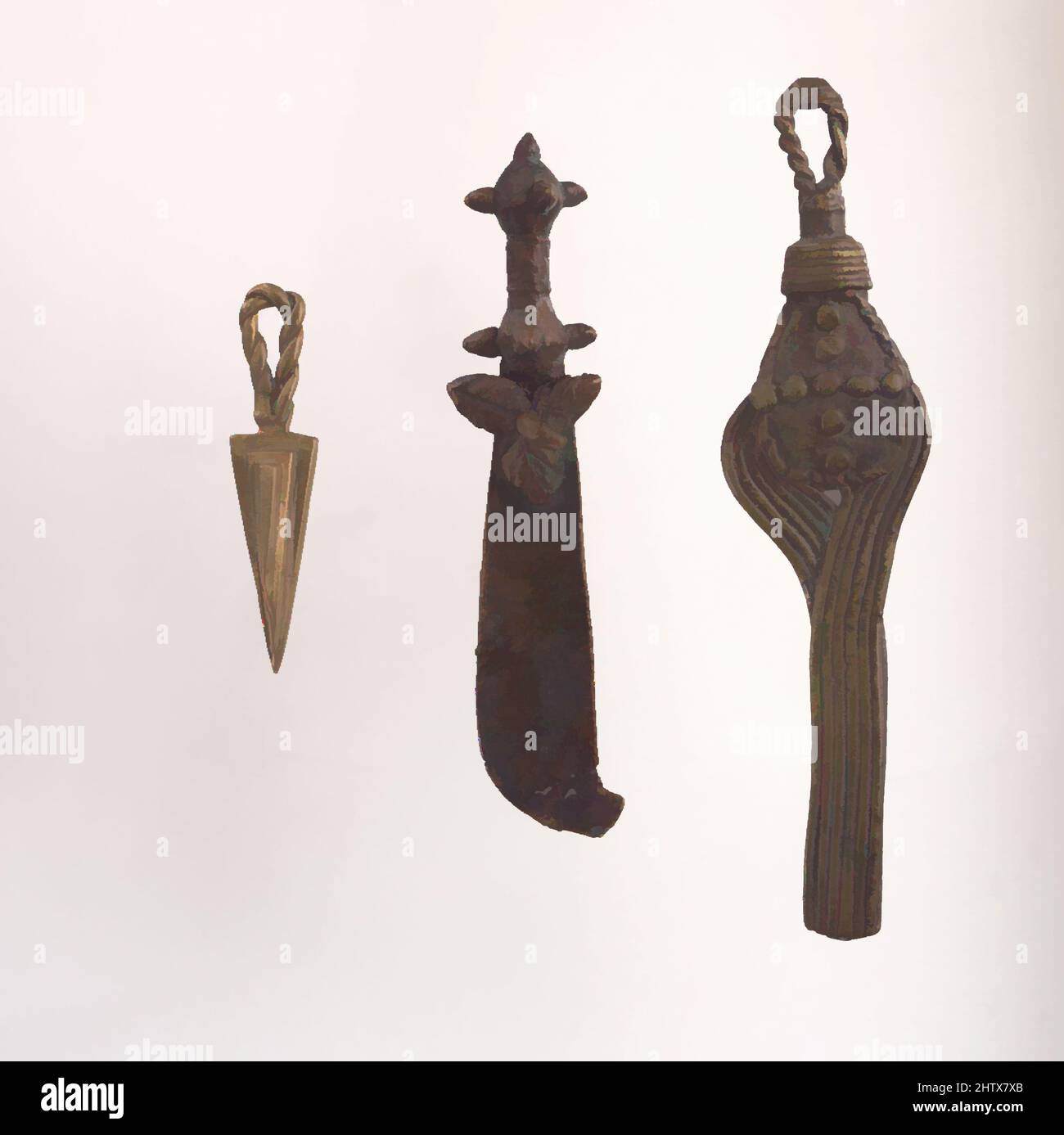 Art inspired by Three Gold Weights: Sword, Fly Whisk, Amulet, 18th–19th century, Ghana, Akan peoples, Brass, L. 1 3/4 in. (4.45 cm) to 3 7/8 in. (9.84 cm), Metal-Implements, Cast brass gold weights, known as abrammuo (sing. mrammuo), were developed by Akan merchants and rulers to, Classic works modernized by Artotop with a splash of modernity. Shapes, color and value, eye-catching visual impact on art. Emotions through freedom of artworks in a contemporary way. A timeless message pursuing a wildly creative new direction. Artists turning to the digital medium and creating the Artotop NFT Stock Photohttps://www.alamy.com/image-license-details/?v=1https://www.alamy.com/art-inspired-by-three-gold-weights-sword-fly-whisk-amulet-18th19th-century-ghana-akan-peoples-brass-l-1-34-in-445-cm-to-3-78-in-984-cm-metal-implements-cast-brass-gold-weights-known-as-abrammuo-sing-mrammuo-were-developed-by-akan-merchants-and-rulers-to-classic-works-modernized-by-artotop-with-a-splash-of-modernity-shapes-color-and-value-eye-catching-visual-impact-on-art-emotions-through-freedom-of-artworks-in-a-contemporary-way-a-timeless-message-pursuing-a-wildly-creative-new-direction-artists-turning-to-the-digital-medium-and-creating-the-artotop-nft-image462798291.html
Art inspired by Three Gold Weights: Sword, Fly Whisk, Amulet, 18th–19th century, Ghana, Akan peoples, Brass, L. 1 3/4 in. (4.45 cm) to 3 7/8 in. (9.84 cm), Metal-Implements, Cast brass gold weights, known as abrammuo (sing. mrammuo), were developed by Akan merchants and rulers to, Classic works modernized by Artotop with a splash of modernity. Shapes, color and value, eye-catching visual impact on art. Emotions through freedom of artworks in a contemporary way. A timeless message pursuing a wildly creative new direction. Artists turning to the digital medium and creating the Artotop NFT Stock Photohttps://www.alamy.com/image-license-details/?v=1https://www.alamy.com/art-inspired-by-three-gold-weights-sword-fly-whisk-amulet-18th19th-century-ghana-akan-peoples-brass-l-1-34-in-445-cm-to-3-78-in-984-cm-metal-implements-cast-brass-gold-weights-known-as-abrammuo-sing-mrammuo-were-developed-by-akan-merchants-and-rulers-to-classic-works-modernized-by-artotop-with-a-splash-of-modernity-shapes-color-and-value-eye-catching-visual-impact-on-art-emotions-through-freedom-of-artworks-in-a-contemporary-way-a-timeless-message-pursuing-a-wildly-creative-new-direction-artists-turning-to-the-digital-medium-and-creating-the-artotop-nft-image462798291.htmlRF2HTX7XB–Art inspired by Three Gold Weights: Sword, Fly Whisk, Amulet, 18th–19th century, Ghana, Akan peoples, Brass, L. 1 3/4 in. (4.45 cm) to 3 7/8 in. (9.84 cm), Metal-Implements, Cast brass gold weights, known as abrammuo (sing. mrammuo), were developed by Akan merchants and rulers to, Classic works modernized by Artotop with a splash of modernity. Shapes, color and value, eye-catching visual impact on art. Emotions through freedom of artworks in a contemporary way. A timeless message pursuing a wildly creative new direction. Artists turning to the digital medium and creating the Artotop NFT
RMPAM1E4–Enthroned Jina Attended by a Yaksha, a Yakshi, and Chauri-Bearers. Culture: India (Karnataka). Dimensions: H. 9 3/4 in. (24.8 cm). Date: 9th-10th century. This Digambara icon from the Deccan shows a jina meditating beneath a flowering tree, follow the conventions seen in Buddhist sculptures of the period. As in Buddhist images, the jina is flanked by attendants--the nature-deity yaksha and yakshi replacing the bodhisattvas--and fly-whisk bearers gesturing their readiness to fan him. A lion-supported throne and triple umbrellas confirm the regal status. Rock-cut versions of such compositions a
 Art inspired by Handle for a Fly Whisk (Tahiri), 18th century, Tahiti, Society Islands, Maohi (Tahitian), Ivory, coconut husk fiber, H. 1 5/8 x W. 1 3/8 x D. 11 3/4 in. (4.1 x 3.5 x 29.8 cm), Bone/Ivory-Implements, This elaborately carved ivory flywhisk handle was once owned by the, Classic works modernized by Artotop with a splash of modernity. Shapes, color and value, eye-catching visual impact on art. Emotions through freedom of artworks in a contemporary way. A timeless message pursuing a wildly creative new direction. Artists turning to the digital medium and creating the Artotop NFT Stock Photohttps://www.alamy.com/image-license-details/?v=1https://www.alamy.com/art-inspired-by-handle-for-a-fly-whisk-tahiri-18th-century-tahiti-society-islands-maohi-tahitian-ivory-coconut-husk-fiber-h-1-58-x-w-1-38-x-d-11-34-in-41-x-35-x-298-cm-boneivory-implements-this-elaborately-carved-ivory-flywhisk-handle-was-once-owned-by-the-classic-works-modernized-by-artotop-with-a-splash-of-modernity-shapes-color-and-value-eye-catching-visual-impact-on-art-emotions-through-freedom-of-artworks-in-a-contemporary-way-a-timeless-message-pursuing-a-wildly-creative-new-direction-artists-turning-to-the-digital-medium-and-creating-the-artotop-nft-image462795691.html
Art inspired by Handle for a Fly Whisk (Tahiri), 18th century, Tahiti, Society Islands, Maohi (Tahitian), Ivory, coconut husk fiber, H. 1 5/8 x W. 1 3/8 x D. 11 3/4 in. (4.1 x 3.5 x 29.8 cm), Bone/Ivory-Implements, This elaborately carved ivory flywhisk handle was once owned by the, Classic works modernized by Artotop with a splash of modernity. Shapes, color and value, eye-catching visual impact on art. Emotions through freedom of artworks in a contemporary way. A timeless message pursuing a wildly creative new direction. Artists turning to the digital medium and creating the Artotop NFT Stock Photohttps://www.alamy.com/image-license-details/?v=1https://www.alamy.com/art-inspired-by-handle-for-a-fly-whisk-tahiri-18th-century-tahiti-society-islands-maohi-tahitian-ivory-coconut-husk-fiber-h-1-58-x-w-1-38-x-d-11-34-in-41-x-35-x-298-cm-boneivory-implements-this-elaborately-carved-ivory-flywhisk-handle-was-once-owned-by-the-classic-works-modernized-by-artotop-with-a-splash-of-modernity-shapes-color-and-value-eye-catching-visual-impact-on-art-emotions-through-freedom-of-artworks-in-a-contemporary-way-a-timeless-message-pursuing-a-wildly-creative-new-direction-artists-turning-to-the-digital-medium-and-creating-the-artotop-nft-image462795691.htmlRF2HTX4HF–Art inspired by Handle for a Fly Whisk (Tahiri), 18th century, Tahiti, Society Islands, Maohi (Tahitian), Ivory, coconut husk fiber, H. 1 5/8 x W. 1 3/8 x D. 11 3/4 in. (4.1 x 3.5 x 29.8 cm), Bone/Ivory-Implements, This elaborately carved ivory flywhisk handle was once owned by the, Classic works modernized by Artotop with a splash of modernity. Shapes, color and value, eye-catching visual impact on art. Emotions through freedom of artworks in a contemporary way. A timeless message pursuing a wildly creative new direction. Artists turning to the digital medium and creating the Artotop NFT
 Guanyin holding a bottle and fly whisk, China, Five Dynasties or Song Dynasty, 907-1279 AD, bronze with traces of gilding - Wadsworth Atheneum - Hartford, CT Stock Photohttps://www.alamy.com/image-license-details/?v=1https://www.alamy.com/guanyin-holding-a-bottle-and-fly-whisk-china-five-dynasties-or-song-dynasty-907-1279-ad-bronze-with-traces-of-gilding-wadsworth-atheneum-hartford-ct-image351661334.html
Guanyin holding a bottle and fly whisk, China, Five Dynasties or Song Dynasty, 907-1279 AD, bronze with traces of gilding - Wadsworth Atheneum - Hartford, CT Stock Photohttps://www.alamy.com/image-license-details/?v=1https://www.alamy.com/guanyin-holding-a-bottle-and-fly-whisk-china-five-dynasties-or-song-dynasty-907-1279-ad-bronze-with-traces-of-gilding-wadsworth-atheneum-hartford-ct-image351661334.htmlRM2BC3FHA–Guanyin holding a bottle and fly whisk, China, Five Dynasties or Song Dynasty, 907-1279 AD, bronze with traces of gilding - Wadsworth Atheneum - Hartford, CT
 Portrait of the Great Master Yeongwoldang Eungjin, 1700s. The monk in this portrait, identified by an inscription in a red cartouche at the upper right of this painting, is the Great Master Yeongwoldang Eungjin. Portraits of this type, painted following the death of an important Buddhist monk, are known as jinyeong. His elevated status is indicated by his fine monastic garments, the dragon-headed ceremonial fly whisk he holds in his left hand, and the Buddhist scripture in his right hand. The writing box on his desk, with brushes, ink stone, and water dropper, further emphasizes his prowess as Stock Photohttps://www.alamy.com/image-license-details/?v=1https://www.alamy.com/portrait-of-the-great-master-yeongwoldang-eungjin-1700s-the-monk-in-this-portrait-identified-by-an-inscription-in-a-red-cartouche-at-the-upper-right-of-this-painting-is-the-great-master-yeongwoldang-eungjin-portraits-of-this-type-painted-following-the-death-of-an-important-buddhist-monk-are-known-as-jinyeong-his-elevated-status-is-indicated-by-his-fine-monastic-garments-the-dragon-headed-ceremonial-fly-whisk-he-holds-in-his-left-hand-and-the-buddhist-scripture-in-his-right-hand-the-writing-box-on-his-desk-with-brushes-ink-stone-and-water-dropper-further-emphasizes-his-prowess-as-image330114116.html
Portrait of the Great Master Yeongwoldang Eungjin, 1700s. The monk in this portrait, identified by an inscription in a red cartouche at the upper right of this painting, is the Great Master Yeongwoldang Eungjin. Portraits of this type, painted following the death of an important Buddhist monk, are known as jinyeong. His elevated status is indicated by his fine monastic garments, the dragon-headed ceremonial fly whisk he holds in his left hand, and the Buddhist scripture in his right hand. The writing box on his desk, with brushes, ink stone, and water dropper, further emphasizes his prowess as Stock Photohttps://www.alamy.com/image-license-details/?v=1https://www.alamy.com/portrait-of-the-great-master-yeongwoldang-eungjin-1700s-the-monk-in-this-portrait-identified-by-an-inscription-in-a-red-cartouche-at-the-upper-right-of-this-painting-is-the-great-master-yeongwoldang-eungjin-portraits-of-this-type-painted-following-the-death-of-an-important-buddhist-monk-are-known-as-jinyeong-his-elevated-status-is-indicated-by-his-fine-monastic-garments-the-dragon-headed-ceremonial-fly-whisk-he-holds-in-his-left-hand-and-the-buddhist-scripture-in-his-right-hand-the-writing-box-on-his-desk-with-brushes-ink-stone-and-water-dropper-further-emphasizes-his-prowess-as-image330114116.htmlRM2A51YWT–Portrait of the Great Master Yeongwoldang Eungjin, 1700s. The monk in this portrait, identified by an inscription in a red cartouche at the upper right of this painting, is the Great Master Yeongwoldang Eungjin. Portraits of this type, painted following the death of an important Buddhist monk, are known as jinyeong. His elevated status is indicated by his fine monastic garments, the dragon-headed ceremonial fly whisk he holds in his left hand, and the Buddhist scripture in his right hand. The writing box on his desk, with brushes, ink stone, and water dropper, further emphasizes his prowess as
 Algeria: 'Femmes Maures' (Moorish Women), women preparing couscous in an Algiers courtyard,. Photograph by Luce Ben Aben, 1899. The history of Algiers from 1815 to 1962 is bound to the larger history of Algeria and its relationship to France. On July 4, 1830, under the pretext of an affront to the French consul - whom the dey had hit with a fly-whisk when the consul said the French government was not prepared to pay its large outstanding debts to two Algerian merchants - a French army under General de Bourmont attacked the city in the 1830 invasion of Algiers. Stock Photohttps://www.alamy.com/image-license-details/?v=1https://www.alamy.com/algeria-femmes-maures-moorish-women-women-preparing-couscous-in-an-algiers-courtyard-photograph-by-luce-ben-aben-1899-the-history-of-algiers-from-1815-to-1962-is-bound-to-the-larger-history-of-algeria-and-its-relationship-to-france-on-july-4-1830-under-the-pretext-of-an-affront-to-the-french-consul-whom-the-dey-had-hit-with-a-fly-whisk-when-the-consul-said-the-french-government-was-not-prepared-to-pay-its-large-outstanding-debts-to-two-algerian-merchants-a-french-army-under-general-de-bourmont-attacked-the-city-in-the-1830-invasion-of-algiers-image344249660.html
Algeria: 'Femmes Maures' (Moorish Women), women preparing couscous in an Algiers courtyard,. Photograph by Luce Ben Aben, 1899. The history of Algiers from 1815 to 1962 is bound to the larger history of Algeria and its relationship to France. On July 4, 1830, under the pretext of an affront to the French consul - whom the dey had hit with a fly-whisk when the consul said the French government was not prepared to pay its large outstanding debts to two Algerian merchants - a French army under General de Bourmont attacked the city in the 1830 invasion of Algiers. Stock Photohttps://www.alamy.com/image-license-details/?v=1https://www.alamy.com/algeria-femmes-maures-moorish-women-women-preparing-couscous-in-an-algiers-courtyard-photograph-by-luce-ben-aben-1899-the-history-of-algiers-from-1815-to-1962-is-bound-to-the-larger-history-of-algeria-and-its-relationship-to-france-on-july-4-1830-under-the-pretext-of-an-affront-to-the-french-consul-whom-the-dey-had-hit-with-a-fly-whisk-when-the-consul-said-the-french-government-was-not-prepared-to-pay-its-large-outstanding-debts-to-two-algerian-merchants-a-french-army-under-general-de-bourmont-attacked-the-city-in-the-1830-invasion-of-algiers-image344249660.htmlRM2B01WXM–Algeria: 'Femmes Maures' (Moorish Women), women preparing couscous in an Algiers courtyard,. Photograph by Luce Ben Aben, 1899. The history of Algiers from 1815 to 1962 is bound to the larger history of Algeria and its relationship to France. On July 4, 1830, under the pretext of an affront to the French consul - whom the dey had hit with a fly-whisk when the consul said the French government was not prepared to pay its large outstanding debts to two Algerian merchants - a French army under General de Bourmont attacked the city in the 1830 invasion of Algiers.
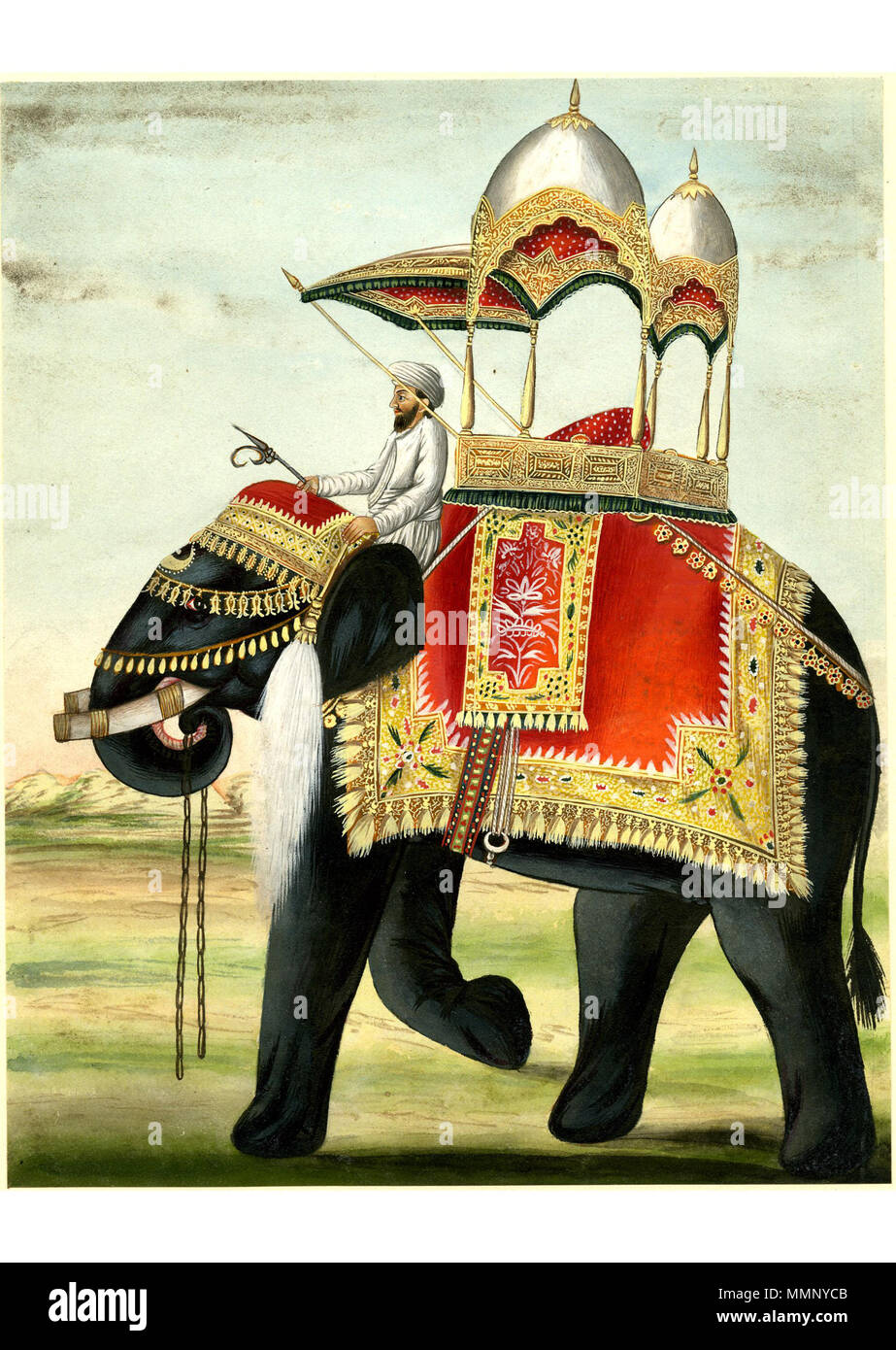 . English: Painting on paper of a decorated elephant with a howdah on its back. The elephant is adorned with a decorated saddle blanket and headdress. On its neck sits a mahout (driver), who holds an ankusha (elephant goad) and an elegant chauri (fly whisk). The howdah is lavishly decorated with textiles and tassels. The roof consists of two silver domes decorated with gold. The elephant is shown walking on a grassy terrain with hills in the distance. . 19thC(early). Company School 20 A decorated elephant with a howdah on its back Stock Photohttps://www.alamy.com/image-license-details/?v=1https://www.alamy.com/english-painting-on-paper-of-a-decorated-elephant-with-a-howdah-on-its-back-the-elephant-is-adorned-with-a-decorated-saddle-blanket-and-headdress-on-its-neck-sits-a-mahout-driver-who-holds-an-ankusha-elephant-goad-and-an-elegant-chauri-fly-whisk-the-howdah-is-lavishly-decorated-with-textiles-and-tassels-the-roof-consists-of-two-silver-domes-decorated-with-gold-the-elephant-is-shown-walking-on-a-grassy-terrain-with-hills-in-the-distance-19thcearly-company-school-20-a-decorated-elephant-with-a-howdah-on-its-back-image184879307.html
. English: Painting on paper of a decorated elephant with a howdah on its back. The elephant is adorned with a decorated saddle blanket and headdress. On its neck sits a mahout (driver), who holds an ankusha (elephant goad) and an elegant chauri (fly whisk). The howdah is lavishly decorated with textiles and tassels. The roof consists of two silver domes decorated with gold. The elephant is shown walking on a grassy terrain with hills in the distance. . 19thC(early). Company School 20 A decorated elephant with a howdah on its back Stock Photohttps://www.alamy.com/image-license-details/?v=1https://www.alamy.com/english-painting-on-paper-of-a-decorated-elephant-with-a-howdah-on-its-back-the-elephant-is-adorned-with-a-decorated-saddle-blanket-and-headdress-on-its-neck-sits-a-mahout-driver-who-holds-an-ankusha-elephant-goad-and-an-elegant-chauri-fly-whisk-the-howdah-is-lavishly-decorated-with-textiles-and-tassels-the-roof-consists-of-two-silver-domes-decorated-with-gold-the-elephant-is-shown-walking-on-a-grassy-terrain-with-hills-in-the-distance-19thcearly-company-school-20-a-decorated-elephant-with-a-howdah-on-its-back-image184879307.htmlRMMMNYCB–. English: Painting on paper of a decorated elephant with a howdah on its back. The elephant is adorned with a decorated saddle blanket and headdress. On its neck sits a mahout (driver), who holds an ankusha (elephant goad) and an elegant chauri (fly whisk). The howdah is lavishly decorated with textiles and tassels. The roof consists of two silver domes decorated with gold. The elephant is shown walking on a grassy terrain with hills in the distance. . 19thC(early). Company School 20 A decorated elephant with a howdah on its back
 Algeria: 'A Woman from Algiers'. Oil on panel painting by John Evan Hodgson (1 March 1831 - 1895), 1871. The history of Algiers from 1815 to 1962 is bound to the larger history of Algeria and its relationship to France. On July 4, 1830, under the pretext of an affront to the French consul - whom the dey had hit with a fly-whisk when the consul said the French government was not prepared to pay its large outstanding debts to two Algerian merchants - a French army under General de Bourmont attacked the city in the 1830 invasion of Algiers. The city capitulated the following day. Stock Photohttps://www.alamy.com/image-license-details/?v=1https://www.alamy.com/algeria-a-woman-from-algiers-oil-on-panel-painting-by-john-evan-hodgson-1-march-1831-1895-1871-the-history-of-algiers-from-1815-to-1962-is-bound-to-the-larger-history-of-algeria-and-its-relationship-to-france-on-july-4-1830-under-the-pretext-of-an-affront-to-the-french-consul-whom-the-dey-had-hit-with-a-fly-whisk-when-the-consul-said-the-french-government-was-not-prepared-to-pay-its-large-outstanding-debts-to-two-algerian-merchants-a-french-army-under-general-de-bourmont-attacked-the-city-in-the-1830-invasion-of-algiers-the-city-capitulated-the-following-day-image344250159.html
Algeria: 'A Woman from Algiers'. Oil on panel painting by John Evan Hodgson (1 March 1831 - 1895), 1871. The history of Algiers from 1815 to 1962 is bound to the larger history of Algeria and its relationship to France. On July 4, 1830, under the pretext of an affront to the French consul - whom the dey had hit with a fly-whisk when the consul said the French government was not prepared to pay its large outstanding debts to two Algerian merchants - a French army under General de Bourmont attacked the city in the 1830 invasion of Algiers. The city capitulated the following day. Stock Photohttps://www.alamy.com/image-license-details/?v=1https://www.alamy.com/algeria-a-woman-from-algiers-oil-on-panel-painting-by-john-evan-hodgson-1-march-1831-1895-1871-the-history-of-algiers-from-1815-to-1962-is-bound-to-the-larger-history-of-algeria-and-its-relationship-to-france-on-july-4-1830-under-the-pretext-of-an-affront-to-the-french-consul-whom-the-dey-had-hit-with-a-fly-whisk-when-the-consul-said-the-french-government-was-not-prepared-to-pay-its-large-outstanding-debts-to-two-algerian-merchants-a-french-army-under-general-de-bourmont-attacked-the-city-in-the-1830-invasion-of-algiers-the-city-capitulated-the-following-day-image344250159.htmlRM2B01XGF–Algeria: 'A Woman from Algiers'. Oil on panel painting by John Evan Hodgson (1 March 1831 - 1895), 1871. The history of Algiers from 1815 to 1962 is bound to the larger history of Algeria and its relationship to France. On July 4, 1830, under the pretext of an affront to the French consul - whom the dey had hit with a fly-whisk when the consul said the French government was not prepared to pay its large outstanding debts to two Algerian merchants - a French army under General de Bourmont attacked the city in the 1830 invasion of Algiers. The city capitulated the following day.
 Vintage photograph of Siamese prince. Siam (Thailand). 1865 (by John Thomson) A young child (less than five years old), wearing a top-knot, heavy bangles at his wrists and ankles, seated on a table. A servant (?) holding a fly-whisk crouching on the floor before him. Stock Photohttps://www.alamy.com/image-license-details/?v=1https://www.alamy.com/vintage-photograph-of-siamese-prince-siam-thailand-1865-by-john-thomson-a-young-child-less-than-five-years-old-wearing-a-top-knot-heavy-bangles-at-his-wrists-and-ankles-seated-on-a-table-a-servant-holding-a-fly-whisk-crouching-on-the-floor-before-him-image624387216.html
Vintage photograph of Siamese prince. Siam (Thailand). 1865 (by John Thomson) A young child (less than five years old), wearing a top-knot, heavy bangles at his wrists and ankles, seated on a table. A servant (?) holding a fly-whisk crouching on the floor before him. Stock Photohttps://www.alamy.com/image-license-details/?v=1https://www.alamy.com/vintage-photograph-of-siamese-prince-siam-thailand-1865-by-john-thomson-a-young-child-less-than-five-years-old-wearing-a-top-knot-heavy-bangles-at-his-wrists-and-ankles-seated-on-a-table-a-servant-holding-a-fly-whisk-crouching-on-the-floor-before-him-image624387216.htmlRM2Y7R87C–Vintage photograph of Siamese prince. Siam (Thailand). 1865 (by John Thomson) A young child (less than five years old), wearing a top-knot, heavy bangles at his wrists and ankles, seated on a table. A servant (?) holding a fly-whisk crouching on the floor before him.
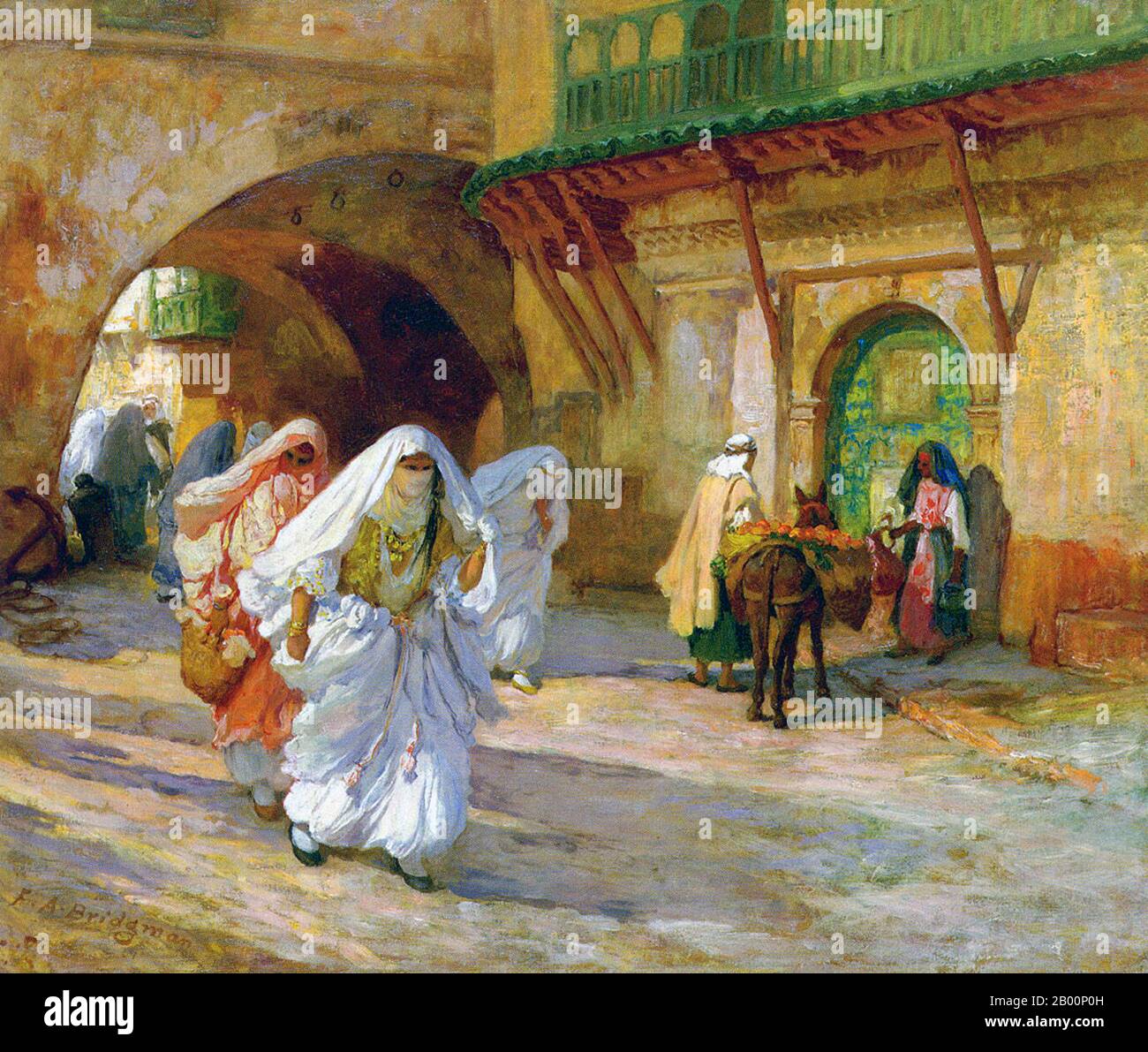 Algeria/USA: 'Women of Algiers'. Oil on canvas painting by Frederick Arthur Bridgman (1847-1928), late 19th century. The history of Algiers from 1815 to 1962 is bound to Algeria and its relationship to France. On July 4, 1830, under the pretext of an affront to the French consul—whom the dey (an Ottoman ruler) had hit with a fly-whisk when the consul said the French government was not prepared to pay its large outstanding debts to two Algerian Jewish merchants—a French army under General de Bourmont attacked the city in the 1830 invasion of Algiers. The city capitulated the following day. Stock Photohttps://www.alamy.com/image-license-details/?v=1https://www.alamy.com/algeriausa-women-of-algiers-oil-on-canvas-painting-by-frederick-arthur-bridgman-1847-1928-late-19th-century-the-history-of-algiers-from-1815-to-1962-is-bound-to-algeria-and-its-relationship-to-france-on-july-4-1830-under-the-pretext-of-an-affront-to-the-french-consulwhom-the-dey-an-ottoman-ruler-had-hit-with-a-fly-whisk-when-the-consul-said-the-french-government-was-not-prepared-to-pay-its-large-outstanding-debts-to-two-algerian-jewish-merchantsa-french-army-under-general-de-bourmont-attacked-the-city-in-the-1830-invasion-of-algiers-the-city-capitulated-the-following-day-image344224625.html
Algeria/USA: 'Women of Algiers'. Oil on canvas painting by Frederick Arthur Bridgman (1847-1928), late 19th century. The history of Algiers from 1815 to 1962 is bound to Algeria and its relationship to France. On July 4, 1830, under the pretext of an affront to the French consul—whom the dey (an Ottoman ruler) had hit with a fly-whisk when the consul said the French government was not prepared to pay its large outstanding debts to two Algerian Jewish merchants—a French army under General de Bourmont attacked the city in the 1830 invasion of Algiers. The city capitulated the following day. Stock Photohttps://www.alamy.com/image-license-details/?v=1https://www.alamy.com/algeriausa-women-of-algiers-oil-on-canvas-painting-by-frederick-arthur-bridgman-1847-1928-late-19th-century-the-history-of-algiers-from-1815-to-1962-is-bound-to-algeria-and-its-relationship-to-france-on-july-4-1830-under-the-pretext-of-an-affront-to-the-french-consulwhom-the-dey-an-ottoman-ruler-had-hit-with-a-fly-whisk-when-the-consul-said-the-french-government-was-not-prepared-to-pay-its-large-outstanding-debts-to-two-algerian-jewish-merchantsa-french-army-under-general-de-bourmont-attacked-the-city-in-the-1830-invasion-of-algiers-the-city-capitulated-the-following-day-image344224625.htmlRM2B00P0H–Algeria/USA: 'Women of Algiers'. Oil on canvas painting by Frederick Arthur Bridgman (1847-1928), late 19th century. The history of Algiers from 1815 to 1962 is bound to Algeria and its relationship to France. On July 4, 1830, under the pretext of an affront to the French consul—whom the dey (an Ottoman ruler) had hit with a fly-whisk when the consul said the French government was not prepared to pay its large outstanding debts to two Algerian Jewish merchants—a French army under General de Bourmont attacked the city in the 1830 invasion of Algiers. The city capitulated the following day.
 Stick and fly whisk hawkers Stock Photohttps://www.alamy.com/image-license-details/?v=1https://www.alamy.com/stick-and-fly-whisk-hawkers-image69087357.html
Stick and fly whisk hawkers Stock Photohttps://www.alamy.com/image-license-details/?v=1https://www.alamy.com/stick-and-fly-whisk-hawkers-image69087357.htmlRME0B5HH–Stick and fly whisk hawkers
 Howrah, West Bengal, India - 5th October, 2022 : Hindu Priest worshipping Goddess Durga with chamor, fly whisk fan. Ashtami puja aarati at night. Stock Photohttps://www.alamy.com/image-license-details/?v=1https://www.alamy.com/howrah-west-bengal-india-5th-october-2022-hindu-priest-worshipping-goddess-durga-with-chamor-fly-whisk-fan-ashtami-puja-aarati-at-night-image566784549.html
Howrah, West Bengal, India - 5th October, 2022 : Hindu Priest worshipping Goddess Durga with chamor, fly whisk fan. Ashtami puja aarati at night. Stock Photohttps://www.alamy.com/image-license-details/?v=1https://www.alamy.com/howrah-west-bengal-india-5th-october-2022-hindu-priest-worshipping-goddess-durga-with-chamor-fly-whisk-fan-ashtami-puja-aarati-at-night-image566784549.htmlRF2RX37D9–Howrah, West Bengal, India - 5th October, 2022 : Hindu Priest worshipping Goddess Durga with chamor, fly whisk fan. Ashtami puja aarati at night.
 fly whisk with human skull, wood, bone, leather, fiber, approximately L:25 in., African Art Stock Photohttps://www.alamy.com/image-license-details/?v=1https://www.alamy.com/fly-whisk-with-human-skull-wood-bone-leather-fiber-approximately-l25-in-african-art-image328774495.html
fly whisk with human skull, wood, bone, leather, fiber, approximately L:25 in., African Art Stock Photohttps://www.alamy.com/image-license-details/?v=1https://www.alamy.com/fly-whisk-with-human-skull-wood-bone-leather-fiber-approximately-l25-in-african-art-image328774495.htmlRM2A2TY67–fly whisk with human skull, wood, bone, leather, fiber, approximately L:25 in., African Art
 Darius I, the Great, 549, 486 BC BC, Great King of the Persians 522, 486 BC Depicted with retinue, umbrella-bearer and fly-whisk Stock Photohttps://www.alamy.com/image-license-details/?v=1https://www.alamy.com/darius-i-the-great-549-486-bc-bc-great-king-of-the-persians-522-486-bc-depicted-with-retinue-umbrella-bearer-and-fly-whisk-image227039887.html
Darius I, the Great, 549, 486 BC BC, Great King of the Persians 522, 486 BC Depicted with retinue, umbrella-bearer and fly-whisk Stock Photohttps://www.alamy.com/image-license-details/?v=1https://www.alamy.com/darius-i-the-great-549-486-bc-bc-great-king-of-the-persians-522-486-bc-depicted-with-retinue-umbrella-bearer-and-fly-whisk-image227039887.htmlRMR5AFKB–Darius I, the Great, 549, 486 BC BC, Great King of the Persians 522, 486 BC Depicted with retinue, umbrella-bearer and fly-whisk
 KENYATTA JOMO AT LONDON AIRPORT WAVING FLY WHISK / 6 NOVEMBER 1961 Stock Photohttps://www.alamy.com/image-license-details/?v=1https://www.alamy.com/kenyatta-jomo-at-london-airport-waving-fly-whisk-6-november-1961-image623800468.html
KENYATTA JOMO AT LONDON AIRPORT WAVING FLY WHISK / 6 NOVEMBER 1961 Stock Photohttps://www.alamy.com/image-license-details/?v=1https://www.alamy.com/kenyatta-jomo-at-london-airport-waving-fly-whisk-6-november-1961-image623800468.htmlRM2Y6TFT4–KENYATTA JOMO AT LONDON AIRPORT WAVING FLY WHISK / 6 NOVEMBER 1961
 Feb. 02, 1963 - Afro Asian Conference Near Kilimanjaro. The Afro-Asian Solidarity People's Conference is currently being held at Moshi, Kenya, almost in the shadow of Kilimanjaro. Photo Shows:- Kenya's Leftist Nationalist Leader Oginga Odinga addressing the conference gives a sweep with his horsehair fly-whisk. Stock Photohttps://www.alamy.com/image-license-details/?v=1https://www.alamy.com/feb-02-1963-afro-asian-conference-near-kilimanjaro-the-afro-asian-image69404065.html
Feb. 02, 1963 - Afro Asian Conference Near Kilimanjaro. The Afro-Asian Solidarity People's Conference is currently being held at Moshi, Kenya, almost in the shadow of Kilimanjaro. Photo Shows:- Kenya's Leftist Nationalist Leader Oginga Odinga addressing the conference gives a sweep with his horsehair fly-whisk. Stock Photohttps://www.alamy.com/image-license-details/?v=1https://www.alamy.com/feb-02-1963-afro-asian-conference-near-kilimanjaro-the-afro-asian-image69404065.htmlRME0WHGH–Feb. 02, 1963 - Afro Asian Conference Near Kilimanjaro. The Afro-Asian Solidarity People's Conference is currently being held at Moshi, Kenya, almost in the shadow of Kilimanjaro. Photo Shows:- Kenya's Leftist Nationalist Leader Oginga Odinga addressing the conference gives a sweep with his horsehair fly-whisk.
 Fly whisk. In most of Africa, flywhisks were carried as prestige regalia and during masquerades. They emphasized both gestures and spoken words. Their materials tended to be made of inherantly status conferring materials. Stock Photohttps://www.alamy.com/image-license-details/?v=1https://www.alamy.com/fly-whisk-in-most-of-africa-flywhisks-were-carried-as-prestige-regalia-and-during-masquerades-they-emphasized-both-gestures-and-spoken-words-their-materials-tended-to-be-made-of-inherantly-status-conferring-materials-image353571318.html
Fly whisk. In most of Africa, flywhisks were carried as prestige regalia and during masquerades. They emphasized both gestures and spoken words. Their materials tended to be made of inherantly status conferring materials. Stock Photohttps://www.alamy.com/image-license-details/?v=1https://www.alamy.com/fly-whisk-in-most-of-africa-flywhisks-were-carried-as-prestige-regalia-and-during-masquerades-they-emphasized-both-gestures-and-spoken-words-their-materials-tended-to-be-made-of-inherantly-status-conferring-materials-image353571318.htmlRM2BF6FR2–Fly whisk. In most of Africa, flywhisks were carried as prestige regalia and during masquerades. They emphasized both gestures and spoken words. Their materials tended to be made of inherantly status conferring materials.
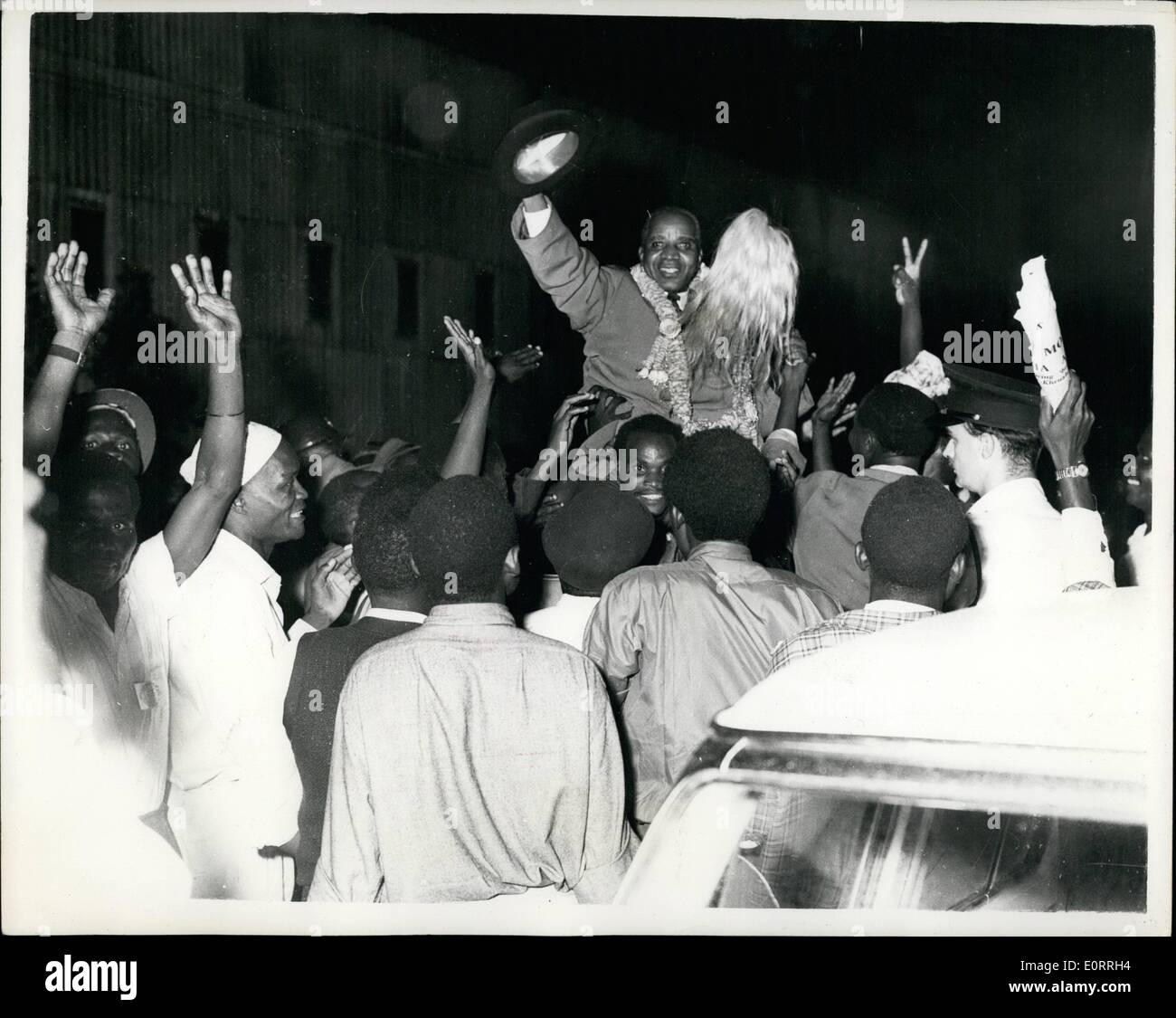 May 05, 1960 - Dr. Hasting Banda gets a great welcome on arrival in Mombasa: Dr. Hastings Banda the Nyassaland Leader gets a rousing reception from Lenya African Nationalists at the part of Mombasa... He waves a tribal fly-whisk at the crowd - while wearing a garland which was placed on his Nairobi. Stock Photohttps://www.alamy.com/image-license-details/?v=1https://www.alamy.com/may-05-1960-dr-hasting-banda-gets-a-great-welcome-on-arrival-in-mombasa-image69364880.html
May 05, 1960 - Dr. Hasting Banda gets a great welcome on arrival in Mombasa: Dr. Hastings Banda the Nyassaland Leader gets a rousing reception from Lenya African Nationalists at the part of Mombasa... He waves a tribal fly-whisk at the crowd - while wearing a garland which was placed on his Nairobi. Stock Photohttps://www.alamy.com/image-license-details/?v=1https://www.alamy.com/may-05-1960-dr-hasting-banda-gets-a-great-welcome-on-arrival-in-mombasa-image69364880.htmlRME0RRH4–May 05, 1960 - Dr. Hasting Banda gets a great welcome on arrival in Mombasa: Dr. Hastings Banda the Nyassaland Leader gets a rousing reception from Lenya African Nationalists at the part of Mombasa... He waves a tribal fly-whisk at the crowd - while wearing a garland which was placed on his Nairobi.
 The Goddess Purneshvari (1150-1200). Pala dynasty. Jaynagar, Bihar, North-East India, Basalt. This form of the Mother goddess was worshipped by both Buddhists and Hindus. She sits on a lotus throne and holds a child, a fly whisk and an elephant emblem. Stock Photohttps://www.alamy.com/image-license-details/?v=1https://www.alamy.com/stock-photo-the-goddess-purneshvari-1150-1200-pala-dynasty-jaynagar-bihar-north-57405640.html
The Goddess Purneshvari (1150-1200). Pala dynasty. Jaynagar, Bihar, North-East India, Basalt. This form of the Mother goddess was worshipped by both Buddhists and Hindus. She sits on a lotus throne and holds a child, a fly whisk and an elephant emblem. Stock Photohttps://www.alamy.com/image-license-details/?v=1https://www.alamy.com/stock-photo-the-goddess-purneshvari-1150-1200-pala-dynasty-jaynagar-bihar-north-57405640.htmlRMD9B1DC–The Goddess Purneshvari (1150-1200). Pala dynasty. Jaynagar, Bihar, North-East India, Basalt. This form of the Mother goddess was worshipped by both Buddhists and Hindus. She sits on a lotus throne and holds a child, a fly whisk and an elephant emblem.
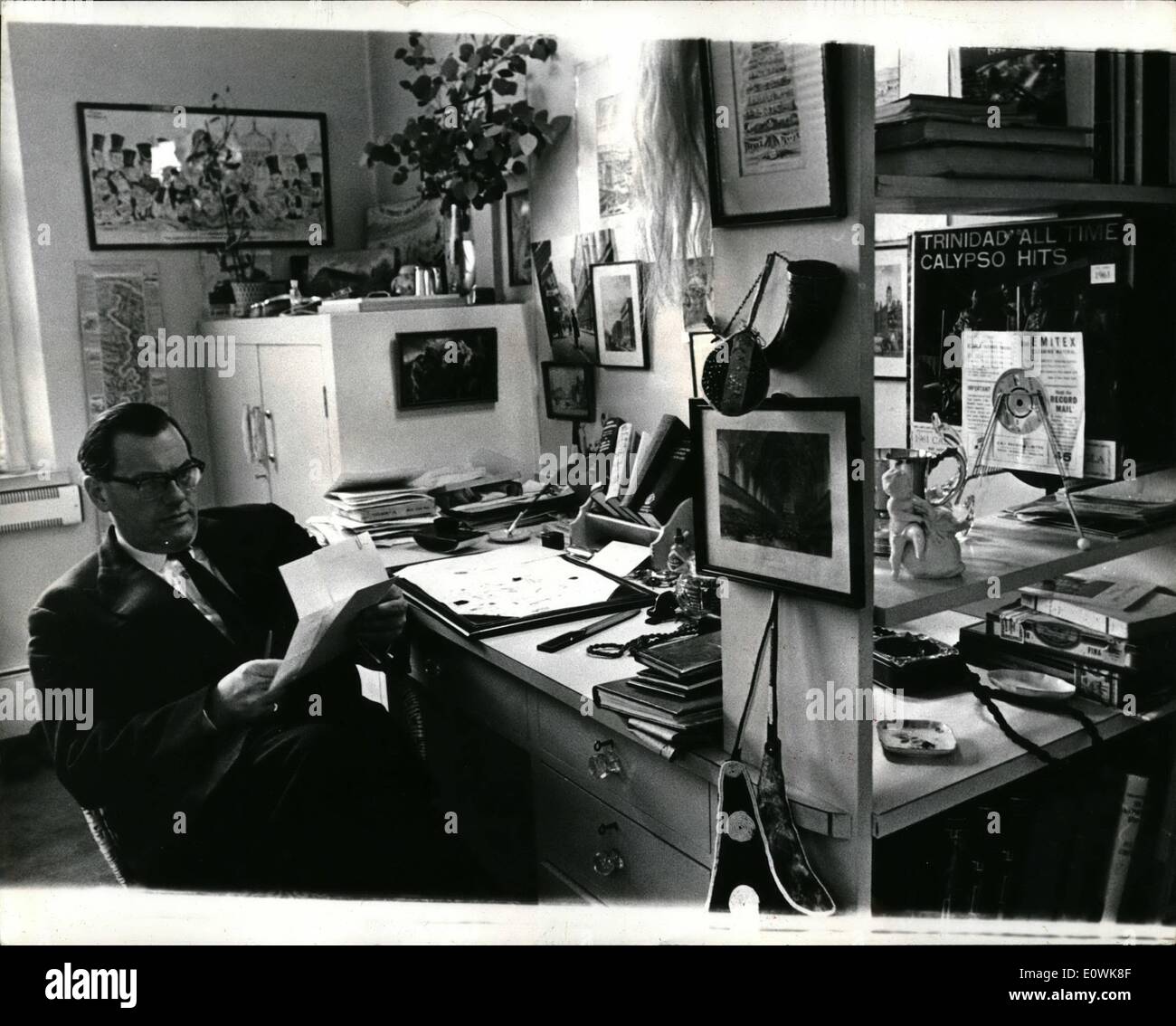 Apr. 04, 1963 - Mr. Maudling does his homework.: Chancellor of the Exchequer Mr. Reginald Maudling who presents his first budget on Wednesday has been doing plenty of preparatory work at his desk at home in Belgravia. The desk and its sorroundings contain many interesting trophies and souvenirs. His favourite record, a calypso - souvenir of a Caribbean holiday, the drinking horn, a gift from the people of Gerogia in Russia, the tribal chief's fly whisk is a souvenir from Mr. Maudling's days as Colonial secretary Stock Photohttps://www.alamy.com/image-license-details/?v=1https://www.alamy.com/apr-04-1963-mr-maudling-does-his-homework-chancellor-of-the-exchequer-image69405407.html
Apr. 04, 1963 - Mr. Maudling does his homework.: Chancellor of the Exchequer Mr. Reginald Maudling who presents his first budget on Wednesday has been doing plenty of preparatory work at his desk at home in Belgravia. The desk and its sorroundings contain many interesting trophies and souvenirs. His favourite record, a calypso - souvenir of a Caribbean holiday, the drinking horn, a gift from the people of Gerogia in Russia, the tribal chief's fly whisk is a souvenir from Mr. Maudling's days as Colonial secretary Stock Photohttps://www.alamy.com/image-license-details/?v=1https://www.alamy.com/apr-04-1963-mr-maudling-does-his-homework-chancellor-of-the-exchequer-image69405407.htmlRME0WK8F–Apr. 04, 1963 - Mr. Maudling does his homework.: Chancellor of the Exchequer Mr. Reginald Maudling who presents his first budget on Wednesday has been doing plenty of preparatory work at his desk at home in Belgravia. The desk and its sorroundings contain many interesting trophies and souvenirs. His favourite record, a calypso - souvenir of a Caribbean holiday, the drinking horn, a gift from the people of Gerogia in Russia, the tribal chief's fly whisk is a souvenir from Mr. Maudling's days as Colonial secretary
 Fly Whisk (Tahiri). Culture: Austral Islanders. Dimensions: W. 5 1/8 x L. 32 in. (13 x 81.3 cm). Date: early to mid-19th century. Artists of the Austral Islands created delicate fly whisks with handles adorned with stylized human figures that likely portray ancestors or other supernatural beings. This work depicts two highly stylized male figures who share a single teardrop-shaped body. The peg-like projections on the foreheads likely represent the ornamental topknots of hair formerly worn by Austral Islands men. As well as being symbols of chiefly status, it is likely that such finely crafte Stock Photohttps://www.alamy.com/image-license-details/?v=1https://www.alamy.com/fly-whisk-tahiri-culture-austral-islanders-dimensions-w-5-18-x-l-32-in-13-x-813-cm-date-early-to-mid-19th-century-artists-of-the-austral-islands-created-delicate-fly-whisks-with-handles-adorned-with-stylized-human-figures-that-likely-portray-ancestors-or-other-supernatural-beings-this-work-depicts-two-highly-stylized-male-figures-who-share-a-single-teardrop-shaped-body-the-peg-like-projections-on-the-foreheads-likely-represent-the-ornamental-topknots-of-hair-formerly-worn-by-austral-islands-men-as-well-as-being-symbols-of-chiefly-status-it-is-likely-that-such-finely-crafte-image213244567.html
Fly Whisk (Tahiri). Culture: Austral Islanders. Dimensions: W. 5 1/8 x L. 32 in. (13 x 81.3 cm). Date: early to mid-19th century. Artists of the Austral Islands created delicate fly whisks with handles adorned with stylized human figures that likely portray ancestors or other supernatural beings. This work depicts two highly stylized male figures who share a single teardrop-shaped body. The peg-like projections on the foreheads likely represent the ornamental topknots of hair formerly worn by Austral Islands men. As well as being symbols of chiefly status, it is likely that such finely crafte Stock Photohttps://www.alamy.com/image-license-details/?v=1https://www.alamy.com/fly-whisk-tahiri-culture-austral-islanders-dimensions-w-5-18-x-l-32-in-13-x-813-cm-date-early-to-mid-19th-century-artists-of-the-austral-islands-created-delicate-fly-whisks-with-handles-adorned-with-stylized-human-figures-that-likely-portray-ancestors-or-other-supernatural-beings-this-work-depicts-two-highly-stylized-male-figures-who-share-a-single-teardrop-shaped-body-the-peg-like-projections-on-the-foreheads-likely-represent-the-ornamental-topknots-of-hair-formerly-worn-by-austral-islands-men-as-well-as-being-symbols-of-chiefly-status-it-is-likely-that-such-finely-crafte-image213244567.htmlRMPAX3HB–Fly Whisk (Tahiri). Culture: Austral Islanders. Dimensions: W. 5 1/8 x L. 32 in. (13 x 81.3 cm). Date: early to mid-19th century. Artists of the Austral Islands created delicate fly whisks with handles adorned with stylized human figures that likely portray ancestors or other supernatural beings. This work depicts two highly stylized male figures who share a single teardrop-shaped body. The peg-like projections on the foreheads likely represent the ornamental topknots of hair formerly worn by Austral Islands men. As well as being symbols of chiefly status, it is likely that such finely crafte
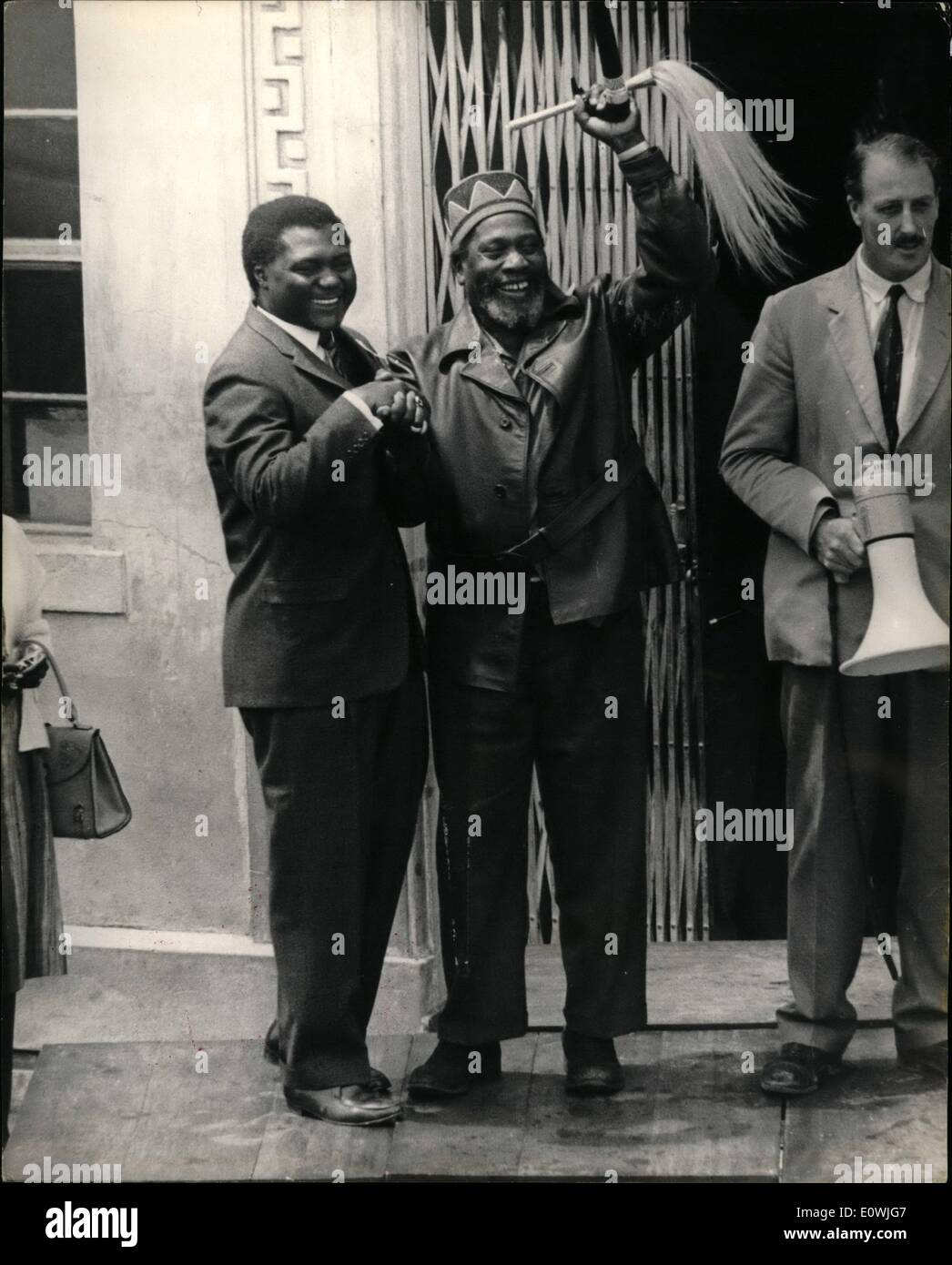 May 29, 1963 - 29-5-63 Kenya triumph for Kenyatta. In the recent elections in Kenya, Jomo Kenyatta's KANU party has scored a major success and has obtained a substantial majority in the House of Representatives, although in the Senate Mr. Ngala's KADU party opposition will be strong enough to act as a brake against hasty legislation. Jomo Kenyatta will probably be the first President of a Kenya Republic. Photo Shows: After the announcement of the election results, Jomo Kenyatta waves his fly whisk while he shakes hands with a jubilant Tom Mboya. Stock Photohttps://www.alamy.com/image-license-details/?v=1https://www.alamy.com/may-29-1963-29-5-63-kenya-triumph-for-kenyatta-in-the-recent-elections-image69404839.html
May 29, 1963 - 29-5-63 Kenya triumph for Kenyatta. In the recent elections in Kenya, Jomo Kenyatta's KANU party has scored a major success and has obtained a substantial majority in the House of Representatives, although in the Senate Mr. Ngala's KADU party opposition will be strong enough to act as a brake against hasty legislation. Jomo Kenyatta will probably be the first President of a Kenya Republic. Photo Shows: After the announcement of the election results, Jomo Kenyatta waves his fly whisk while he shakes hands with a jubilant Tom Mboya. Stock Photohttps://www.alamy.com/image-license-details/?v=1https://www.alamy.com/may-29-1963-29-5-63-kenya-triumph-for-kenyatta-in-the-recent-elections-image69404839.htmlRME0WJG7–May 29, 1963 - 29-5-63 Kenya triumph for Kenyatta. In the recent elections in Kenya, Jomo Kenyatta's KANU party has scored a major success and has obtained a substantial majority in the House of Representatives, although in the Senate Mr. Ngala's KADU party opposition will be strong enough to act as a brake against hasty legislation. Jomo Kenyatta will probably be the first President of a Kenya Republic. Photo Shows: After the announcement of the election results, Jomo Kenyatta waves his fly whisk while he shakes hands with a jubilant Tom Mboya.
 Fly whisk. In most of Africa, flywhisks were carried as prestige regalia and during masquerades. They emphasized both gestures and spoken words. Their materials tended to be made of inherantly status conferring materials. Stock Photohttps://www.alamy.com/image-license-details/?v=1https://www.alamy.com/fly-whisk-in-most-of-africa-flywhisks-were-carried-as-prestige-regalia-and-during-masquerades-they-emphasized-both-gestures-and-spoken-words-their-materials-tended-to-be-made-of-inherantly-status-conferring-materials-image353561243.html
Fly whisk. In most of Africa, flywhisks were carried as prestige regalia and during masquerades. They emphasized both gestures and spoken words. Their materials tended to be made of inherantly status conferring materials. Stock Photohttps://www.alamy.com/image-license-details/?v=1https://www.alamy.com/fly-whisk-in-most-of-africa-flywhisks-were-carried-as-prestige-regalia-and-during-masquerades-they-emphasized-both-gestures-and-spoken-words-their-materials-tended-to-be-made-of-inherantly-status-conferring-materials-image353561243.htmlRM2BF62Y7–Fly whisk. In most of Africa, flywhisks were carried as prestige regalia and during masquerades. They emphasized both gestures and spoken words. Their materials tended to be made of inherantly status conferring materials.
 Attendant Bearing a Fly Whisk (Chauri), c. 100-150. This graceful figure of a chauri -bearer (a whisk-bearing attendant) represents a late first- or early second-century variant of the Mathura style and derives from prototypes such as the yaksa from Parkham in the Mathura Museum. Kusana sculpture, while retaining the heavy sculptural volume and monumentality of the Maurya-Sunga style, has lost its rigidity here. The weight of the figure rests on the right leg, giving it a slight contrapposto stance and creating an easy, relaxed appearance. The geometrized forms predominant in pre-Kusana scu Stock Photohttps://www.alamy.com/image-license-details/?v=1https://www.alamy.com/attendant-bearing-a-fly-whisk-chauri-c-100-150-this-graceful-figure-of-a-chauri-bearer-a-whisk-bearing-attendant-represents-a-late-first-or-early-second-century-variant-of-the-mathura-style-and-derives-from-prototypes-such-as-the-yaksa-from-parkham-in-the-mathura-museum-kusana-sculpture-while-retaining-the-heavy-sculptural-volume-and-monumentality-of-the-maurya-sunga-style-has-lost-its-rigidity-here-the-weight-of-the-figure-rests-on-the-right-leg-giving-it-a-slight-contrapposto-stance-and-creating-an-easy-relaxed-appearance-the-geometrized-forms-predominant-in-pre-kusana-scu-image330136658.html
Attendant Bearing a Fly Whisk (Chauri), c. 100-150. This graceful figure of a chauri -bearer (a whisk-bearing attendant) represents a late first- or early second-century variant of the Mathura style and derives from prototypes such as the yaksa from Parkham in the Mathura Museum. Kusana sculpture, while retaining the heavy sculptural volume and monumentality of the Maurya-Sunga style, has lost its rigidity here. The weight of the figure rests on the right leg, giving it a slight contrapposto stance and creating an easy, relaxed appearance. The geometrized forms predominant in pre-Kusana scu Stock Photohttps://www.alamy.com/image-license-details/?v=1https://www.alamy.com/attendant-bearing-a-fly-whisk-chauri-c-100-150-this-graceful-figure-of-a-chauri-bearer-a-whisk-bearing-attendant-represents-a-late-first-or-early-second-century-variant-of-the-mathura-style-and-derives-from-prototypes-such-as-the-yaksa-from-parkham-in-the-mathura-museum-kusana-sculpture-while-retaining-the-heavy-sculptural-volume-and-monumentality-of-the-maurya-sunga-style-has-lost-its-rigidity-here-the-weight-of-the-figure-rests-on-the-right-leg-giving-it-a-slight-contrapposto-stance-and-creating-an-easy-relaxed-appearance-the-geometrized-forms-predominant-in-pre-kusana-scu-image330136658.htmlRM2A530JX–Attendant Bearing a Fly Whisk (Chauri), c. 100-150. This graceful figure of a chauri -bearer (a whisk-bearing attendant) represents a late first- or early second-century variant of the Mathura style and derives from prototypes such as the yaksa from Parkham in the Mathura Museum. Kusana sculpture, while retaining the heavy sculptural volume and monumentality of the Maurya-Sunga style, has lost its rigidity here. The weight of the figure rests on the right leg, giving it a slight contrapposto stance and creating an easy, relaxed appearance. The geometrized forms predominant in pre-Kusana scu
 PAPUA NEW GUINEA, Madang, lagoon, fish market , women with cool boxes and fly whisk / PAPUA NEUGUINEA, Madang, Fischmarkt Stock Photohttps://www.alamy.com/image-license-details/?v=1https://www.alamy.com/papua-new-guinea-madang-lagoon-fish-market-women-with-cool-boxes-and-fly-whisk-papua-neuguinea-madang-fischmarkt-image617085182.html
PAPUA NEW GUINEA, Madang, lagoon, fish market , women with cool boxes and fly whisk / PAPUA NEUGUINEA, Madang, Fischmarkt Stock Photohttps://www.alamy.com/image-license-details/?v=1https://www.alamy.com/papua-new-guinea-madang-lagoon-fish-market-women-with-cool-boxes-and-fly-whisk-papua-neuguinea-madang-fischmarkt-image617085182.htmlRM2XRXJCE–PAPUA NEW GUINEA, Madang, lagoon, fish market , women with cool boxes and fly whisk / PAPUA NEUGUINEA, Madang, Fischmarkt
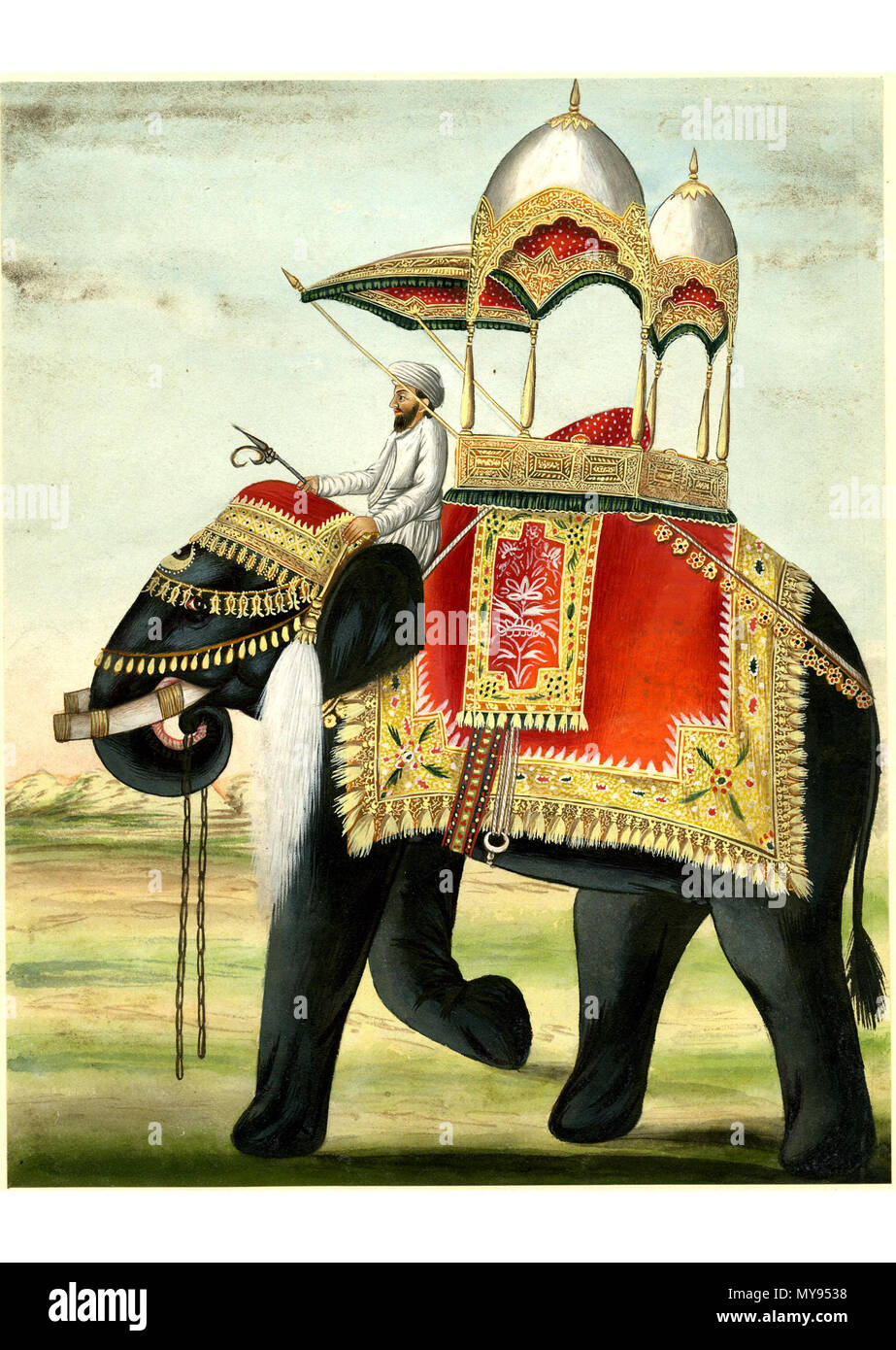 . English: Painting on paper of a decorated elephant with a howdah on its back. The elephant is adorned with a decorated saddle blanket and headdress. On its neck sits a mahout (driver), who holds an ankusha (elephant goad) and an elegant chauri (fly whisk). The howdah is lavishly decorated with textiles and tassels. The roof consists of two silver domes decorated with gold. The elephant is shown walking on a grassy terrain with hills in the distance. 19thC(early). Company School 18 A decorated elephant with a howdah on its back Stock Photohttps://www.alamy.com/image-license-details/?v=1https://www.alamy.com/english-painting-on-paper-of-a-decorated-elephant-with-a-howdah-on-its-back-the-elephant-is-adorned-with-a-decorated-saddle-blanket-and-headdress-on-its-neck-sits-a-mahout-driver-who-holds-an-ankusha-elephant-goad-and-an-elegant-chauri-fly-whisk-the-howdah-is-lavishly-decorated-with-textiles-and-tassels-the-roof-consists-of-two-silver-domes-decorated-with-gold-the-elephant-is-shown-walking-on-a-grassy-terrain-with-hills-in-the-distance-19thcearly-company-school-18-a-decorated-elephant-with-a-howdah-on-its-back-image188900972.html
. English: Painting on paper of a decorated elephant with a howdah on its back. The elephant is adorned with a decorated saddle blanket and headdress. On its neck sits a mahout (driver), who holds an ankusha (elephant goad) and an elegant chauri (fly whisk). The howdah is lavishly decorated with textiles and tassels. The roof consists of two silver domes decorated with gold. The elephant is shown walking on a grassy terrain with hills in the distance. 19thC(early). Company School 18 A decorated elephant with a howdah on its back Stock Photohttps://www.alamy.com/image-license-details/?v=1https://www.alamy.com/english-painting-on-paper-of-a-decorated-elephant-with-a-howdah-on-its-back-the-elephant-is-adorned-with-a-decorated-saddle-blanket-and-headdress-on-its-neck-sits-a-mahout-driver-who-holds-an-ankusha-elephant-goad-and-an-elegant-chauri-fly-whisk-the-howdah-is-lavishly-decorated-with-textiles-and-tassels-the-roof-consists-of-two-silver-domes-decorated-with-gold-the-elephant-is-shown-walking-on-a-grassy-terrain-with-hills-in-the-distance-19thcearly-company-school-18-a-decorated-elephant-with-a-howdah-on-its-back-image188900972.htmlRMMY9538–. English: Painting on paper of a decorated elephant with a howdah on its back. The elephant is adorned with a decorated saddle blanket and headdress. On its neck sits a mahout (driver), who holds an ankusha (elephant goad) and an elegant chauri (fly whisk). The howdah is lavishly decorated with textiles and tassels. The roof consists of two silver domes decorated with gold. The elephant is shown walking on a grassy terrain with hills in the distance. 19thC(early). Company School 18 A decorated elephant with a howdah on its back
 Bas-relief of a female deity wearing a long robe and holding a fly-whisk in her hand, Lolei Temple, Rolous Group, Angkor Stock Photohttps://www.alamy.com/image-license-details/?v=1https://www.alamy.com/bas-relief-of-a-female-deity-wearing-a-long-robe-and-holding-a-fly-image61868626.html
Bas-relief of a female deity wearing a long robe and holding a fly-whisk in her hand, Lolei Temple, Rolous Group, Angkor Stock Photohttps://www.alamy.com/image-license-details/?v=1https://www.alamy.com/bas-relief-of-a-female-deity-wearing-a-long-robe-and-holding-a-fly-image61868626.htmlRMDGJA1P–Bas-relief of a female deity wearing a long robe and holding a fly-whisk in her hand, Lolei Temple, Rolous Group, Angkor
 Ancient Egyptian hieroglyphic carving of a Pharaoh holding a flail, or fly whisk, and sceptre or crook. Temple of Horus at Edfu, Egypt. Stock Photohttps://www.alamy.com/image-license-details/?v=1https://www.alamy.com/ancient-egyptian-hieroglyphic-carving-of-a-pharaoh-holding-a-flail-or-fly-whisk-and-sceptre-or-crook-temple-of-horus-at-edfu-egypt-image402368324.html
Ancient Egyptian hieroglyphic carving of a Pharaoh holding a flail, or fly whisk, and sceptre or crook. Temple of Horus at Edfu, Egypt. Stock Photohttps://www.alamy.com/image-license-details/?v=1https://www.alamy.com/ancient-egyptian-hieroglyphic-carving-of-a-pharaoh-holding-a-flail-or-fly-whisk-and-sceptre-or-crook-temple-of-horus-at-edfu-egypt-image402368324.htmlRF2EAHCW8–Ancient Egyptian hieroglyphic carving of a Pharaoh holding a flail, or fly whisk, and sceptre or crook. Temple of Horus at Edfu, Egypt.
 The Khan of Kalat, Mir Mahmood Khan (ruled 1893 to 1931), seated. The Khan ruled Kalat, part of Balochistan or Baluchistan, now part of Pakistan. A servant with a fly-whisk attends him (left). Date: C.1900 Stock Photohttps://www.alamy.com/image-license-details/?v=1https://www.alamy.com/the-khan-of-kalat-mir-mahmood-khan-ruled-1893-to-1931-seated-the-khan-ruled-kalat-part-of-balochistan-or-baluchistan-now-part-of-pakistan-a-servant-with-a-fly-whisk-attends-him-left-date-c1900-image557105603.html
The Khan of Kalat, Mir Mahmood Khan (ruled 1893 to 1931), seated. The Khan ruled Kalat, part of Balochistan or Baluchistan, now part of Pakistan. A servant with a fly-whisk attends him (left). Date: C.1900 Stock Photohttps://www.alamy.com/image-license-details/?v=1https://www.alamy.com/the-khan-of-kalat-mir-mahmood-khan-ruled-1893-to-1931-seated-the-khan-ruled-kalat-part-of-balochistan-or-baluchistan-now-part-of-pakistan-a-servant-with-a-fly-whisk-attends-him-left-date-c1900-image557105603.htmlRM2RAA9TK–The Khan of Kalat, Mir Mahmood Khan (ruled 1893 to 1931), seated. The Khan ruled Kalat, part of Balochistan or Baluchistan, now part of Pakistan. A servant with a fly-whisk attends him (left). Date: C.1900
 An ancient egyptian hieroglyphic painted carving showing the falcon headed god Horus seated on a throne and holding a golden fly whisk. Before him are Stock Photohttps://www.alamy.com/image-license-details/?v=1https://www.alamy.com/an-ancient-egyptian-hieroglyphic-painted-carving-showing-the-falcon-headed-god-horus-seated-on-a-throne-and-holding-a-golden-fly-whisk-before-him-are-image417299973.html
An ancient egyptian hieroglyphic painted carving showing the falcon headed god Horus seated on a throne and holding a golden fly whisk. Before him are Stock Photohttps://www.alamy.com/image-license-details/?v=1https://www.alamy.com/an-ancient-egyptian-hieroglyphic-painted-carving-showing-the-falcon-headed-god-horus-seated-on-a-throne-and-holding-a-golden-fly-whisk-before-him-are-image417299973.htmlRF2F6WJAD–An ancient egyptian hieroglyphic painted carving showing the falcon headed god Horus seated on a throne and holding a golden fly whisk. Before him are
 Howrah, West Bengal, India - 5th October, 2022 : Hindu Priest worshipping Goddess Durga with chamor, fly whisk fan. Ashtami puja aarati at night. Stock Photohttps://www.alamy.com/image-license-details/?v=1https://www.alamy.com/howrah-west-bengal-india-5th-october-2022-hindu-priest-worshipping-goddess-durga-with-chamor-fly-whisk-fan-ashtami-puja-aarati-at-night-image575208856.html
Howrah, West Bengal, India - 5th October, 2022 : Hindu Priest worshipping Goddess Durga with chamor, fly whisk fan. Ashtami puja aarati at night. Stock Photohttps://www.alamy.com/image-license-details/?v=1https://www.alamy.com/howrah-west-bengal-india-5th-october-2022-hindu-priest-worshipping-goddess-durga-with-chamor-fly-whisk-fan-ashtami-puja-aarati-at-night-image575208856.htmlRF2TBR0NC–Howrah, West Bengal, India - 5th October, 2022 : Hindu Priest worshipping Goddess Durga with chamor, fly whisk fan. Ashtami puja aarati at night.
 fly whisk with human skull, wood, bone, leather, fiber, approximately L:25 in., African Art Stock Photohttps://www.alamy.com/image-license-details/?v=1https://www.alamy.com/fly-whisk-with-human-skull-wood-bone-leather-fiber-approximately-l25-in-african-art-image328774496.html
fly whisk with human skull, wood, bone, leather, fiber, approximately L:25 in., African Art Stock Photohttps://www.alamy.com/image-license-details/?v=1https://www.alamy.com/fly-whisk-with-human-skull-wood-bone-leather-fiber-approximately-l25-in-african-art-image328774496.htmlRM2A2TY68–fly whisk with human skull, wood, bone, leather, fiber, approximately L:25 in., African Art
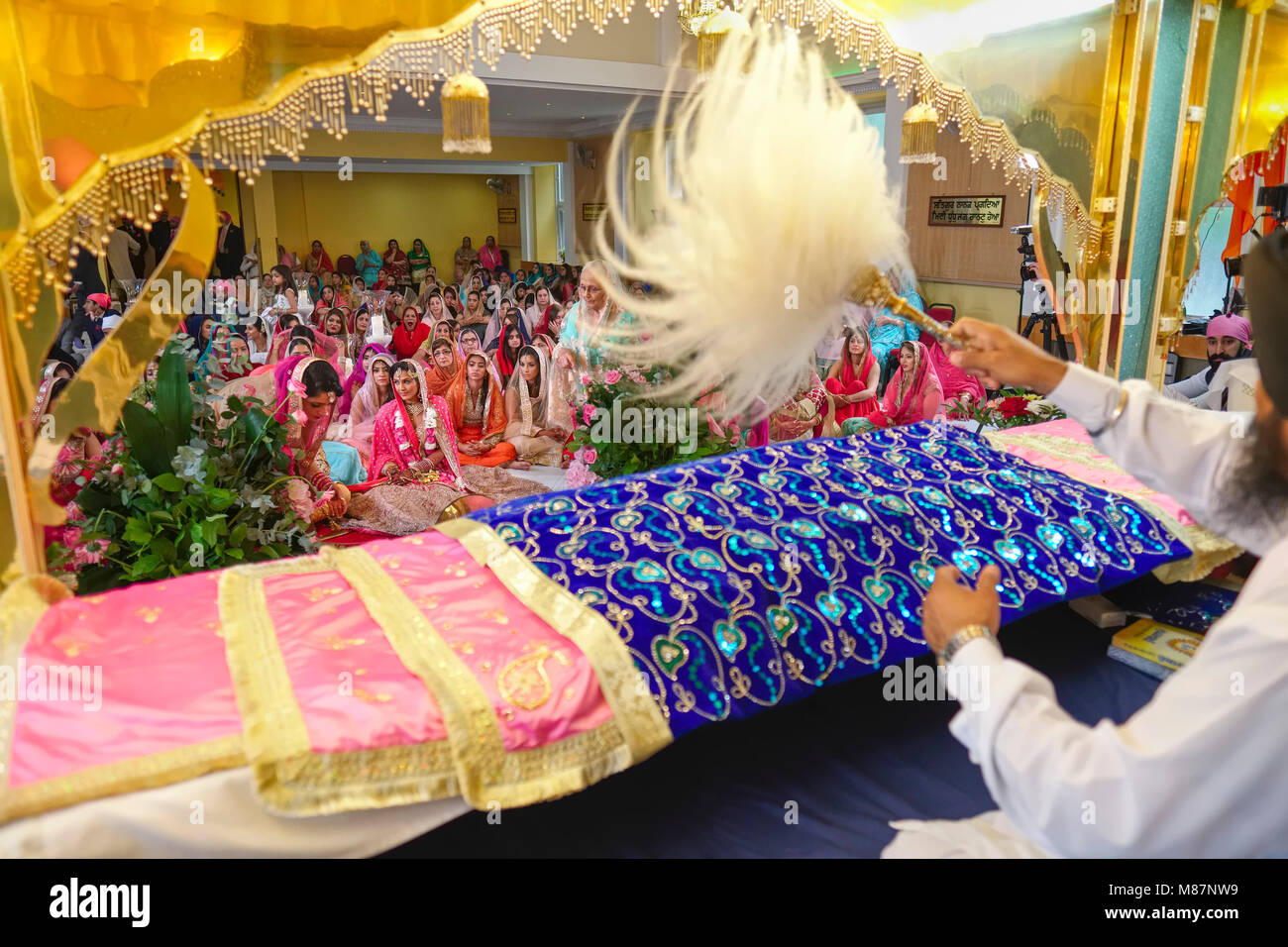 Sikh wedding ceremony in a Gurdwara with priest waving Chaur Sahib (fly whisk) above the holy book (Guru Granth Sahib) Stock Photohttps://www.alamy.com/image-license-details/?v=1https://www.alamy.com/stock-photo-sikh-wedding-ceremony-in-a-gurdwara-with-priest-waving-chaur-sahib-177191765.html
Sikh wedding ceremony in a Gurdwara with priest waving Chaur Sahib (fly whisk) above the holy book (Guru Granth Sahib) Stock Photohttps://www.alamy.com/image-license-details/?v=1https://www.alamy.com/stock-photo-sikh-wedding-ceremony-in-a-gurdwara-with-priest-waving-chaur-sahib-177191765.htmlRFM87NW9–Sikh wedding ceremony in a Gurdwara with priest waving Chaur Sahib (fly whisk) above the holy book (Guru Granth Sahib)
 JOMO KENYATTA AT LONDON AIRPORT WAVING FLY WHISK / 6 NOVEMBER 1961 Stock Photohttps://www.alamy.com/image-license-details/?v=1https://www.alamy.com/jomo-kenyatta-at-london-airport-waving-fly-whisk-6-november-1961-image623800472.html
JOMO KENYATTA AT LONDON AIRPORT WAVING FLY WHISK / 6 NOVEMBER 1961 Stock Photohttps://www.alamy.com/image-license-details/?v=1https://www.alamy.com/jomo-kenyatta-at-london-airport-waving-fly-whisk-6-november-1961-image623800472.htmlRM2Y6TFT8–JOMO KENYATTA AT LONDON AIRPORT WAVING FLY WHISK / 6 NOVEMBER 1961
 Stick and fly whisk hawkers Stock Photohttps://www.alamy.com/image-license-details/?v=1https://www.alamy.com/stock-photo-stick-and-fly-whisk-hawkers-54302017.html
Stick and fly whisk hawkers Stock Photohttps://www.alamy.com/image-license-details/?v=1https://www.alamy.com/stock-photo-stick-and-fly-whisk-hawkers-54302017.htmlRMD49JNN–Stick and fly whisk hawkers
 JOMO KENYATTA FLY WHISK GREETED IN NAIROBI / 6 SEPTEMBER 1961 Stock Photohttps://www.alamy.com/image-license-details/?v=1https://www.alamy.com/jomo-kenyatta-fly-whisk-greeted-in-nairobi-6-september-1961-image623807538.html
JOMO KENYATTA FLY WHISK GREETED IN NAIROBI / 6 SEPTEMBER 1961 Stock Photohttps://www.alamy.com/image-license-details/?v=1https://www.alamy.com/jomo-kenyatta-fly-whisk-greeted-in-nairobi-6-september-1961-image623807538.htmlRM2Y6TTTJ–JOMO KENYATTA FLY WHISK GREETED IN NAIROBI / 6 SEPTEMBER 1961
 Ritual Fly Whisk LACMA AC1998.136.1 Stock Photohttps://www.alamy.com/image-license-details/?v=1https://www.alamy.com/stock-photo-ritual-fly-whisk-lacma-ac19981361-58169498.html
Ritual Fly Whisk LACMA AC1998.136.1 Stock Photohttps://www.alamy.com/image-license-details/?v=1https://www.alamy.com/stock-photo-ritual-fly-whisk-lacma-ac19981361-58169498.htmlRMDAHRP2–Ritual Fly Whisk LACMA AC1998.136.1
 From far Baluchistan . The Khan of Khelat with his advisor and body servant , whose duty it is to ply the fly whisk . 14 September 1927 Stock Photohttps://www.alamy.com/image-license-details/?v=1https://www.alamy.com/from-far-baluchistan-the-khan-of-khelat-with-his-advisor-and-body-servant-whose-duty-it-is-to-ply-the-fly-whisk-14-september-1927-image359450087.html
From far Baluchistan . The Khan of Khelat with his advisor and body servant , whose duty it is to ply the fly whisk . 14 September 1927 Stock Photohttps://www.alamy.com/image-license-details/?v=1https://www.alamy.com/from-far-baluchistan-the-khan-of-khelat-with-his-advisor-and-body-servant-whose-duty-it-is-to-ply-the-fly-whisk-14-september-1927-image359450087.htmlRM2BTPA73–From far Baluchistan . The Khan of Khelat with his advisor and body servant , whose duty it is to ply the fly whisk . 14 September 1927
 Giraffe (Giraffa camelopardalis angolensis). Tail in action, flicking away flies, causing symbiotc, commensal, Red-billed Oxpeckers (Buphagus erythorh Stock Photohttps://www.alamy.com/image-license-details/?v=1https://www.alamy.com/giraffe-giraffa-camelopardalis-angolensis-tail-in-action-flicking-away-flies-causing-symbiotc-commensal-red-billed-oxpeckers-buphagus-erythorh-image178086664.html
Giraffe (Giraffa camelopardalis angolensis). Tail in action, flicking away flies, causing symbiotc, commensal, Red-billed Oxpeckers (Buphagus erythorh Stock Photohttps://www.alamy.com/image-license-details/?v=1https://www.alamy.com/giraffe-giraffa-camelopardalis-angolensis-tail-in-action-flicking-away-flies-causing-symbiotc-commensal-red-billed-oxpeckers-buphagus-erythorh-image178086664.htmlRMM9MFA0–Giraffe (Giraffa camelopardalis angolensis). Tail in action, flicking away flies, causing symbiotc, commensal, Red-billed Oxpeckers (Buphagus erythorh
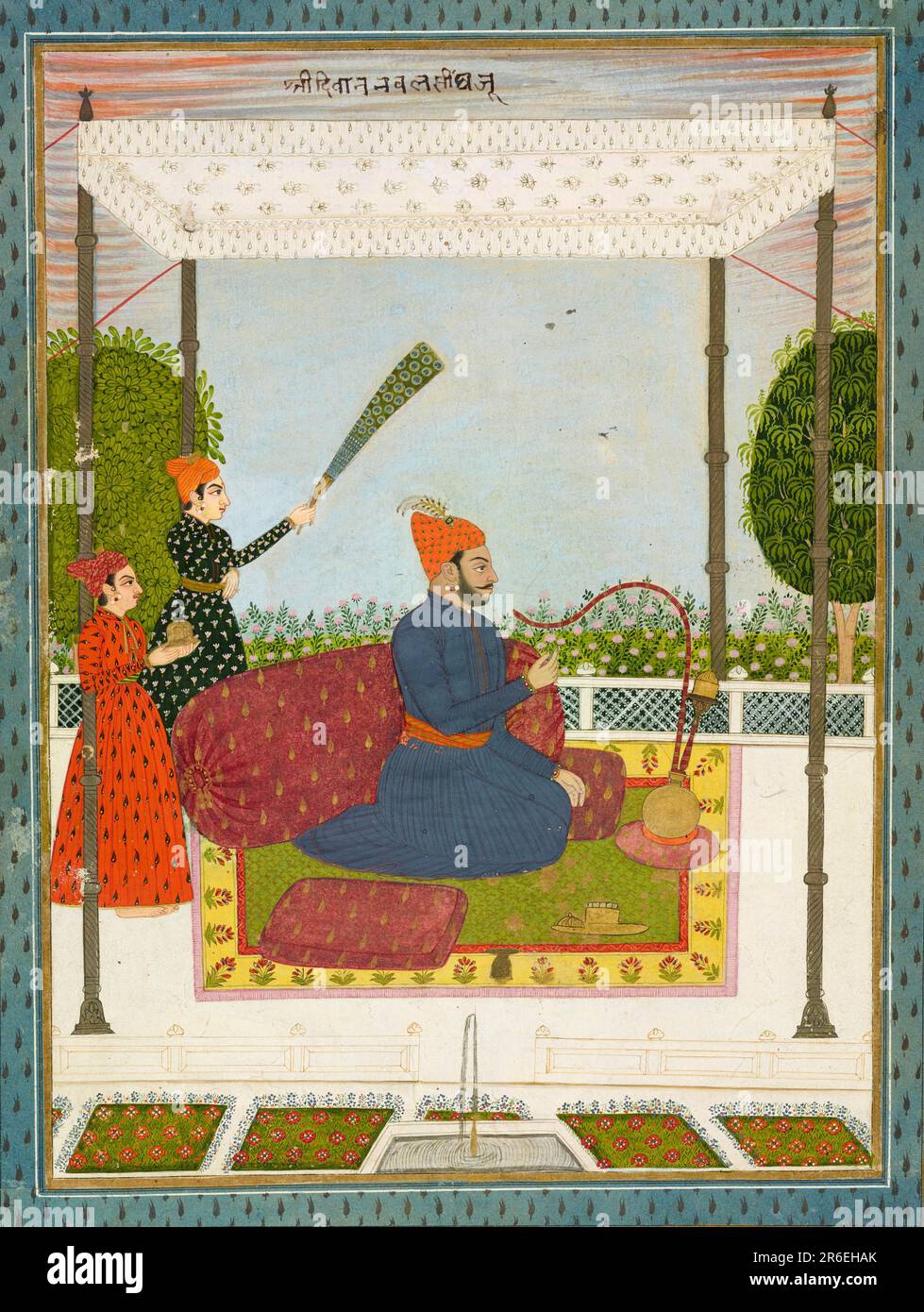 Dressed in an ink blue jama and a rich orange turban with a matching wave-patterned (leheriya) sash (patka), Nawal Singh sits beneath a cool white canopy. An enormous amber-colored bolster with gold leaf-shaped motifs supports him. Suitable to his status, attendants wait on him and one waves a peacock feathered fly-whisk (morchal), a symbol of royalty. Date: ca. 1750. Opaque watercolor and gold on paper. Origin: Datia, Madhya Pradesh state, India. Museum: Freer Gallery of Art and Arthur M. Sackler Gallery. Stock Photohttps://www.alamy.com/image-license-details/?v=1https://www.alamy.com/dressed-in-an-ink-blue-jama-and-a-rich-orange-turban-with-a-matching-wave-patterned-leheriya-sash-patka-nawal-singh-sits-beneath-a-cool-white-canopy-an-enormous-amber-colored-bolster-with-gold-leaf-shaped-motifs-supports-him-suitable-to-his-status-attendants-wait-on-him-and-one-waves-a-peacock-feathered-fly-whisk-morchal-a-symbol-of-royalty-date-ca-1750-opaque-watercolor-and-gold-on-paper-origin-datia-madhya-pradesh-state-india-museum-freer-gallery-of-art-and-arthur-m-sackler-gallery-image554740667.html
Dressed in an ink blue jama and a rich orange turban with a matching wave-patterned (leheriya) sash (patka), Nawal Singh sits beneath a cool white canopy. An enormous amber-colored bolster with gold leaf-shaped motifs supports him. Suitable to his status, attendants wait on him and one waves a peacock feathered fly-whisk (morchal), a symbol of royalty. Date: ca. 1750. Opaque watercolor and gold on paper. Origin: Datia, Madhya Pradesh state, India. Museum: Freer Gallery of Art and Arthur M. Sackler Gallery. Stock Photohttps://www.alamy.com/image-license-details/?v=1https://www.alamy.com/dressed-in-an-ink-blue-jama-and-a-rich-orange-turban-with-a-matching-wave-patterned-leheriya-sash-patka-nawal-singh-sits-beneath-a-cool-white-canopy-an-enormous-amber-colored-bolster-with-gold-leaf-shaped-motifs-supports-him-suitable-to-his-status-attendants-wait-on-him-and-one-waves-a-peacock-feathered-fly-whisk-morchal-a-symbol-of-royalty-date-ca-1750-opaque-watercolor-and-gold-on-paper-origin-datia-madhya-pradesh-state-india-museum-freer-gallery-of-art-and-arthur-m-sackler-gallery-image554740667.htmlRM2R6EHAK–Dressed in an ink blue jama and a rich orange turban with a matching wave-patterned (leheriya) sash (patka), Nawal Singh sits beneath a cool white canopy. An enormous amber-colored bolster with gold leaf-shaped motifs supports him. Suitable to his status, attendants wait on him and one waves a peacock feathered fly-whisk (morchal), a symbol of royalty. Date: ca. 1750. Opaque watercolor and gold on paper. Origin: Datia, Madhya Pradesh state, India. Museum: Freer Gallery of Art and Arthur M. Sackler Gallery.
 Black dancers who simulate skeletons with roped cowrie shells: the strange finery of the Bobos of French Sudan one carrying a fly whisk to add to his dignity February 1939 ©2004 Topfoto Stock Photohttps://www.alamy.com/image-license-details/?v=1https://www.alamy.com/black-dancers-who-simulate-skeletons-with-roped-cowrie-shells-the-strange-finery-of-the-bobos-of-french-sudan-one-carrying-a-fly-whisk-to-add-to-his-dignity-february-1939-2004-topfoto-image623739974.html
Black dancers who simulate skeletons with roped cowrie shells: the strange finery of the Bobos of French Sudan one carrying a fly whisk to add to his dignity February 1939 ©2004 Topfoto Stock Photohttps://www.alamy.com/image-license-details/?v=1https://www.alamy.com/black-dancers-who-simulate-skeletons-with-roped-cowrie-shells-the-strange-finery-of-the-bobos-of-french-sudan-one-carrying-a-fly-whisk-to-add-to-his-dignity-february-1939-2004-topfoto-image623739974.htmlRM2Y6NPKJ–Black dancers who simulate skeletons with roped cowrie shells: the strange finery of the Bobos of French Sudan one carrying a fly whisk to add to his dignity February 1939 ©2004 Topfoto
 CHAPMAN'S ZEBRA (Equus burchelli chapmani). Marwell Zoo Park, Hampshire, England. Stock Photohttps://www.alamy.com/image-license-details/?v=1https://www.alamy.com/chapmans-zebra-equus-burchelli-chapmani-marwell-zoo-park-hampshire-england-image332772971.html
CHAPMAN'S ZEBRA (Equus burchelli chapmani). Marwell Zoo Park, Hampshire, England. Stock Photohttps://www.alamy.com/image-license-details/?v=1https://www.alamy.com/chapmans-zebra-equus-burchelli-chapmani-marwell-zoo-park-hampshire-england-image332772971.htmlRM2A9B38Y–CHAPMAN'S ZEBRA (Equus burchelli chapmani). Marwell Zoo Park, Hampshire, England.
 IVORY COAST - CIRCA 1976: a stamp printed in Ivory Coast shows Fly Whisk and Panga Knife, Symbols of Akans Royal Family, circa 1976 Stock Photohttps://www.alamy.com/image-license-details/?v=1https://www.alamy.com/ivory-coast-circa-1976-a-stamp-printed-in-ivory-coast-shows-fly-whisk-and-panga-knife-symbols-of-akans-royal-family-circa-1976-image468363409.html
IVORY COAST - CIRCA 1976: a stamp printed in Ivory Coast shows Fly Whisk and Panga Knife, Symbols of Akans Royal Family, circa 1976 Stock Photohttps://www.alamy.com/image-license-details/?v=1https://www.alamy.com/ivory-coast-circa-1976-a-stamp-printed-in-ivory-coast-shows-fly-whisk-and-panga-knife-symbols-of-akans-royal-family-circa-1976-image468363409.htmlRF2J5YP8H–IVORY COAST - CIRCA 1976: a stamp printed in Ivory Coast shows Fly Whisk and Panga Knife, Symbols of Akans Royal Family, circa 1976
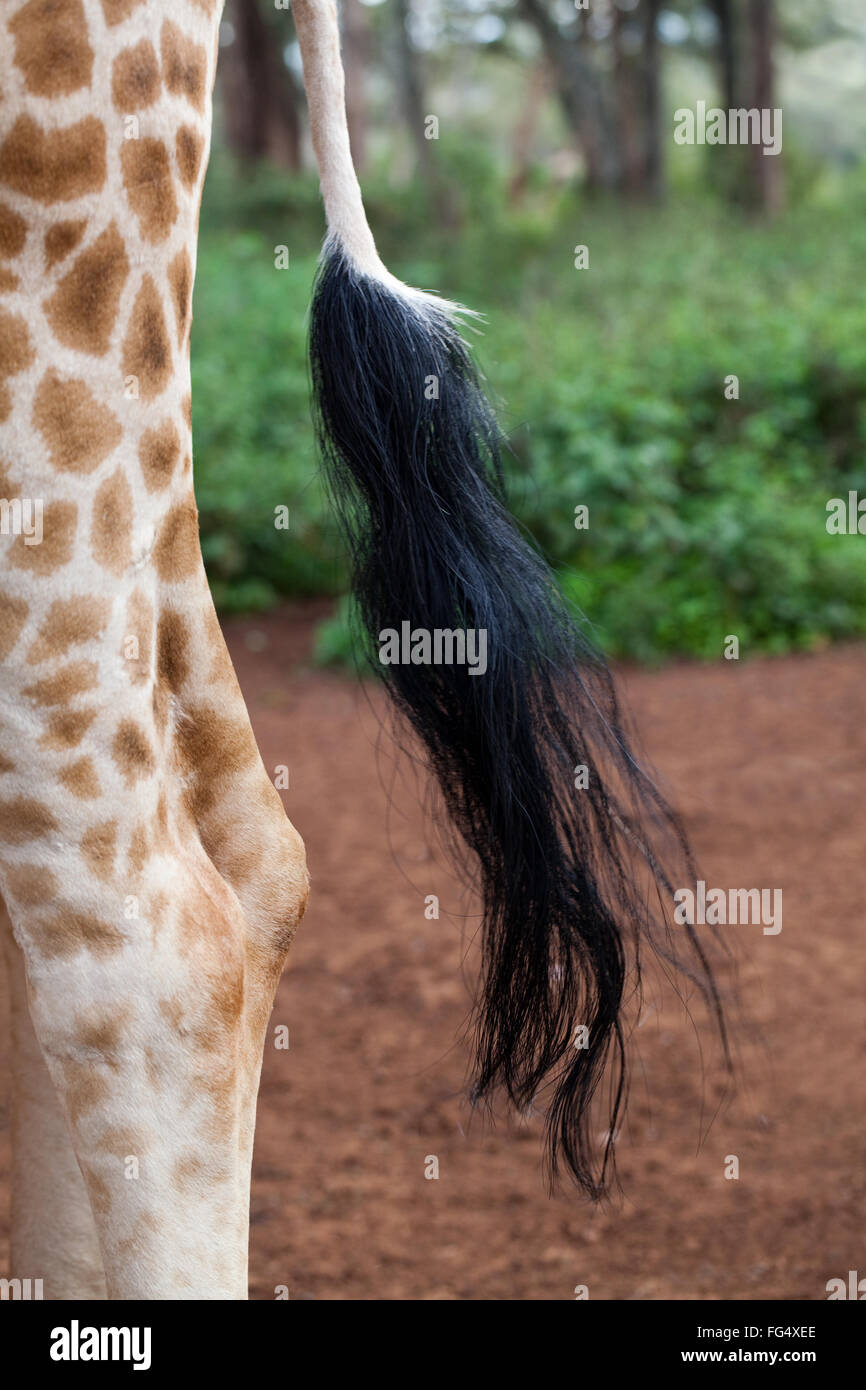 Reticulated Giraffe (Giraffa camelopardalis reticulata). Left hind leg and tail, a 'fly whisk'. Stock Photohttps://www.alamy.com/image-license-details/?v=1https://www.alamy.com/stock-photo-reticulated-giraffe-giraffa-camelopardalis-reticulata-left-hind-leg-95994934.html
Reticulated Giraffe (Giraffa camelopardalis reticulata). Left hind leg and tail, a 'fly whisk'. Stock Photohttps://www.alamy.com/image-license-details/?v=1https://www.alamy.com/stock-photo-reticulated-giraffe-giraffa-camelopardalis-reticulata-left-hind-leg-95994934.htmlRMFG4XEE–Reticulated Giraffe (Giraffa camelopardalis reticulata). Left hind leg and tail, a 'fly whisk'.
 . English: Painting on paper of a decorated elephant with a howdah on its back. The elephant is adorned with a decorated saddle blanket and headdress. On its neck sits a mahout (driver), who holds an ankusha (elephant goad) and an elegant chauri (fly whisk). The howdah is lavishly decorated with textiles and tassels. The roof consists of two silver domes decorated with gold. The elephant is shown walking on a grassy terrain with hills in the distance. 19thC(early). Company School 20 A decorated elephant with a howdah on its back Stock Photohttps://www.alamy.com/image-license-details/?v=1https://www.alamy.com/english-painting-on-paper-of-a-decorated-elephant-with-a-howdah-on-its-back-the-elephant-is-adorned-with-a-decorated-saddle-blanket-and-headdress-on-its-neck-sits-a-mahout-driver-who-holds-an-ankusha-elephant-goad-and-an-elegant-chauri-fly-whisk-the-howdah-is-lavishly-decorated-with-textiles-and-tassels-the-roof-consists-of-two-silver-domes-decorated-with-gold-the-elephant-is-shown-walking-on-a-grassy-terrain-with-hills-in-the-distance-19thcearly-company-school-20-a-decorated-elephant-with-a-howdah-on-its-back-image187624465.html
. English: Painting on paper of a decorated elephant with a howdah on its back. The elephant is adorned with a decorated saddle blanket and headdress. On its neck sits a mahout (driver), who holds an ankusha (elephant goad) and an elegant chauri (fly whisk). The howdah is lavishly decorated with textiles and tassels. The roof consists of two silver domes decorated with gold. The elephant is shown walking on a grassy terrain with hills in the distance. 19thC(early). Company School 20 A decorated elephant with a howdah on its back Stock Photohttps://www.alamy.com/image-license-details/?v=1https://www.alamy.com/english-painting-on-paper-of-a-decorated-elephant-with-a-howdah-on-its-back-the-elephant-is-adorned-with-a-decorated-saddle-blanket-and-headdress-on-its-neck-sits-a-mahout-driver-who-holds-an-ankusha-elephant-goad-and-an-elegant-chauri-fly-whisk-the-howdah-is-lavishly-decorated-with-textiles-and-tassels-the-roof-consists-of-two-silver-domes-decorated-with-gold-the-elephant-is-shown-walking-on-a-grassy-terrain-with-hills-in-the-distance-19thcearly-company-school-20-a-decorated-elephant-with-a-howdah-on-its-back-image187624465.htmlRMMW70WN–. English: Painting on paper of a decorated elephant with a howdah on its back. The elephant is adorned with a decorated saddle blanket and headdress. On its neck sits a mahout (driver), who holds an ankusha (elephant goad) and an elegant chauri (fly whisk). The howdah is lavishly decorated with textiles and tassels. The roof consists of two silver domes decorated with gold. The elephant is shown walking on a grassy terrain with hills in the distance. 19thC(early). Company School 20 A decorated elephant with a howdah on its back
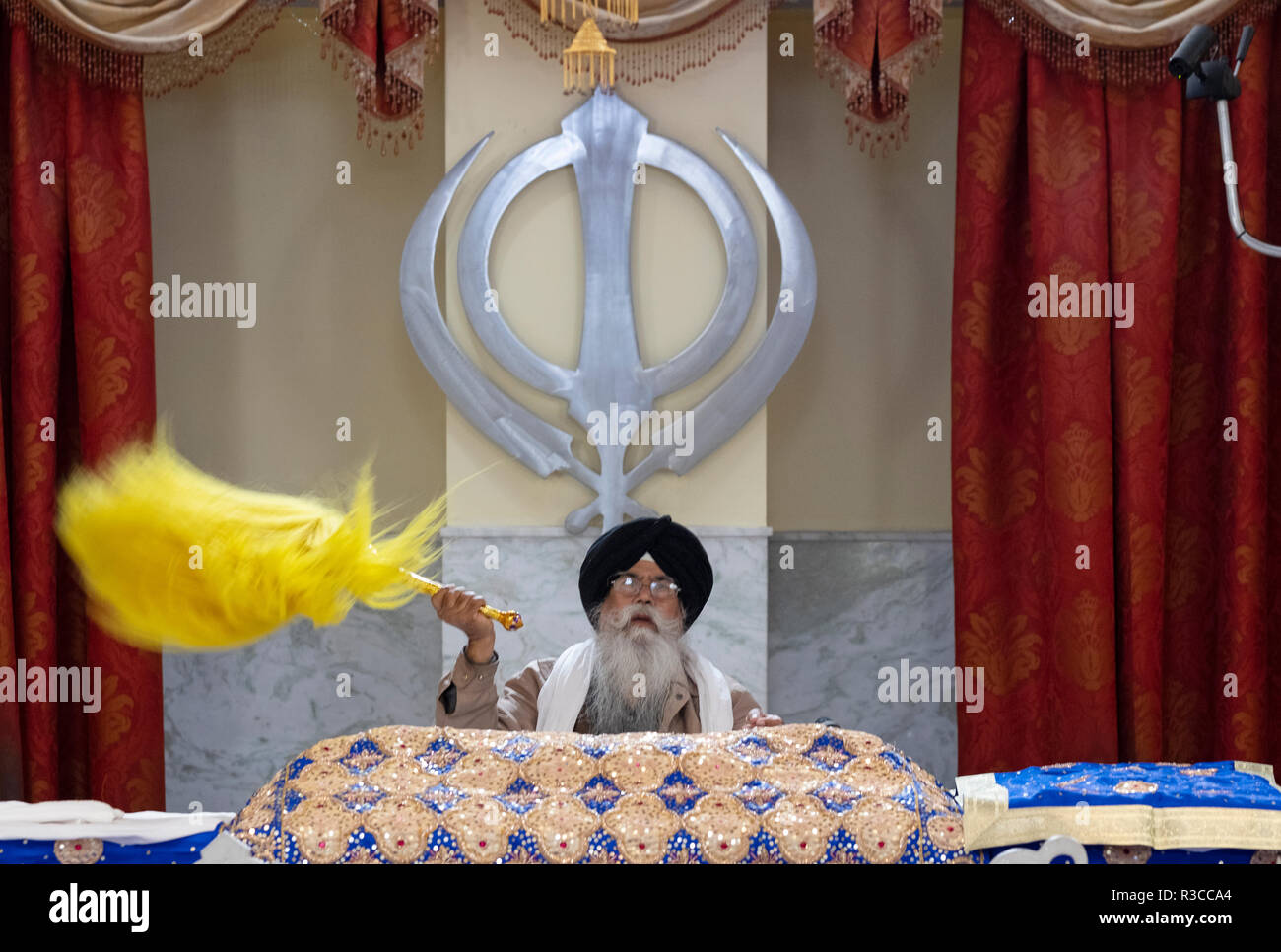 A Sikh priest waving a yellow flag - chaur sahib - during afternoon services at a temple in Richmond Hill, Queens, New York. Stock Photohttps://www.alamy.com/image-license-details/?v=1https://www.alamy.com/a-sikh-priest-waving-a-yellow-flag-chaur-sahib-during-afternoon-services-at-a-temple-in-richmond-hill-queens-new-york-image225851868.html
A Sikh priest waving a yellow flag - chaur sahib - during afternoon services at a temple in Richmond Hill, Queens, New York. Stock Photohttps://www.alamy.com/image-license-details/?v=1https://www.alamy.com/a-sikh-priest-waving-a-yellow-flag-chaur-sahib-during-afternoon-services-at-a-temple-in-richmond-hill-queens-new-york-image225851868.htmlRMR3CCA4–A Sikh priest waving a yellow flag - chaur sahib - during afternoon services at a temple in Richmond Hill, Queens, New York.
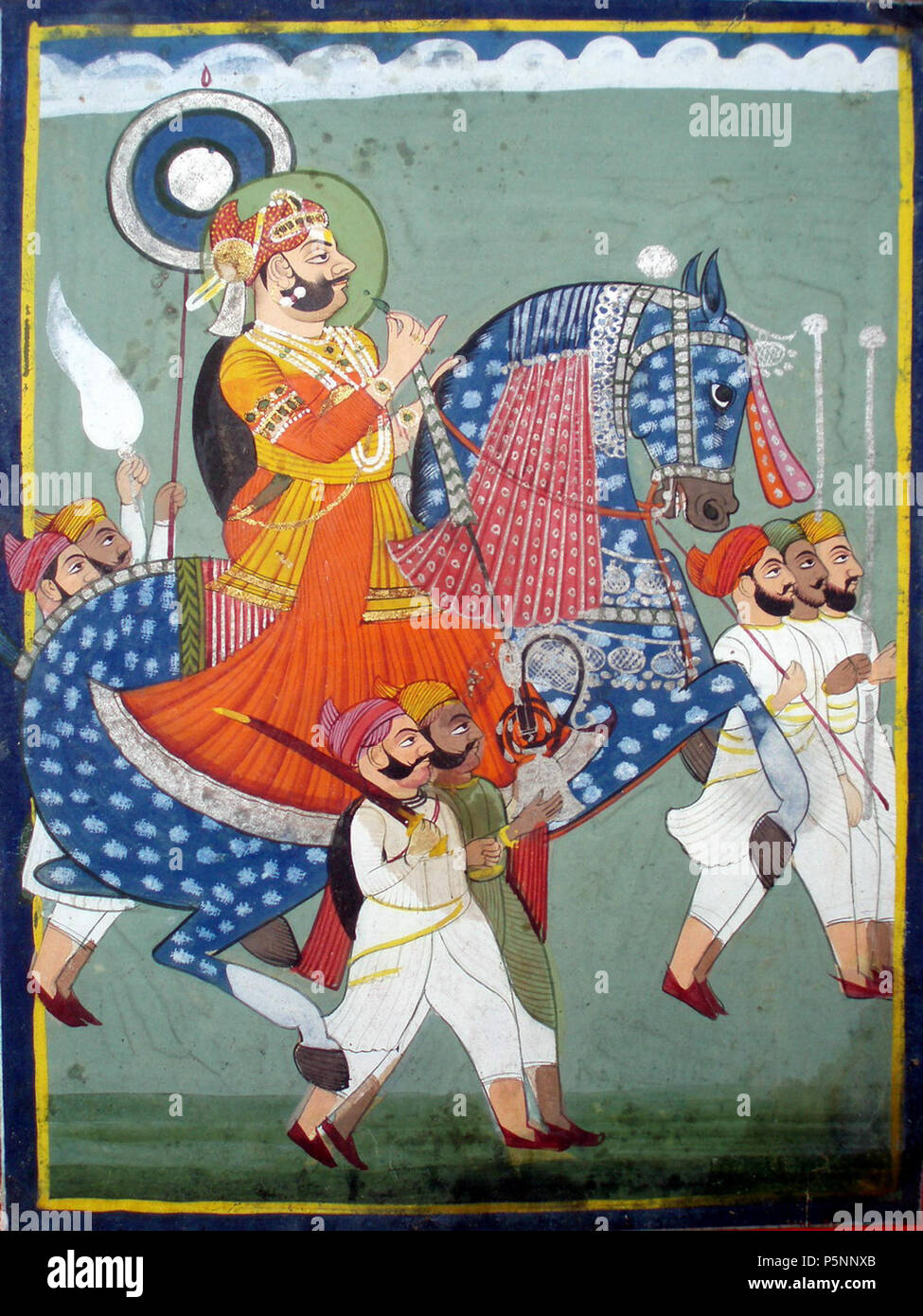 N/A. English: Equestrian portait of Maharaja Man Singh of Jodhpur, from between 1820 to 1840. The Maharaja rides his dappled horse whilst smoking a silver hookah, held by an attendant in the foreground, where another carries a sword. To the front of the horse - between its raised hooves, actually! - are three other attendants, two with silver staffs and one with a spear. To the rear are two more attendants, one with a chauri - fly whisk - the other with a disc-shaped banner with concentric circles of blue and silver. between 1820 and 1840. Unknown 520 Equestrian portait of Maharaja Man Singh o Stock Photohttps://www.alamy.com/image-license-details/?v=1https://www.alamy.com/na-english-equestrian-portait-of-maharaja-man-singh-of-jodhpur-from-between-1820-to-1840-the-maharaja-rides-his-dappled-horse-whilst-smoking-a-silver-hookah-held-by-an-attendant-in-the-foreground-where-another-carries-a-sword-to-the-front-of-the-horse-between-its-raised-hooves-actually!-are-three-other-attendants-two-with-silver-staffs-and-one-with-a-spear-to-the-rear-are-two-more-attendants-one-with-a-chauri-fly-whisk-the-other-with-a-disc-shaped-banner-with-concentric-circles-of-blue-and-silver-between-1820-and-1840-unknown-520-equestrian-portait-of-maharaja-man-singh-o-image210075891.html
N/A. English: Equestrian portait of Maharaja Man Singh of Jodhpur, from between 1820 to 1840. The Maharaja rides his dappled horse whilst smoking a silver hookah, held by an attendant in the foreground, where another carries a sword. To the front of the horse - between its raised hooves, actually! - are three other attendants, two with silver staffs and one with a spear. To the rear are two more attendants, one with a chauri - fly whisk - the other with a disc-shaped banner with concentric circles of blue and silver. between 1820 and 1840. Unknown 520 Equestrian portait of Maharaja Man Singh o Stock Photohttps://www.alamy.com/image-license-details/?v=1https://www.alamy.com/na-english-equestrian-portait-of-maharaja-man-singh-of-jodhpur-from-between-1820-to-1840-the-maharaja-rides-his-dappled-horse-whilst-smoking-a-silver-hookah-held-by-an-attendant-in-the-foreground-where-another-carries-a-sword-to-the-front-of-the-horse-between-its-raised-hooves-actually!-are-three-other-attendants-two-with-silver-staffs-and-one-with-a-spear-to-the-rear-are-two-more-attendants-one-with-a-chauri-fly-whisk-the-other-with-a-disc-shaped-banner-with-concentric-circles-of-blue-and-silver-between-1820-and-1840-unknown-520-equestrian-portait-of-maharaja-man-singh-o-image210075891.htmlRMP5NNXB–N/A. English: Equestrian portait of Maharaja Man Singh of Jodhpur, from between 1820 to 1840. The Maharaja rides his dappled horse whilst smoking a silver hookah, held by an attendant in the foreground, where another carries a sword. To the front of the horse - between its raised hooves, actually! - are three other attendants, two with silver staffs and one with a spear. To the rear are two more attendants, one with a chauri - fly whisk - the other with a disc-shaped banner with concentric circles of blue and silver. between 1820 and 1840. Unknown 520 Equestrian portait of Maharaja Man Singh o
 Domestic horse making use of another horse's tail as fly whisk. UK. Stock Photohttps://www.alamy.com/image-license-details/?v=1https://www.alamy.com/stock-photo-domestic-horse-making-use-of-another-horses-tail-as-fly-whisk-uk-71418534.html
Domestic horse making use of another horse's tail as fly whisk. UK. Stock Photohttps://www.alamy.com/image-license-details/?v=1https://www.alamy.com/stock-photo-domestic-horse-making-use-of-another-horses-tail-as-fly-whisk-uk-71418534.htmlRME45B1X–Domestic horse making use of another horse's tail as fly whisk. UK.
 Shiva and Parvati on a composite cow made of assembled women - Unknown, Rajasthan School - Google Cultural Institute . English: A man playing a musical instrument leads the procession followed by Shiva and Parvati seated on a cow. Four-armed Ganesh follows them with a fly-whisk, attending the royal couple. This narikunjan (composite creature made of assembled women) is very typical of Indian art. Miniature Painting by unknown artist, Rajasthan School. Natural pigment on paper, 18 X 25 cm. . between 1775 and 1800. 1115 Shiva and Parvati on a composite cow made of assembled women - Unknown, R Stock Photohttps://www.alamy.com/image-license-details/?v=1https://www.alamy.com/shiva-and-parvati-on-a-composite-cow-made-of-assembled-women-unknown-rajasthan-school-google-cultural-institute-english-a-man-playing-a-musical-instrument-leads-the-procession-followed-by-shiva-and-parvati-seated-on-a-cow-four-armed-ganesh-follows-them-with-a-fly-whisk-attending-the-royal-couple-this-narikunjan-composite-creature-made-of-assembled-women-is-very-typical-of-indian-art-miniature-painting-by-unknown-artist-rajasthan-school-natural-pigment-on-paper-18-x-25-cm-between-1775-and-1800-1115-shiva-and-parvati-on-a-composite-cow-made-of-assembled-women-unknown-r-image185588971.html
Shiva and Parvati on a composite cow made of assembled women - Unknown, Rajasthan School - Google Cultural Institute . English: A man playing a musical instrument leads the procession followed by Shiva and Parvati seated on a cow. Four-armed Ganesh follows them with a fly-whisk, attending the royal couple. This narikunjan (composite creature made of assembled women) is very typical of Indian art. Miniature Painting by unknown artist, Rajasthan School. Natural pigment on paper, 18 X 25 cm. . between 1775 and 1800. 1115 Shiva and Parvati on a composite cow made of assembled women - Unknown, R Stock Photohttps://www.alamy.com/image-license-details/?v=1https://www.alamy.com/shiva-and-parvati-on-a-composite-cow-made-of-assembled-women-unknown-rajasthan-school-google-cultural-institute-english-a-man-playing-a-musical-instrument-leads-the-procession-followed-by-shiva-and-parvati-seated-on-a-cow-four-armed-ganesh-follows-them-with-a-fly-whisk-attending-the-royal-couple-this-narikunjan-composite-creature-made-of-assembled-women-is-very-typical-of-indian-art-miniature-painting-by-unknown-artist-rajasthan-school-natural-pigment-on-paper-18-x-25-cm-between-1775-and-1800-1115-shiva-and-parvati-on-a-composite-cow-made-of-assembled-women-unknown-r-image185588971.htmlRMMNX8HF–Shiva and Parvati on a composite cow made of assembled women - Unknown, Rajasthan School - Google Cultural Institute . English: A man playing a musical instrument leads the procession followed by Shiva and Parvati seated on a cow. Four-armed Ganesh follows them with a fly-whisk, attending the royal couple. This narikunjan (composite creature made of assembled women) is very typical of Indian art. Miniature Painting by unknown artist, Rajasthan School. Natural pigment on paper, 18 X 25 cm. . between 1775 and 1800. 1115 Shiva and Parvati on a composite cow made of assembled women - Unknown, R
 Howrah, West Bengal, India - 5th October, 2022 : Hindu Priest worshipping Goddess Durga with chamor, fly whisk fan. Ashtami puja aarati at night. Stock Photohttps://www.alamy.com/image-license-details/?v=1https://www.alamy.com/howrah-west-bengal-india-5th-october-2022-hindu-priest-worshipping-goddess-durga-with-chamor-fly-whisk-fan-ashtami-puja-aarati-at-night-image568769133.html
Howrah, West Bengal, India - 5th October, 2022 : Hindu Priest worshipping Goddess Durga with chamor, fly whisk fan. Ashtami puja aarati at night. Stock Photohttps://www.alamy.com/image-license-details/?v=1https://www.alamy.com/howrah-west-bengal-india-5th-october-2022-hindu-priest-worshipping-goddess-durga-with-chamor-fly-whisk-fan-ashtami-puja-aarati-at-night-image568769133.htmlRF2T19JR9–Howrah, West Bengal, India - 5th October, 2022 : Hindu Priest worshipping Goddess Durga with chamor, fly whisk fan. Ashtami puja aarati at night.
 fly whisk with human skull, wood, bone, leather, fiber, approximately L:25 in., African Art Stock Photohttps://www.alamy.com/image-license-details/?v=1https://www.alamy.com/fly-whisk-with-human-skull-wood-bone-leather-fiber-approximately-l25-in-african-art-image328774497.html
fly whisk with human skull, wood, bone, leather, fiber, approximately L:25 in., African Art Stock Photohttps://www.alamy.com/image-license-details/?v=1https://www.alamy.com/fly-whisk-with-human-skull-wood-bone-leather-fiber-approximately-l25-in-african-art-image328774497.htmlRM2A2TY69–fly whisk with human skull, wood, bone, leather, fiber, approximately L:25 in., African Art
 Sikh wedding ceremony in a Gurdwara with priest waving Chaur Sahib (fly whisk) above the holy book (Guru Granth Sahib) Stock Photohttps://www.alamy.com/image-license-details/?v=1https://www.alamy.com/stock-photo-sikh-wedding-ceremony-in-a-gurdwara-with-priest-waving-chaur-sahib-177191579.html
Sikh wedding ceremony in a Gurdwara with priest waving Chaur Sahib (fly whisk) above the holy book (Guru Granth Sahib) Stock Photohttps://www.alamy.com/image-license-details/?v=1https://www.alamy.com/stock-photo-sikh-wedding-ceremony-in-a-gurdwara-with-priest-waving-chaur-sahib-177191579.htmlRFM87NJK–Sikh wedding ceremony in a Gurdwara with priest waving Chaur Sahib (fly whisk) above the holy book (Guru Granth Sahib)
 Servant with fly-whisk and flour Zijfiguur van een dienaar met een vliegenwaaier en een bloem in de handen. De figuur staat met een elegante knik in het lichaam terzijde van een verlorengegane hoofdgodheid. Op sokkel. Manufacturer : Plaats manufacture: Noord-India Dating: 900 - 1200 Material: zandsteen Dimensions: h 28 cm (excl. sokkel) × h 33 cm (incl. sokkel) × b 11,3 cm × d 10,2 cm Stock Photohttps://www.alamy.com/image-license-details/?v=1https://www.alamy.com/servant-with-fly-whisk-and-flour-zijfiguur-van-een-dienaar-met-een-vliegenwaaier-en-een-bloem-in-de-handen-de-figuur-staat-met-een-elegante-knik-in-het-lichaam-terzijde-van-een-verlorengegane-hoofdgodheid-op-sokkel-manufacturer-plaats-manufacture-noord-india-dating-900-1200-material-zandsteen-dimensions-h-28-cm-excl-sokkel-h-33-cm-incl-sokkel-b-113-cm-d-102-cm-image348308675.html
Servant with fly-whisk and flour Zijfiguur van een dienaar met een vliegenwaaier en een bloem in de handen. De figuur staat met een elegante knik in het lichaam terzijde van een verlorengegane hoofdgodheid. Op sokkel. Manufacturer : Plaats manufacture: Noord-India Dating: 900 - 1200 Material: zandsteen Dimensions: h 28 cm (excl. sokkel) × h 33 cm (incl. sokkel) × b 11,3 cm × d 10,2 cm Stock Photohttps://www.alamy.com/image-license-details/?v=1https://www.alamy.com/servant-with-fly-whisk-and-flour-zijfiguur-van-een-dienaar-met-een-vliegenwaaier-en-een-bloem-in-de-handen-de-figuur-staat-met-een-elegante-knik-in-het-lichaam-terzijde-van-een-verlorengegane-hoofdgodheid-op-sokkel-manufacturer-plaats-manufacture-noord-india-dating-900-1200-material-zandsteen-dimensions-h-28-cm-excl-sokkel-h-33-cm-incl-sokkel-b-113-cm-d-102-cm-image348308675.htmlRM2B6JR7F–Servant with fly-whisk and flour Zijfiguur van een dienaar met een vliegenwaaier en een bloem in de handen. De figuur staat met een elegante knik in het lichaam terzijde van een verlorengegane hoofdgodheid. Op sokkel. Manufacturer : Plaats manufacture: Noord-India Dating: 900 - 1200 Material: zandsteen Dimensions: h 28 cm (excl. sokkel) × h 33 cm (incl. sokkel) × b 11,3 cm × d 10,2 cm
 Detail of a stone carving depicting a deity in the Chola style with a fly whisk at the Murugan temple in Swamimalai, India Stock Photohttps://www.alamy.com/image-license-details/?v=1https://www.alamy.com/stock-photo-detail-of-a-stone-carving-depicting-a-deity-in-the-chola-style-with-29095498.html
Detail of a stone carving depicting a deity in the Chola style with a fly whisk at the Murugan temple in Swamimalai, India Stock Photohttps://www.alamy.com/image-license-details/?v=1https://www.alamy.com/stock-photo-detail-of-a-stone-carving-depicting-a-deity-in-the-chola-style-with-29095498.htmlRMBK9BGX–Detail of a stone carving depicting a deity in the Chola style with a fly whisk at the Murugan temple in Swamimalai, India
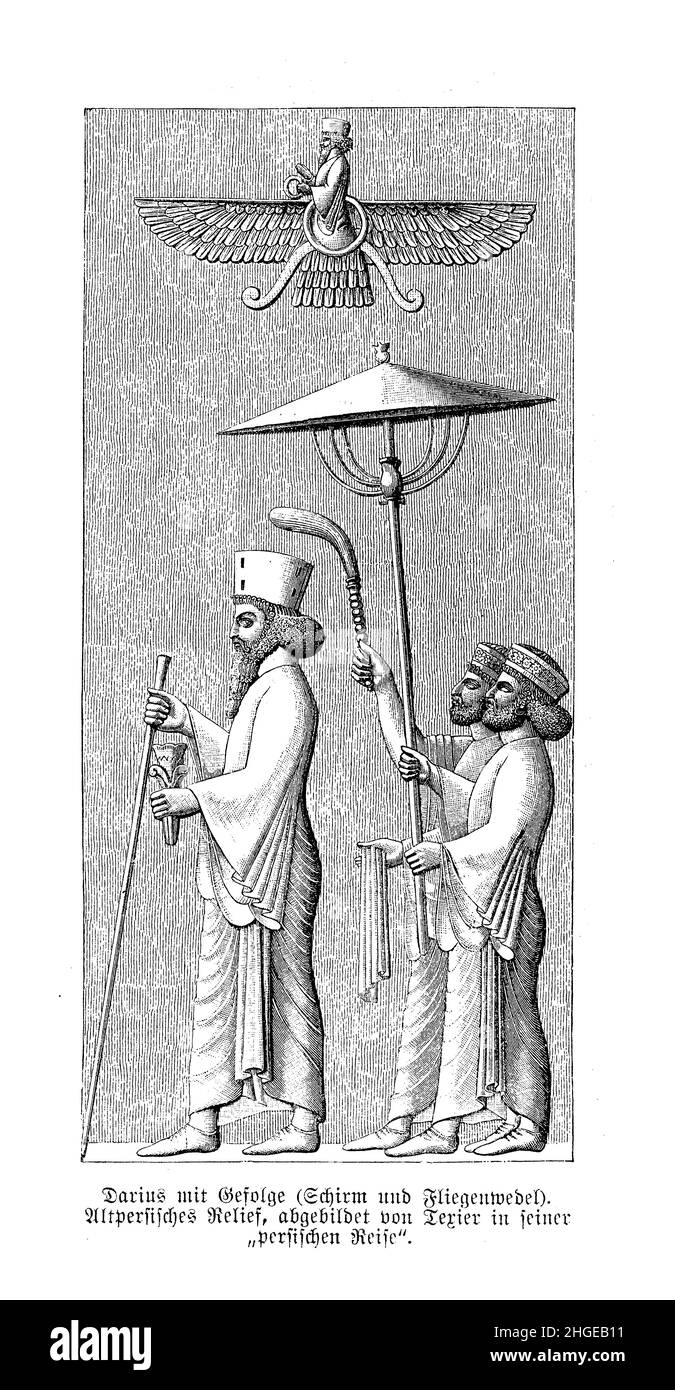 King Darius the Great followed by his cortege with parasol and fly whisk Stock Photohttps://www.alamy.com/image-license-details/?v=1https://www.alamy.com/king-darius-the-great-followed-by-his-cortege-with-parasol-and-fly-whisk-image457620045.html
King Darius the Great followed by his cortege with parasol and fly whisk Stock Photohttps://www.alamy.com/image-license-details/?v=1https://www.alamy.com/king-darius-the-great-followed-by-his-cortege-with-parasol-and-fly-whisk-image457620045.htmlRM2HGEB11–King Darius the Great followed by his cortege with parasol and fly whisk
 Bracket with a Cherub Holding a Fly Whisk M.89.159.3 Stock Photohttps://www.alamy.com/image-license-details/?v=1https://www.alamy.com/stock-photo-bracket-with-a-cherub-holding-a-fly-whisk-m891593-58312385.html
Bracket with a Cherub Holding a Fly Whisk M.89.159.3 Stock Photohttps://www.alamy.com/image-license-details/?v=1https://www.alamy.com/stock-photo-bracket-with-a-cherub-holding-a-fly-whisk-m891593-58312385.htmlRMDATA15–Bracket with a Cherub Holding a Fly Whisk M.89.159.3
 Ethiopia, 1970s, little girl with fly swatter portrait, Oromia region, East Africa, Stock Photohttps://www.alamy.com/image-license-details/?v=1https://www.alamy.com/ethiopia-1970s-little-girl-with-fly-swatter-portrait-oromia-region-east-africa-image502303265.html
Ethiopia, 1970s, little girl with fly swatter portrait, Oromia region, East Africa, Stock Photohttps://www.alamy.com/image-license-details/?v=1https://www.alamy.com/ethiopia-1970s-little-girl-with-fly-swatter-portrait-oromia-region-east-africa-image502303265.htmlRM2M55TX9–Ethiopia, 1970s, little girl with fly swatter portrait, Oromia region, East Africa,
 Bas-relief of a female divinity wearing a long pleated garment and holding a fly whisk, Lolei temple, Angkor, Cambodia Stock Photohttps://www.alamy.com/image-license-details/?v=1https://www.alamy.com/stock-photo-bas-relief-of-a-female-divinity-wearing-a-long-pleated-garment-and-52385501.html
Bas-relief of a female divinity wearing a long pleated garment and holding a fly whisk, Lolei temple, Angkor, Cambodia Stock Photohttps://www.alamy.com/image-license-details/?v=1https://www.alamy.com/stock-photo-bas-relief-of-a-female-divinity-wearing-a-long-pleated-garment-and-52385501.htmlRMD16A6N–Bas-relief of a female divinity wearing a long pleated garment and holding a fly whisk, Lolei temple, Angkor, Cambodia
RMPAJ959–Vishnu Accompanied by Lakshmi and Sarasvati. Culture: Bangladesh. Dimensions: H. 47 in. (119.4 cm); W. 25 in. (63.5 cm); D. 9 in. (22.9 cm). Date: 12th century. Vishnu stands in perfect symmetry (samapada), the protector of cosmic order. In an iconographic convention unique to medieval Bengal, he is accompanied by the goddesses Lakshmi, holding a fly-whisk (camara) and lotus (padma), and Sarasvati, playing a vina, rather than by his wives Sri Devi and Bhu Devi. He is also closely associated with Priti, the earth goddess, who often appears between his feet. The goddesses in turn are flanked by